|
|
Post by fozzie on Mar 1, 2007 17:29:21 GMT
Photobucket broke all the links to the wonderful pics but still very interesting. ++++++++++++ Someone,who shall remain nameless asked for a thread on Roses. Not me I hasten to add. So Rosefan and I got together. I will be looking at OLD ROSES and Rosefan will be looking at MODERN ROSES. If you have any comments on our posts please put them in the sister threads "COMMENTS QUESTIONS" Foz +++ Short History and some Interesting Facts (well I think they are) Cultivation probably started around 5000 years ago, I am sure early man enjoyed the Species roses before that. It started in China and Persia (modern day Iraq). The Greeks used them for decoration and anointing oil, even appears in Homers Iliad, that well know light read for insomniacs. The Rose used by them, the Greeks that is, was more than likely Rosa gallica also know as the ‘Apothecary’s Rose’ or ‘Red Damask’. It was the main source of rose oil and rose medicinal remedies in Europe until the introduction of some of the Species roses from the Far East. 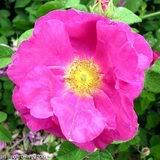   R.gallica The early Christian church in Rome condemned them as a symbol of depravity (are you now seeing why I like them so much), some 400 years later they change their minds (I’m saying nothing) and adopted Rosa alba as the symbol for the Virgin Mary. 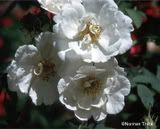  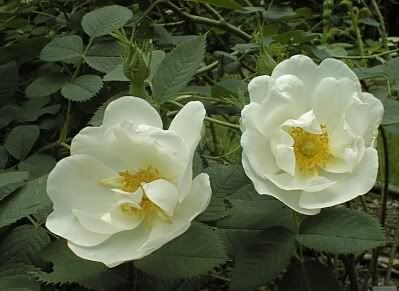 R.alba It is suggested that the Romans obsession with Rose contributed to the fall of the Roman Empire! Allegedly Nero used tons of petals at his banquets where pillows were stuffed with them for the guests to sit on. They were seen to symbolise success and millions of petals were used in headdresses and garlands. Consequently the peasant farmers believed it more profitable to grow Roses rather than corn, a disastrous misconception. It all goes a bit vague with regard to rose cultivation following the fall of Rome! Edward I in 1272 adapted a rose as his own symbol. The returning crusaders may well have introduced Rosa damascena also known as Autumn Damask. Certainly by the end of the 15th century it was growing in English gardens. It was the first flower in Europe to produce more than one flush of flowers each year, one in Summer and one in Autumn. Yes there is Summer Damask that only flowers once, but it has different parents. (No one said this was going to be easy!)   Summer Damask, Autumn Damask Whether it was the Romans or returning Crusaders who brought Rosa gallica to England is uncertain. It was, however the rose adopted by the house of Lancaster in their fight against the house of York (they chose Rosa alba). Henry VII combined both in Heraldic terms when he married Elizabeth of York. And the rose has been the emblem of the British royal family ever since. By the end of the 16th century Rosa foetida had been introduced into Europe from Persia. An important Rose in hybridising terms as she, along with the China roses, gave us the colour yellow to play with. It should be the last Rose you would want in your garden, as the price for yellow was black spot. (Hence yellow roses were always said to be more prone to black spot). 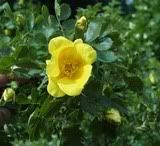 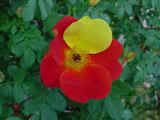 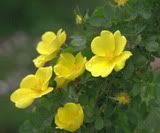 R.foetida The other significant introduction at about the same time was Rosa moschata (the Musk Rose). When the Mayflower left Plymouth she almost certainly carried some Roses in her holds because by the beginning on the 17th century many European Roses were growing in the gardens of Massachusetts. North America has only three indigenous species Rosa virginiana, Rosa Carolina and Rosa setigera. The Prairie Rose, which later was to produce some vigorous scramblers 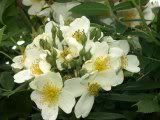  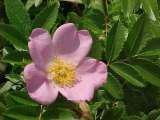  R.moschata, R.virginiana, R.carolina, R.setigera Hybridisation It was not until the 19th century that the process of hybridisation was starting to be understood. Up to that point all new roses were natural crosses or sports (mutations). The gardeners and nurserymen of the period grew these on to produce natural hybrids. Dutch breeders in 17th century were the leaders in early hybridising. During this period they developed Rosa centifolia or the Provence Rose or the cabbage rose because of its flowers of a 100 petals. The parents of R.centifolia have always been unclear and vague, although it is often quoted as Autumn Damask and R.alba. The Dutch continued to use R.centifolia for some time. The Moss Rose Group appeared during the 18th century as mutations from R.centifolia following this work. 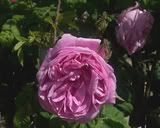  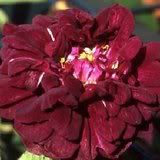 R.centifolia, Common Moss, Moss Nuits de Young Napoleons wife Josephine employed botanists and nurserymen from all over the world to discover and breed new roses for her gardens at Malmaison near Paris. Where she eventually had over 250 different varieties. If you visit you can still see a lot of them, although I’m not sure if in original planting scheme(s). Her actions gave a big boost to Rose breeding, from which we have never looked back. (Or in my case never looked forward!) Chinese influence The Chinese had been growing roses for thousands of years, some records are said to be as old as the 11th century BC. Some of these roses began to reach Europe in the late 18th century. Records show Rosa chinensis known as “Old Blush” being grown in both Holland and England at about 1780. Some years later a Mr Slater of Leytonstone imported into England a red form of he same rose found growing in Calcutta. It was subsequently named Rosa.semperflorens the ”Bengal Rose” or ”Slaters Crimson China” It is recognised that from these two we get the repeat flowering characteristic of our modern roses. 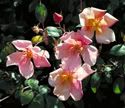 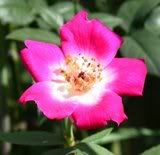 R.chinensis, R.semperflorens There were in fact 4 seminal or stud roses; in addition to R.chinensis, the others being Parsons’ Pink China, (aka Old Blush, confusing isn’t it), was introduced in 1793 by Joseph Banks, the Director of Kew Gardens, Hume’s Blush Tea-Scented China, aka R.odorata (it gets worse later) introduced by Sir A. Hume, (not our erstwhile PM!) and Park’s Yellow Tea-Scented China brought to the Royal Horticultural Society in 1824, having probably arrived from China in 1823. All the above are either the original species or hybrids (TEA Rose) from two species found in China, namely Rosa chinensis and Rosa gigantea, aka Rosa x odorata, the history around these early Chinese’s hybrids is confused and confusing. There is a school of thought that says R.odorata is, not only separate from R.gigantea but is in fact the original cross between R.chinensis and R.gigantea. Thus making it the original Tea Rose. (I think)(I hope you are keeping up). 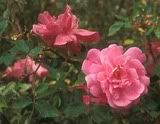 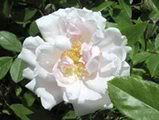    Parsons Pink, Hume’s Blush, Parks Yellow, R.gigantea, R x odorata At the beginning of the 19th century the flowers know as tea roses arrived on tea clippers, which probably accounts for their common name. But was it because they were tea clippers, or did the aroma on the tea infuse (sorry) into the plants? Yes, all right. I can hear you from here. I don’t care either. They became very popular in Europe for a long time. Many of them were quite tender, so the Victorians grew them in large green houses and conservatories. Some of this quality can still be found on some Hybrid Teas. The meeting of East and West From here on the dates parents and outcomes are open to debate as the number of crosses and backcrosses can be vague. These are the generally accepted chronology of events. The first East meets West was a cross between the Autumn Damask ( Rosa damascena) and a red China rose or some say Rosa gallica. The hybridising was carried out on the instruction of the second Duchess of Portland, a keen collector of roses. It is unlikely that the Duchess would have got dirt under her nails but instead would have left it to her gardeners. Hence, the confusion on parentage (you cannot trust us peasants to get the paperwork right.) The result either way was the Portland rose. Interestingly our cousins across the pond do not recognise this group. They call them either Hybrid Perpetual or Damask Perpetual. Something to do with Oregon! Anyway, these were very popular in the 1800 but very few survive today. They are good container plants with a good perfume and will repeat through out the summer.    Portlands Comte de Chambord, Duchess of Portland, Jacques Cartier In Charleston, of dance fame, South Carolina, a certain farmer, Mr. John Champneys, crossed Rosa moschata with Rosa chinensis. The later had been a gift from his friend a Mr Philippe Noisette, to whom he gave some of the resulting seedlings. He (Noisette) made more crosses and sent the plants and seedlings to brother Louis in Paris. The first seedlings were named “rosier de Philippe Noisette” As in most things French its too long winded and got shortened to Noisette hence the Noisette group of roses. ‘Blush Noisette’ is still widely grown today as is the beautiful ‘Mme Alfred Carriere’, one of the few climbing roses that will grow on a north-facing wall. So if you have ‘Mme Alfred Carriere’ you now know where it came from and that is was bred by the joint efforts of an American and a Frenchman. (They must have spoken to each other so I guess it was before NATO.) 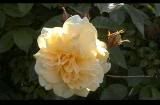 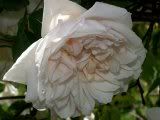 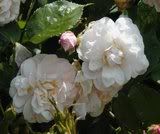 Noisettes Allister Stella Gray (Climber), Mme Alfred Carriere, Blush Noisette. There was another important cross that happened outside Europe, but once found was sent back for future development. Just to the east of Madagascar is the island of Reunion, an important French port prior to the Suez Canal being built. Both the Autumn Damask and Rosa chinensis. were grown on the island, often together in the form of hedges. A local French botanist observed an ‘intermediate’ between the two, which he moved to his botanic gardens and subsequently sent the seeds to France. At this time the name of the island was Ile de Bourbon. So we have the birth of the Bourbon Rose at circa1870.  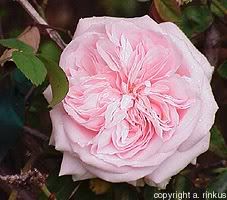 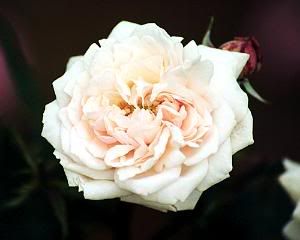 Bourbons; Zephirine Drouhin, Souvinir de la Malmaison, Comtess de Rocquigny Also at about this time a wild rambler Rosa multiflora was introduced into Europe from Japan, it was also found growing in China, which was probably its native country. In the hands of the 19th century breeders it became the parent of many of the Floribunda (cluster flowered) roses of today. 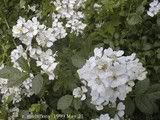 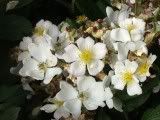  R.multiflora As the 1820's became the 1830's, interest was concentrated on the breeding between the Oriental roses and the Europeans. Due to the laws of genetics, the first progeny of crosses between once flowering and repeat flowering were once flowering. As they were crossed with each other, however, and then back to the Chinas and Teas, repeat-blooming hybrids began to appear. These were then further crossed with Autumn Damask. This activity carried on through the 1830s. The outcome of all these crosses came together in the 1840's into the group called " Hybrid Perpetuals", This group, taking in cultivars of all colours and forms, and at least somewhat re-blooming and hardy, overwhelmed almost all the other groups. Over a thousand Hybrid Perpetual roses were introduced. All in the search for the “perfect rosé”. However only a small sample of less than a hundred remain today. (As usual those that stand the test of time are the best)    Reine des Violettes, Yolanda, Black Prince. The birth of the Modern Rose era has been defined as post the Great War (14-18). As I’m sure your aware nothing is so simple! If by Modern Rose you mean Hybrid Tea (large flowered) Rose, the first one ( La France) was introduced in by Guillot in 1867. (So much for that line in the sand!) This new breed satisfied demands for neat, hardier repeat flowering plants. 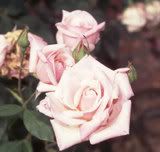 La France The majority of the 20th century growers and breeders have concentrated on developing the Hybrid Tea and F loribunda roses in colours shape and form, echoing latest fashion demands. Since the middle 1900s there has been a big increase in smaller plants for the small garden, patio and pots. But at about the same time, a new breed of Roses, reminiscent of those painted by the Dutch masters and Redoute, was being introduced by the English rose-grower D Austin. Sometimes they are referred to as perfect reproductions. Bringing all the beauty of Old roses onto more manageable sized plants. His initial cross was a gallica called Belle Isis and Dainty Maid a Floribunda the outcome was Constance Spry. He has continued in the same vein of “old” x ”new” ever since. (I think Josephine would have approved of the “English Roses”.) Future Postings The Rose family can be split into two parts OLD and NEW. We will split at say late 1800 about the time of “La France” I will be taking a canter through the OLD roses, under the heading “OLD ROSES” (original or what) to give an appreciation of the different types, classifications or groups, called them what you will. These will be the usual culprits; Species, Damask, Gallica, Alba, Centifolia, China and any others I find on the way. Rosefan will be doing the same with the NEW roses under the heading “MODERN ROSES” which will cover Hybrid Tea, Polyantha, Floribunda, Miniatures/patio, Climbers/Ramblers, Groundcover and Modern Shrubs. |
|
|
|
Post by fozzie on Mar 5, 2007 19:36:40 GMT
Part 2 Species Roses. (Wild Roses, as I like to call them, but I’m just an old romantic)There is significant disagreement over the actual number of true Rose Species, (now there’s a surprise!) Some species roses are so similar that they could be considered as variations on the same species; whereas other show such a big variation that they have to be different species. There is also a certain amount of naturally occurring crosses between species that tends to obscures the facts. The number of wild roses quoted can be anywhere from 150 to 250. I do not know which is the true figure so we will go for say… 200ish. This group is probably my favourite amongst them all. Their beauty is in their simplicity and it’s that simplicity that draws me to them. (Sorry, just me being sentimental again).Technical bitThe Family is Rosaceae The genus is Rosa and is split into 4 subgenera Hulthemosa (formally simplicifoliae meaning with single leaves) contains R.persica. 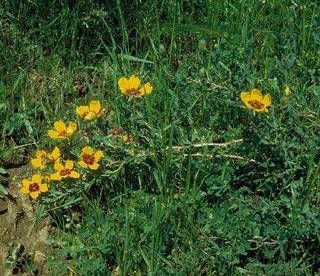 Hesperrhodos Hesperrhodos (from the Greek for "western rose") has two species, both from southwestern North America.These are R. minutifolia and R. stellata. 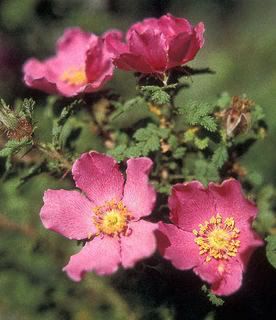 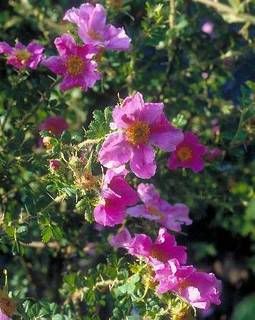 Platyrhodon Platyrhodon (from the Greek for "flaky rose", referring to flaky bark) with one species from east Asia, R. roxburghii. 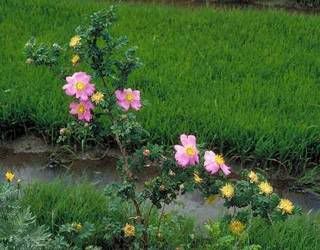 Rosa Rosa (the type subgenus) containing all the other roses. This subgenus is subdivided into sections. Banksianae - white and yellow roses from China. 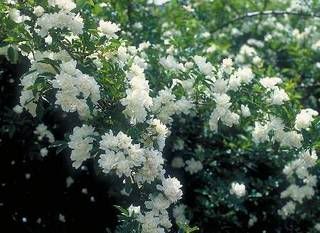 Bracteatae Bracteatae - three species, two from China and one from India 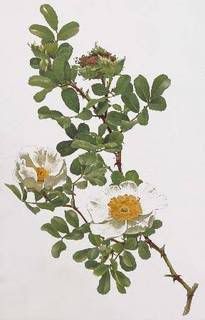 Caninae Caninae - pink and white species from Asia, Europe and North Africa 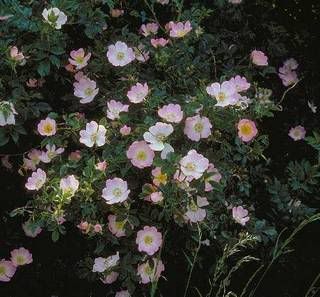 Carolinae Carolinae - white, pink, and bright pink species all from North America 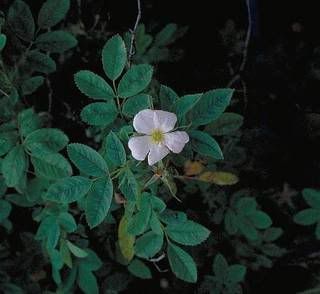 Chinensis Chinensis - white, pink, yellow, red and mixed-color roses from China and Burma 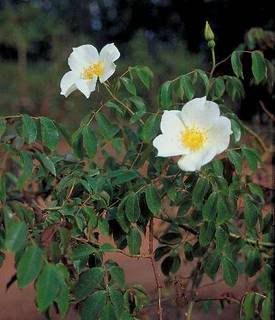 Gallicanae Gallicanae - pink to crimson and striped roses from western Asia and Europe 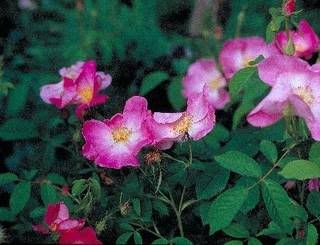 Laevigatae Laevigatae - a single white species from China  Pimpinellifoliae Pimpinellifoliae - white, pink, bright yellow, mauve and striped roses from Asia and Europe  Cinnamomeae Cinnamomeae - white, pink, lilac, mulberry and red roses from everywhere but North Africa 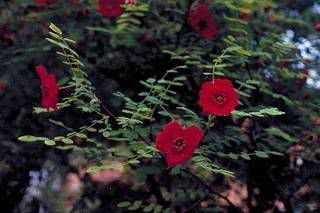 Synstylae Synstylae - white, pink, and crimson roses from all areas 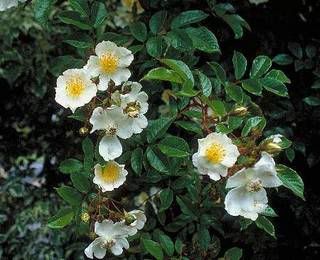 As in the number Species there is a constant debate over the above subsections more, less, different names and overlaps between them. OK enough of that technical stuff, it gets really boring if you go much deeper, so we will stick with what we have above. A Little History (And I mean a little)Fossils dated some 35 million years ago show that some wild roses did exist at that time. Those remains closely resemble R.nutkana and R.palustris. In more recent times, archaeologists discovered in the tombs of Egypt, wreaths made of flowers, among them, roses! The wreaths date to about AD 170, these are the oldest preserved record of a rose species still living. It is believed that the specimens are Rosa x richardii, also known as Rosa sancta. There are some examples in Crete at Knossos, of Frescoes dating to c. 1700BC, illustrating a rose with single, five-petalled pink blooms. The historical records of the genus Rosa are rich and many, illustrating that many ancient cultures valued these shrubs as we do now. It’s nice to know that the simplicity of the species appealed to our ancient ancestors all those thousands of years ago. ( As it does to me today!)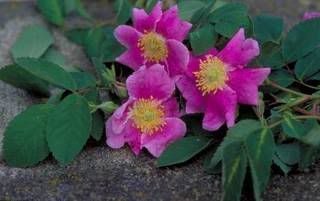 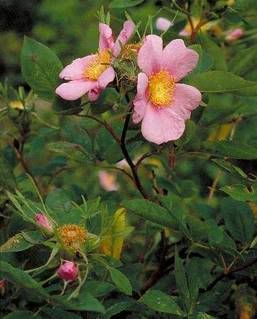 Where do they grow Where do they growIn global terms roses are found wild all around the northern hemisphere, from the Artic to South Africa, Thailand and New Mexico. They are unknown in the southern hemisphere. So, all those that have found there way their, have done so on the backs of animals and/or Man. The greatest diversity of species is to be found in China, as in so many other Flora genera. Representatives of seven different sections can be found, including two of my favourites R.moyesii and R.filipes[/i].(which I have in or near my garden).
Moyesii  Filipes Filipes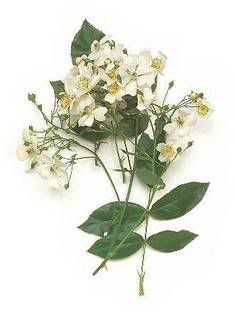
The species are also well represented in Cenral Asia and to a lesser degree in mainland Europe , UK and North America, We, in England, allegedly have some 14 wild roses considered to be native (I’m not convinced). And that is not including R.rugosa that seems to have made its home in the sand dunes around our coast. 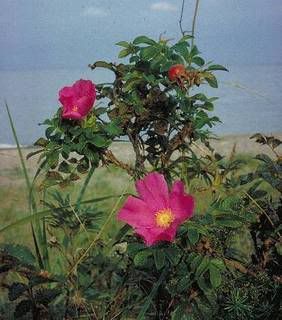
They will normally grow in any open environment from cliffs to river banks, valleys to mountain, even in the desert conditions. They only really survive in forested areas if the reach for the Sun and the two that do exactly that are R.gigantea and R.filipes. 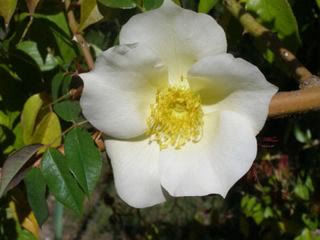 
(This is R.filipes Kiftsgate, a sport of R.filipes. it can get to upwards of 50 foot. Named after Kiftsgate Court Nr Hidcote Gardens ) 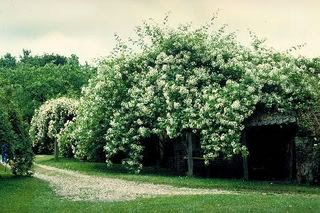 ( In full glory!) ( In full glory!)
Hardiness
They are found in almost all of the climatic regions of the northern hemisphere from the Artic to tropics. Most are hardy down to about –15c (+5F) and will tolorate hot summers. Some of the Chinese species are killed by -10C (+12F), one of them being R.gigantea, which played a big part in HT development. This is why some HTs appear to be less hardy than others. R.sempervirens is another, this was used in the development of ramblers and climbers. Again, this is why some of those will appear less hardy. Amongst the hardiest are R.rugose, R.wichuraiana and R.pimpinellifolia these have been used by breeders in North America to produce plants for the eastern America and Canada.
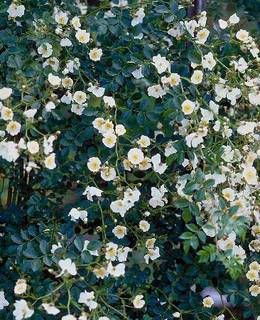 
General Description 
Species roses have perfumed flowers, aromatic foliage in both evergreen and autumn colours as well as a variety of colourful hips in interesting shapes, which can bring ornamental delight to the winter garden. Some make small bushes; others are huge ramblers. The more thorny or prickly varieties can look quite formidable but the thorns come in so many different sizes, shapes and colours they add their own interest. Flowers are borne singly or in clusters and most have only 5 petals, which ensure a look of simple, uncomplicated charm. One exception is R. sericea with only four petals. Most species roses are pink, yellow, red or white. The flowering period is usually short, as most other plants, in early summer but there are some that repeat in autumn. Leaflets can number from 3 to 15, be tiny or large, shiny or matt, hairy or smooth, green, bluish green, grey green, purple green, red green. The foliage can be rough to the touch or as light and delicate as a fern. Most species roses are extremely disease resistant and make an excellent addition to any garden, depending on space and layout/style of garden.
(I think every garden should have at least one. I have a few R.moschata, R.filipes, R.fedtschenkoana, R.canina, R.arvensis, R.moyesii, R.ecae, R.setigera and R.sericea subsp.omeiensis f.ptericantha, to give it its full name! So you can decide amongst yourselves who does not need to get one.) 
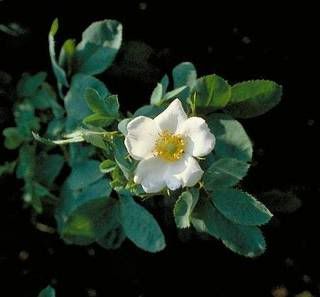 
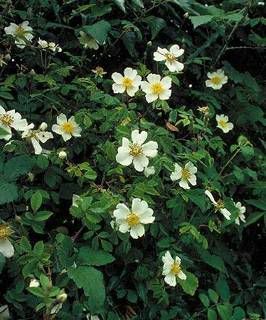
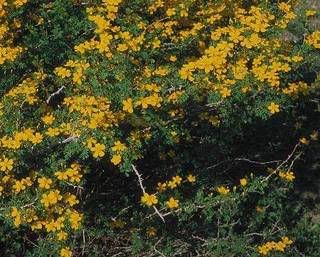 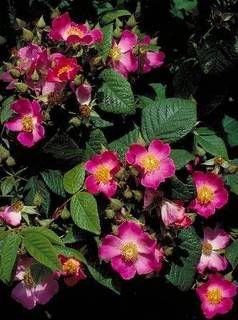 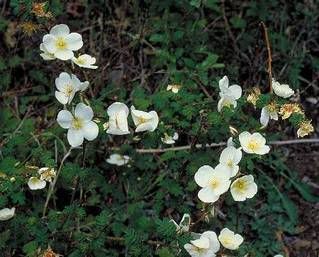 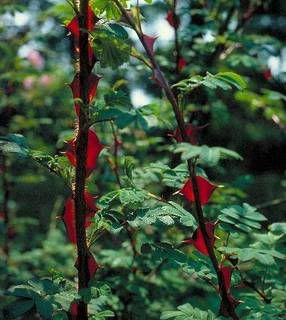
Hybrids 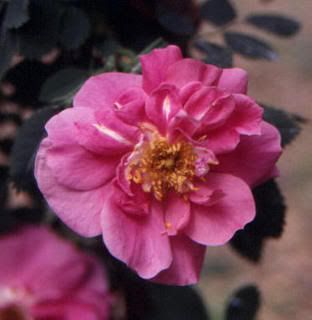 
As said above there are hybrids resulting from natural crosses, there are also numerous “contrived” hybrids resulting from intervention. Some cultivars of both routes have been classified as a unique species, and in the later case, even named after the breeder!
(I have no problem with natural hybrids, although, as for a separate species, it is sometime difficult to understand. However, how a group of people or person can be so pompous to believe that they have created a new species from roses that would not flower together let alone grow together is beyond me. Just call it as it is, a hybrid, it can be just a beautiful. If, whoever or whatever you believe in, wanted a species, the parents would be close enough to create one without outside “help”. Sorry on soapbox again.)
Pruning 
Most Old Roses and Wild Roses are best left to their own devices with minimal pruning. However check the plants in the spring, as some pruning may be beneficial. Remove the 3 Ds dead, diseased and damaged wood. Also cut back any shoots that cross and / or rub. Then, just tidy up the shape and size as required. On the whole Roses are very forgiving so you are unlikely to do any lasting damage
For what its worth, at planting time, I will hard prune all shoots down to six inches. For the next 1 or 2 years depending on vigour I reduce new growth by about a third. Then leave them alone, apart from the annual tidy/containment exercise in the spring.
Climbers are a little different, same process at planting time, then for next 2 years or so train them to where you want them to be (sounds Irish! but I’m sure you know what I mean), still apply the 3Ds prune regime. Remember to train as horizontal as possible, thus forcing side shoots along the length of the main stems. If you reduce these side shoots to 2 buds or approx 2 inches you will get flowers on the full length.
Once the frame is established, all that is require is the annual tidy/containment exercise. (a lot of books will say to do this in summer straight after flowering, you can, but I prefer the spring. At least then I can see what I’m doing and gives any replacement side shoots time to grow enough to allow me to tie them in. If you have a very vigorous grower then you may have to tie them in towardst end of summer.)
Some basic principles to bear in mind;
Pruning always stimulates new growth. To promote balanced growth, prune weaker wood hard and stronger wood lightly.
These Roses will generally flower on side shoots from last year’s growth. (So as long as you know that life is easy!, especially with climbers)
Planting 
I will not be so rude as to try and tell you how to plant a shrub; I will just make the following comments.
Most Roses these days are on a grafted rootstock. (Normally as a result of budding from a mother plant, this enables the grower/breeder to get them into the GCs and hence sold, quicker) It is always better if this graft union is below ground level say approx 2 inches.
Do not have this issue with Wild Roses seeds will normally come true! (Yes I know insects and things flitting from plant to plant but you can guard against them or “engineer” clean seeds)
If you are prepared to wait a little longer, then cuttings also come true and will have no rootstock. A good way of getting extra plants, particularly just after pruning! (I’m sure Rosefan will not mind me saying this but it works on ALL roses).
Anyway, container plants should be at the “correct” depth so just the normal plant at same depth as in container, if not just make sure graft union below ground. (I always add Blood Fish and Bone to planting hole.)
With bare root plants just do the same, make sure union below ground.
On climbers leave enough space from wall/fence to allow you to lean plant towards wall/fence.
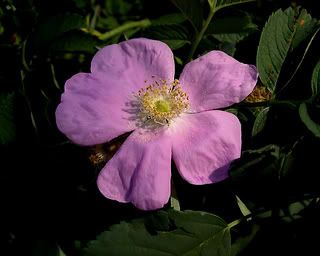 
The descendants of wild roses have found their way into the hearts of gardeners on every continent. These are the gallicas, damasks, albas, moss, centifolias, portlands, chinas, teas, bourbons, noisettes and hybrid perpetuals. Ands that’s where we will be off to next.
If you want to see more then click on wild roses
PS I am about to go on my annual spring retreat in preparation for vegetable activity in March/April so will be “missing” off the board for a bit
Foz
|
|
|
|
Post by fozzie on Apr 6, 2007 9:28:43 GMT
Part 3 The Chinas (including Chinas and hybrid Chinas)It is normal to go through the classes alphabetically i.e. start with Alba. However, the Chinas have possibly had the most influence in the Rose world, so I will start with them. It’s a bit long, I’m afraid; because of this it may be in two parts, if so, I will post both together. I do hope you don’t get bored. 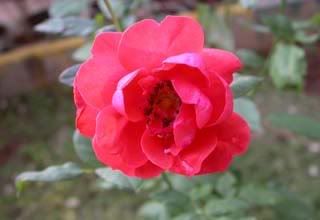  Rosa Indica (Bengal Rose)General Description Rosa Indica (Bengal Rose)General DescriptionDainty, repeat flowering shrubs of light, open habit with small, red or pink, single or loose double flowers. Some Chinas are low growing; some have tall canes and can be treated as climbers. Their small flowers usually change from light to dark; they're borne on short stems and have a distinct, light fragrance. Some are good as pot plants as they are small in stature: Slater's Crimson China and Cramoisi Supérieur are two examples. Others, like Archduke Charles, are effective in borders. Chinas are not fully hardy, zone 7 (-18 to-15C/0 to10F). ( a couple of definitions, which most of you will know. “Perpetual” flowering roses will flower, more or less continuously during the growing season. “Remontant” or “repeat flowering” roses usually have two crops, or flower intermittently towards autumn after the main crop, thses are not necessarily “perpetual”.)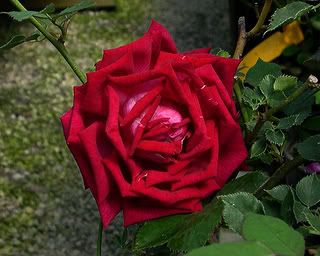 Cramoisi Supérieur Cramoisi Supérieur - Introduced in 1832 by Coquereau- small shrub (under 3'), fragrant, repeat flowering, seedling of Slaters Crimson China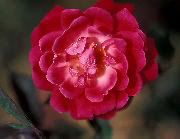 Slaters Crimson China Slaters Crimson China Introduced to Europe from Chinese gardens in 1792. 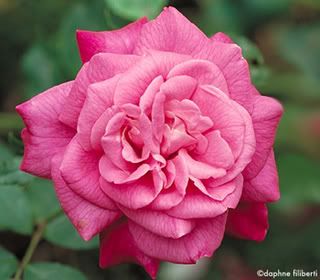 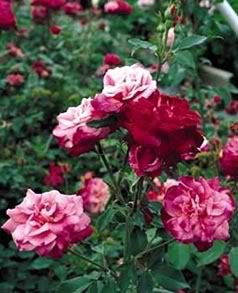 Archduke Charles Archduke Charles Hybrid China-Introduced in 1837 by Laffay medium shrub (3'-5'), fragrant, repeat flowering, thought to be a sport of ]b]Parsons Pink China[/b][/I] , named after the father of Franz Joseph. You may remember from the “short history” there were 4 “stud roses” from China, R.chinensis, Parsons’ Pink China, (aka Old Blush), Hume’s Blush Tea-Scented China, (aka R.odorata) and Park’s Yellow Tea-Scented China. Pictures of these were shown in the history but they are worth another look   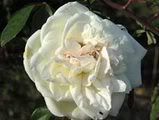 Parsons, Hume’s, Parks Parsons, Hume’s, Parks You may also remember, they are either the original species or hybrids (TEA Rose) from two species found in China, namely Rosa chinensis and Rosa gigantea (aka Rosa x odorata). (You will see references to several people, so I had better explain who they are, Dr Hurst, a genealogist who completed several studies on rose classification. Graham Thomas, a horticultural artist, author and garden designer. Became Garden Adviser to the National Trust and has written several books on the history and introduction of Roses. Peter Beales, a nurseryman specialising in Roses and has also written several books on Roses. Redoute is a botanical artist of some note, Krussmann author of several books on Roses and other plant groups) R.chinensis. Minima (aka Angel Rose, Rosa indica pumila, R. laurentiae, R.lawranceana, R. semperflorens minim.) R.chinensis. Minima (aka Angel Rose, Rosa indica pumila, R. laurentiae, R.lawranceana, R. semperflorens minim.) A small China shrub rose introduced around 1815, semi-double flowers, continuous flowering, little scent. Important rose in the beginnings of miniature roses. Recognised as a variety of R. chinensis it has a dwarf spreading habit. I said the history around these “stud roses” was confusing; we’ll look at each one individually and I’ll try and expand on the confusion. (If it gets too boring shout and I’ll stop, if it gets too confusing just look at the Roses! I’ll throw in as many as I can in no particular order).Many references to the 4 “stud roses” will include Slaters Crimson China (aka R.semperflorens or Bengal Rose) and not R.chinensis but, as you know by now, it’s a red sport of R.chinensis found in Calcutta! (Hence Bengal Rose. Just to confuse things the French started using “Bengale” when naming some of the progeny of their crosses This has been perpetuated by our cousins in the Americas where they have decided to have a separate class called Bengale, with no real evidence to uphold the claim, I’ll say no more) 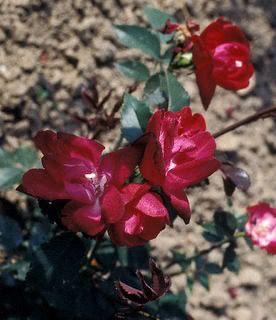 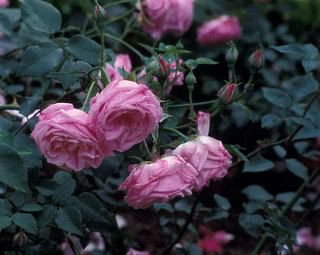 Bengale Pourpre Bengale Pourpre A China introduced by Vibert in 1827. A low-growing plant with single flowers of deep purplish crimson. Bengale d’Automne A China introduced by Laffay in 1825, medium shrub 5’, repeat flowering, slight fragrance. Then there is the claim that 3 ( Parsons, Hume’s, Parks), or maybe all, of the 4 studs, using Slaters Crimson China in place of R.chinensis, are in fact hybrids from the 2 species ( R.chinensis and R.gigantea.) Not just the typical “primary” hybrids as would be seen in a natural or breeding program, but “derivative*” hybrids, the results of many generations of incidental and intentional crossings in Chinese gardens. Such roses can still be found in China today and are quite similar to these stud roses. This leaves Slaters , which is a sport, as I said previously but a sport of what? I always use R.chinensis as the “parent”, and in place of Slaters , when referring to the “stud roses”. But this could be a mistake! An early botanical specimen of a Crimson China (‘Chineeshe Eglantier Roosen') of 1733 was later named Rosa chinensis in 1768. This rose was actually a cultivated variety and not the true species, as the name would suggest. The true species rose, which has changed our rose breeding so profoundly, is believed to be R.chinensis var. spontanea , collected and named by one Augustine Henry in 1885. ( Slaters would therefore be a sport from this plant?) It bears rich single pink flowers, which mature to deep crimson, and is described as being like a rambler. It can also display some variability in the wild (just as our native dog rose), being found as white, buff, yellow, pink and even red, and some varieties have a rich scent. (There you go, that’s cleared that up)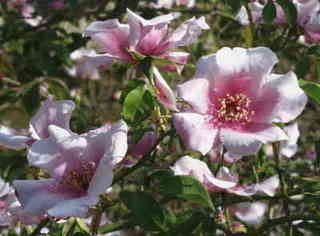 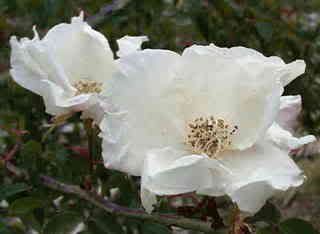 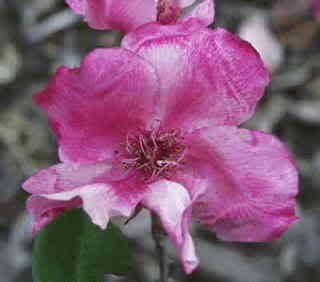 All three are R.chinensis var. spontanea An evergreen climber or large shrub up to 5m, but usually around 2.5m, Flowers solitary, or 2-3 together, opening pink or almost white, soon reddening. Native of western China Some of the variety of ChinasBoth of these are the same plant! It’s showing its China roots ( Sorry that’s awful!) by sometimes producing a single flower in hot summers. 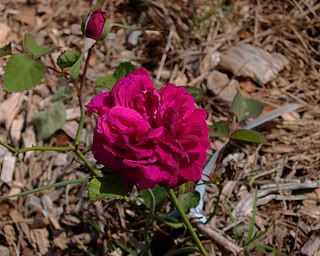 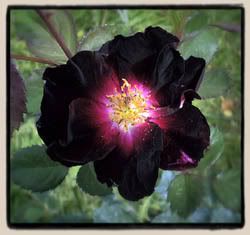 Eugene de Beauharnais Eugene de Beauharnais (Prince Eugene) (introduced by Hardy in 1838, ) 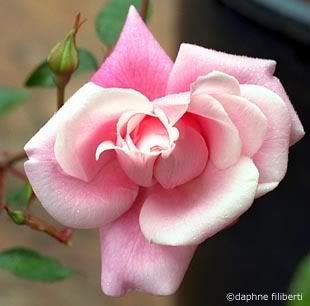 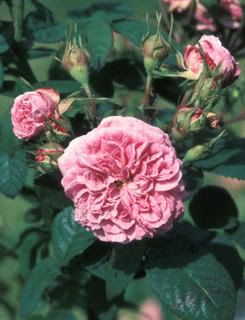 Both Chinas but very different the first is Le Vesuve, Hybrid China, pink blend - Introduced in 1825 by Laffay – small/medium sized shrub (3'-5'), fragrant, repeat flowering. The other is Juno a hybrid China Rose that looks more like a centifolia introduced by Laffay in 1847. Flowers light pink, large very double, repeat flowering. Parson’ Pink China (1793), (aka: 'Common China', 'Diversifolia' and 'Old Blush'). Generally accepted as being introduced by Joseph Banks, Director of Kew Gardens. Having been collected near Canton, by Sir George Staunton, an English diplomat to China, in 1792. But there are claims of introduction from a Mr Peter Osbeck of Sweden in 1751, a Captain Ekeberg (Sweden) in 1763 and a Mr Kerr (England) in 1780. It was propagated and sold under the name of Pale China Rose in England by James Colville, later it acquired the name Old Blush. Arrived in France circa 1798, where it became the subject of successful breeding efforts and a source of many hybrids. It would eventually give rise to a wide array of popular descendents, including Noisette roses, Tea roses, Hybrid Teas, and Hybrid Perpetuals. It is said to be closely related to its R.chinensis parent. However, there may be evidence that the China Rose was known in Italy long before the official European introduction dates. The National Gallery, in London, has a painting, circa 1529, which shows Cupid with hands full Pink Roses. The small rose-pink flowers with translucent petals, incurved stamens and reflex sepals are precisely those of the Pink China, so it could be conclude that this Rose was cultivated in Italy early in the sixteenth century. (The picture is a bit risqué, so I have not included it but click here cupid and see how long it takes you to spot cupid, let alone the roses!)There may be two varieties of Parsons Pink China. One variety is described as common; the other is noted as having more petals, a brighter colour, and a sweet scent (One of these may well be the Osbeck! but which?) 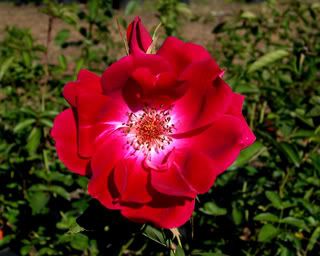 Gloire des Rosomanes Gloire des Rosomanes - Introduced in 1825 by Vibert China hybrid medium/large shrub (5'+), fragrant, repeat flowering. Hume’s Blush Tea-Scented ChinaIntroduced by Sir A. Hume from the British East India Company (then including China) in 1810. It was originally named R. indica odorata and later R. indica fragrans. It is closely related to its R.gigantea parent. Hurst estimates that its R.gigantea characteristics predominate by a 2:1 margin over those of its R.chinensis parentage. It is known for its large, elegant, pale pink flowers that continually bloom. 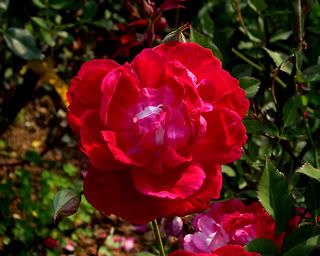 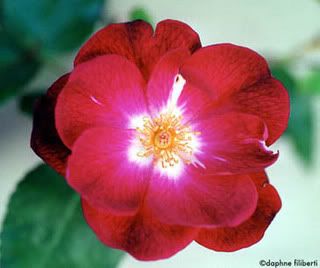  Sanguinea- Sanguinea- Introduced in 1824, small shrub (3’), slight fragrance, repeat flowering. Park’s Yellow Tea-Scented China Brought to the Royal Horticultural Society in 1824, having probably arrived from China in 1823. John Reeves, working for the East India Company at Canton, was most likely responsible for its import. It was given the name R. indica sulphurea in France, where it was quickly introduced. Like Hume’s China rose, it is influenced by its R.gigantea. parent, featuring large yellow flowers with thick tea-scented petals and bright green leaves. It was an important ancestor to many yellow Tea roses of the 1800s. 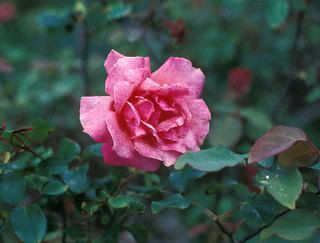 Beaute Inconstante Beaute Inconstante - Introduced in 1892 by Pernet-Ducher, deep pink small/medium sized shrub (3'-5'), fragrant, repeat flowering. Sometimes classed as Tea. Slater’s Crimson China (aka Rosa chinensis semperflorens or Bengal Rose)Imported by Gilbert Slater of Leytonstone in 1792, and by 1798 the French, who were the leading rose breeders at the time, had begun hybridisation experiments. Within a couple of years, it had been distributed to Austria, Germany and Italy. According to Hurst this plant has an extremely low fertility rate, based on this he argues for its status as an “engineered” hybrid, as opposed to a “sport”, only able to have survived and evolved in cultivation. (I’m not sure that we will ever get to the truth!) It also has variations, it is usually semi-double with two or three rows of petals, but has been known to bear single flowers; sometimes one may even be pink. (There is an example at the Gravereaux collection at La Roseraie de l'Haÿ, which it a short climber, bearing single cherry red blooms.) Most of the modern reds/crimsons will owe their colour to Slaters 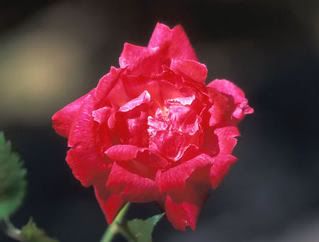 Serratipetala .aka (R.chinensis serratepetala, Rose Oeill de Saint Arquey) Serratipetala .aka (R.chinensis serratepetala, Rose Oeill de Saint Arquey) A rose with an interesting history. Introduced in 1832 by Antoine Jacques of Neuilly, France, it then disappeared commercially, to be rediscovered and re-introduced in 1912. Flowers of rose pink, once flowering, little scent, medium-size shrub. You may have noticed the R.indica cropping up all over the place above. There is not a little confusion around what is named Rosa indica. (it would translate as India Rose/Bengal Rose) Hurst noted that Peter Osbeck, a pupil of the Swedish botanist Linnaeus, discovered Rosa indica in 1750, while in Canton (India!). It is noted by Linnaeus that 'Blush Tea China' was his own specimen plant of Rosa indica. The single crimson China portrayed, as Rosa indica by Redouté is not Linnaeus' blush coloured rose. Rosa chinensis is alleged to be the same rose as Rosa indica; however, Graham Thomas and Dr. Hurst do not mention Redouté's version of Rosa indica as being Rosa chinensis[/b]. Krussman believes Redouté's rose is Rosa chinensis sanguinea, also known as Bengal Crimson. Graham Thomas is uncertain of this rose's origin. He believes that it is either a sport or a rose derived from an ancient hybrid of Rosa chinensis. Rosa chinensis sanguinea, Bengal Crimson, is a single China, whose colour varies from light to dark crimson. It does not display the same colour gradations that are found in either Rosa chinensis var. spontanea or Slater's Crimson. Redouté also painted a rose titled Rosa indica, La Bengale bichonne. Graham Thomas notes that this double rose may be Slater's Crimson China, also known as Rosa chinensis semperflorens, or Bengal Rose. It is generally recognized that Redouté's Rosa indica vulgaris, is in fact Parsons Pink China or Old Blush. Q E D (That’s it time for a large drink and a lay down)If that is all too much, don’t worry you are not alone, many people have been trying to unravel this for years. Dr Hurst died in the attempt! It doesn’t get much better with some of the other classes either A few more pics before we close part 1  Fortune's Five Coloured Tea Scented Rose Fortune's Five Coloured Tea Scented Rose - Hybrid China, white, Introduced in 1844 by Fortune, midsize shrub (3’-5’), slight fragrance, repeat flowering, good for a pot 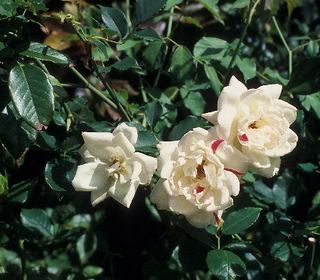 Smith Parish Smith Parish - a sport of Fortunes? Sometimes called a Tea, white small/medium shrub (3'-5'), fragrant, repeat flowering, striped.  R.viridiflora R.viridiflora -1743 the strange blooms are made up entirely of sepals rather than petals. (Thought to be a sport)
|
|
|
|
Post by fozzie on Apr 6, 2007 9:30:05 GMT
Chinas part 2 (I hope you are still with me.)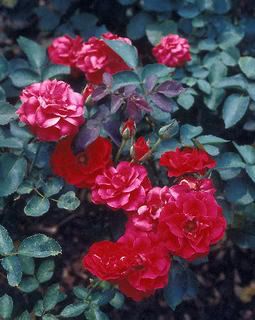 Alice Hoffmann Alice Hoffmann – introduced 1897 by Hoffmann. Red/pink, medium sized 4’ slight fragrance, repeat flowering. Impact of Chinas.The arrival of the China Rose changed the rose world profoundly. There were many changes that occurred following their introduction. The “perpetual” flowering characteristic, from early or mid-summer to late autumn (depending on the climate), of all our modern Roses is always attributed to a “recessive*” gene from the Chinas. Up until their introduction, the only cultivated roses with any repeat bloom were the Autumn Damasks. The increased productivity of bloom was greatly prized by both breeder and grower. As it still is today. 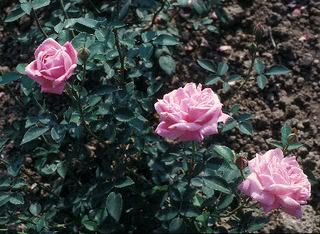 Bijou de Royal-les-Bains Bijou de Royal-les-Bains - seedling of Hermosa that tends to be striped or marbled, introduced by Veysset in 1891. They brought another dimension to the colour range in roses. The Chinas have a unique aspect of defying the colour principles commonplace with roses before their introduction. They have the unusual characteristic of darkening with age. (Unlike my hair) Most of the roses up until that time faded with age, a China rose may open yellow, and then blend to crimson through gradations of orange and pink. This is the case with R.chinensis Mutabilis. 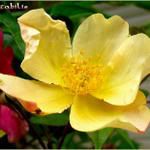   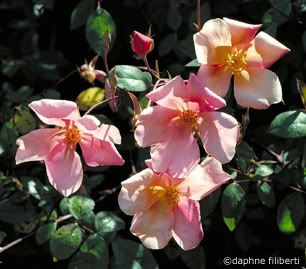  R.chinensis Mutabilis R.chinensis Mutabilis in its many guises! The blooms of 'Mutabilis', which are about 3" in diameter, have a distinctively delicate and silky appearance. The buds are flaming orange-yellow and the flowers open a pale yellow, but soon begin to change to shades of pink and finally crimson-pink. The effect when in full bloom is that of a bush covered with multi-coloured butterflies. Hence, the common name, 'The Butterfly Rose'. (Its aka Tipo Ideal and R.turkestancica). Not for the faint hearted, it’s the exception to the normal growing habit of Chinas, has been known to reach 10ft in both directions, but may only reach half that. (I can see your all eager to know. Mutabilis = Latin for changeable) The Chinas also broadened the colour range to include shades of yellow and a deep true crimson that were not known to European garden roses before that time. (“Red” roses prior to this time are thought to have been of deep or dark pink and not the true red of the China roses)They broadened the scents of roses. New blends became apparent when the Chinas were hybridised with other roses. Chinas are vaguely scented on their own. Some say they can detect a fragrance of nectarine in 'Old Blush'. It is also claimed that 'Old Blush' gave a pepper smell to some of its offspring; in others a fruity smell was heightened. They believe that 'Parson's Pink' and 'Slater's Crimson China' had little scent of their own. The mating with European fragrances produced a pronounced fruity bouquet, notably nectarine or raspberry that can be found in the Bourbons. I’m sure you don’t need me to say the fragrance of Hume’s Blush Tea-Scented China and Park’s Yellow Tea-Scented China. (The name’s a give away really.)They also brought a change to the form of the flower. The high centred exhibition rose owes its form to the Chinas, as do slender buds that unfurl when opening. 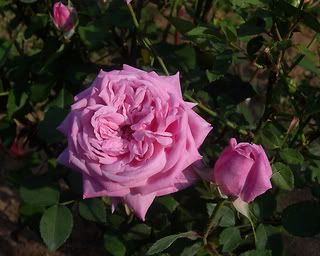 Hermosa Hermosa -Introduced in 1837 by Marcheseau - small shrub (under 3'), fragrant, repeat flowering good for a pot 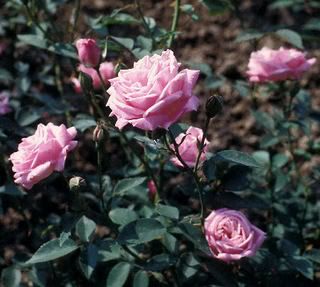 Setina Setina -Introduced in 1879 by Henderson - slight fragrance, repeat flowering climbing sport of Hermosa A little techy bit (recessive gene)*The original hybrid may or may not be “perpetual” flowering but when self-pollinated would show “perpetual” flowering properties as a result of a recessive gene. This is characteristic of a second generation that has been bred by self-fertilization, recessive traits become evident through genetic recombination. The recessive gene found in Chinas was that of “perpetual” flowering. 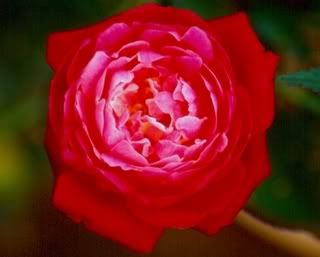 Louis Phillipe de Angers Louis Phillipe de Angers – introduced by Guérin in Angers in 1834. Flowers double, deep red, small shrub (under 3'), fragrant, repeat flowering.  Souvinir d’Aimee Souvinir d’Aimee - raised by Veuve Schwartz in 1897. Flowers fully double, creamy white to coppery pink or orange. Seedling of Mme Laurette Messimy.Groups that arose from China Roses Noisette and Bourbon roses were among the first marketable products from work with the China roses, appearing in the early 1800s. Tea rose of the 1800s was originally described as the species R. gigantea, yet was always known to be a hybrid product of the Noisette/Bourbon lines combined with one of the two Tea-scented stud roses. Portland Rose (Lady Portland remember?) Hybrid China (Normally come under the heading Chinas) roses started to appear around 1815 as a product of the China/Noisette/Bourbon roses crossed with various summer-flowering varieties, in particular the R. gallica and Damask varieties. Though all Hybrid Chinas were strictly summer-flowering, many popular varieties were developed, and by 1830 several superior cultivars appeared which, through crosses to Portland/Noisette/Bourbon lines, become the parents of the Hybrid Perpetuals. These latter were distinguishable from their parents in that they were bred for continuous flowering. Hybrid Tea roses followed next from crosses between Hybrid Perpetuals and the Tea roses, appearing first in 1867. The Pernet Rose the product of a specific cross between a Hybrid Perpetual and a variety of R. foetida (aka R. lutea ), the Austrian Briar Rose.. The Poly-Pompon or Polyantha roses I’ll give you an example of how “easy” it is to understand Rose development and the influence of Chinas 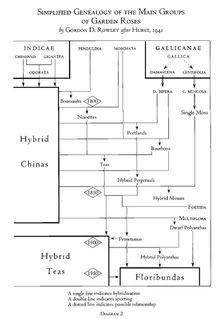 A simple diagram, (ho! ho!) representing the impact of the of the China stud roses, as in the introduction of the classes listed above. All the interbreeding, backcrossing, using dissimilar parents, and even the combining of more than two groups in the creation of new varieties have rendered the traditional family tree impractical, hence this confused schema Any traceable lineages have been blurred or corrupted. All this hybridising has also resulting in the loss of previously recognisable group distinctions. (It makes you wonder why anyone would want to try and sort it all out!) 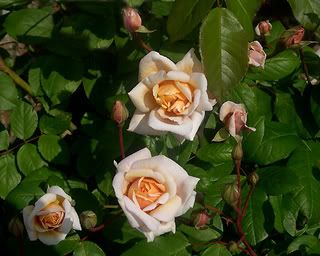 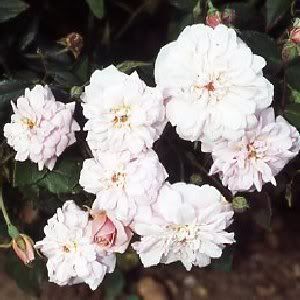 Perle d’Or, Cecile Brunner Perle d’Or, Cecile BrunnerThese two you may have already seen in Rosefans Polyantha section, but they are also classified, by some, as Chinas.  Anne Marie de Montravel Anne Marie de Montravel - Phillipe Rambaux in 1879. Full, pure white smaller, flowers in clusters with a strong scent, low sprawling dense growth, strong repeat flowering. (Also classed as Polyantha)  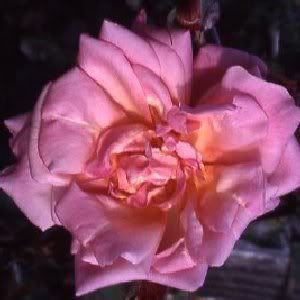 Mme Laurette Messimy Mme Laurette Messimy - raised by Guillot and Son in 1887. Flowers yellow, with pink and red shading, small shrub 3’, continuous flowering, slight scent PruningThis will be the same for all classes of Shrub Roses, so by the end of this you will be word perfect! (There may be some class specific info, which I’ll add at the time.) Shrub Roses will continue to flower well even without pruning, but will end up as large and maybe congested shrubs. The main objective of pruning therefore, is to prevent the shrub from becoming too large or congested. The pruning should always be modified to suit the growth characteristics of the plant, but as a guide, shorten the main stem by about a third and any remaining side shoots by about 2 thirds. Cut out completely any dead, diseased or crossing stems. Always keeping an eye on the overall shape of the shrub. The frequency is up to you and how you want to grow the shrub. For example, if completed annually, you will encourage new growth from the base, keep it compact and have flowers close to the ground. Some of the breeders of the time Laffay – France 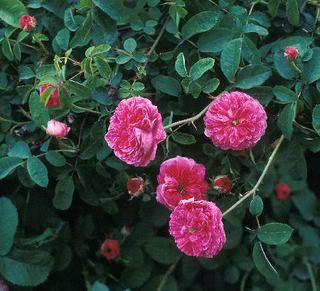 Darius Darius – 1827, medium shrub 5’, slight scent, single flowering 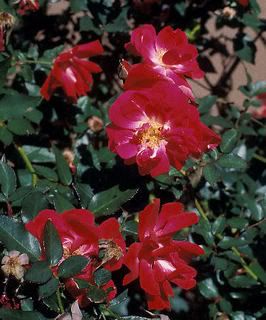 Fabvier Fabvier – 1832, medium shrub 5’, continuous flowering 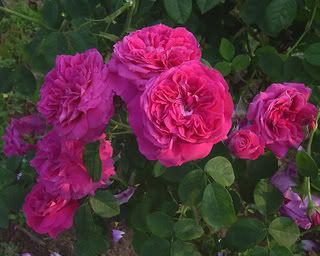 Brennus Brennus Introduced in 1836. medium/ large shrub (5’+), fragrant, repeat flowering. 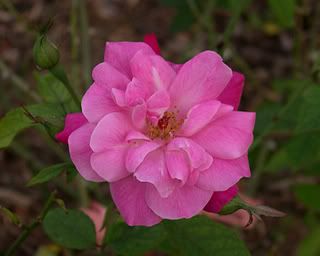 Napoleon Napoleon introduced in 1835, small shrub (under 3'), slight fragrance, repeat flowering. Jean-Pierre Vibert – France  Belmont Belmont Hybrid China introduced in 1846, small shrub (under 3'), fragrant, repeat flowering Buatios – France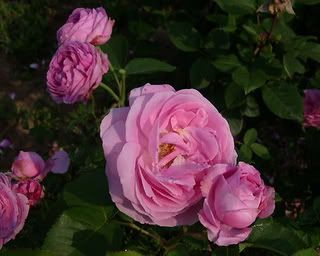 L’ouche L’ouche raised in 1901. Flowers pale pink, shaded with yellow, on a bushy plant. The river Ouche, which flows through Dijon, is a tributary of the Saone Blair – England (Not our PM. I’ll refrain from any comparison, regarding imagination, as I voted for one of his cohorts, but how hard is it to name something).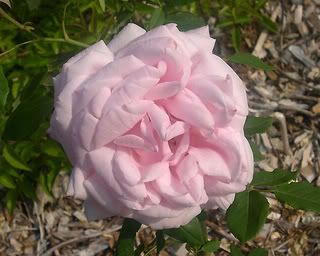 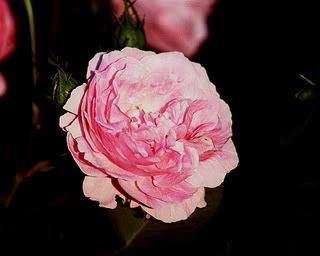 Blairii No1 Blairii No1 – 1845 moderate climber (10’-15’), Parks’ Yellow Tea-scented China × Unknown Blairii No 2 - 1845 large shrub/small climber, Parks' Yellow Tea-scented China × Unknown Jean Claude Ducher – France 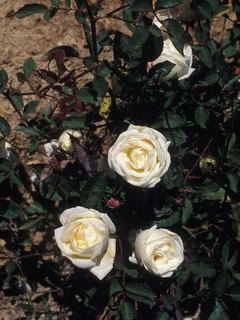  Bengale Ducher Bengale Ducher – 1869,small shrub (under 3'), fragrant, repeat flowering. Dubreuil – France 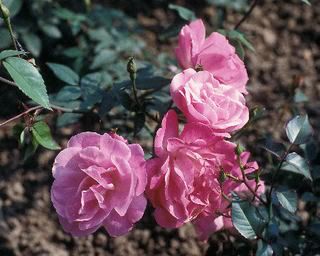 Bebe Fleuri Bebe Fleuri –1906, medium shrub, repeat flowering 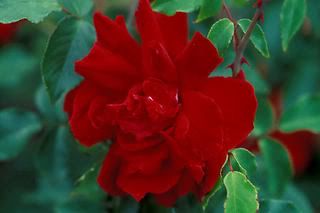 Princesse de Sagan Princesse de Sagan – 1887. The double, shapely flowers are deep cherry red with maroon shading, scented, repeat flowering. medium sized to 5’ Felberg-Leclerk – Germany 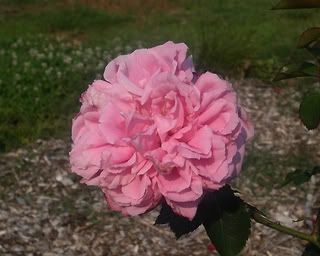 Hofgartner Kalb Hofgartner Kalb - 1913 small shrub (under 3'), slight fragrance, repeat flowering. Pierre Guillot. – France (Son of J B Guillot of La France fame) 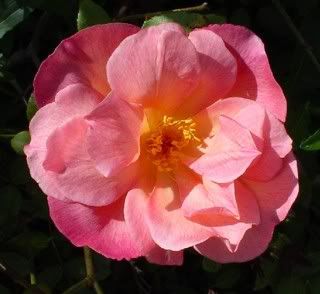 Comptesse du Coyla Comptesse du Coyla –Hybrid China - Introduced in 1902, small shrub (under 3'), fragrant, repeat flowering.  Irene Watts Irene Watts - 1895, fully double, repeat flowering. The colour varies from Salmon to pale pink or white tinted with pink. A low plant rarely reaching more than 60cm (2ft), so ideal for the front of a border or container, a seedling of 'Mme Laurette Messimy' , itself a seedling, can be seen at Mottisfont Garden Hampshire. Paul –England 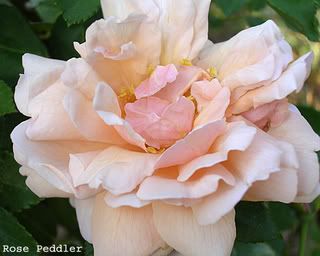 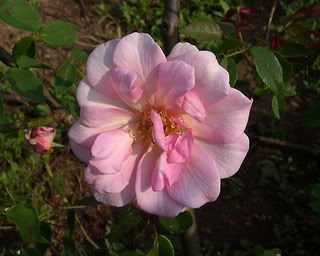 Arethusa (sounds like Aretha, Franklin that is, another one of my favourites) Arethusa (sounds like Aretha, Franklin that is, another one of my favourites) - 1903 small shrub (under 3'), fragrant, repeat flowering. Duke of York – 1895 medium/large shrub (5’+), slight fragrance, repeat Flowering. Thank you if your still here! |
|
|
|
Post by fozzie on May 26, 2007 18:39:01 GMT
PART 4
THE GALLICA ROSES (The RED ROSES)  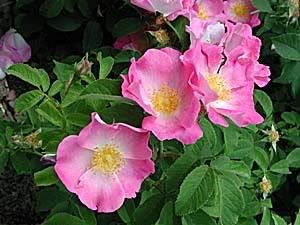 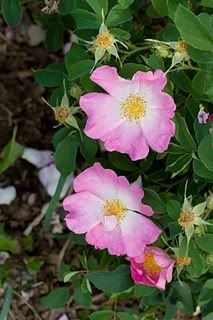 These are not only the, most ancient, the most famous and the best garden plants amongst the Old Roses. They are also, in part, the ancestors of most other Old Roses. Their legacy, to use that current “in” phrase, is their good fragrance, which is carried through to their descendants The Gallica roses are descended from Rosa gallica. Rosa gallica is distributed in a wild state through central and southern Europe, reaching eastward to the Caucasus. Although it hybridises freely and has given rise to many wild as well as garden forms, it is an exceedingly well-marked species, and its dominant characters are transmitted in a greater or lesser degree to all the hybrids. The species is now normally represented by R.gallica var officinalis, which is a “sport” of R.gallica. It was introduced pre 1300 by person or persons unknown.  R.gallica var officinalis R.gallica var officinalis Two other natural hybrids 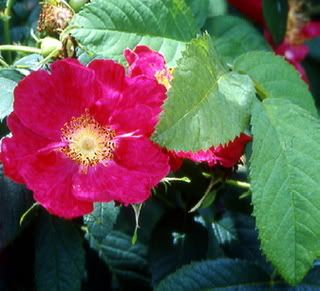 R.x francofurtana R.x francofurtana also known as the Frankfort Rose and 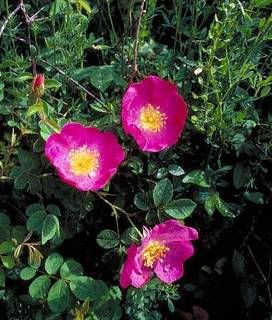 R.gallica var Pumila R.gallica var Pumila also known as the Dwarf Red Rose General Description The official description of Rosa Gallica is as follows; Stem; short, stiffly erect. Prickles; unequal, scattered, straight, slender. Leaflets; 5-7, oblong, subacutate or cuspidate, middle-sized, simply toothed, subcoriaceous, raised veins beneath petioles; pubescent and slightly glandular; stipules; adnate, with slightly ciliated ovate free tips. Flowers; 1-3, fragrant, peduncles; densely glandular and aciculate. Calyx-tube; globose, sciculate; lobes glandular on the back, the outer pinnatifid. Petals; dark red, about an inch long in the wild plant. Styles; villous, free, not protruded beyond the disc. Fruit; subglobose, dark red, persistent; sepals; reflexing. Deciduous. (I think this refers to “officinalis” rather than the pure Species) 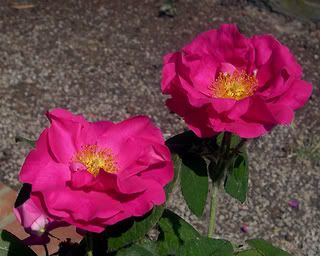 Another look at R.gallica var officinalis To put that in English for the Group as a whole; Gallica Roses produce a short compact shrub approximately 3-4 foot high, with some exceptions. Straight erect stems with very few prickles, they also have a lot of harmless tiny “bristles” on the stems. The leaves, held on leaflets of 5-7, are hoary below, and smooth, mid to dark green above. The flower buds are round and small. The flowers are large in proportion, generally solitary, rarely exceeding three, per flowering stem and very fragrant. These characters make the gallica Roses easy to recognise. You’ll notice no mention of flower colour. This is because the range covers all the pinks, mauves, purples and light crimsons that you can imagine. There are also a good few striped sports about. Gallicas are very prone to “suckering”, especially if on own roots. Meaning that they will quickly produce a thicket covering several feet, if left to their own devices. So it is probably best to grow grafted shrubs. They are tolerant of most soil conditions, thriving in sandy, chalky and shaley/stony soils. But like most plants will perform at their best in a good soil. They are hardy down to Zone 4 –29C (-20F) to –34C(-30F). Generally disease free, but may get a touch of Mildew in cool damp weather conditions, but it is only cosmetic and will do the plant no harm. As with most Roses the weather, in particular the temperature, will play a big part in the flowering season and colouration. The warmer the climate the longer the flowering season and more variations in colour from light to dark. A couple of the early hybrids  R.gallica “Tuscany” R.gallica “Tuscany” (aka The Old Velvet Rose) 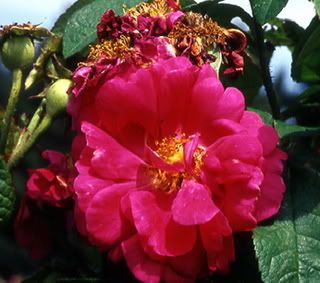 R.gallica “Conditorum” A Little Bit of History R.gallica “Conditorum” A Little Bit of History The detailed history of the Red Rose is, thankfully, some say, lost in the annuls of time. (Like you I’m gutted!) It is said to be the Red Rose of the Persian Magi (12 century BC), who cultivated it for religious ceremonies. In the fourth and third centuries BC it was allegedly cultivated by the Greeks and also in Asia Minor from where it was imported by the Romans in the first century AD. In the 6 century AD it appears in as the Dwarf Red Rose in religious documents in Constantinople. This particular appearance has been classified as Rosa Pumila or R.gallica var Pumila . In the 1100s the Moors in Spain cultivated it after reportedly being imported, some 500 years earlier from Persia. As usual some debate regarding the naming of the species. In 1757 it was classified Rosa rubra by one, Mrs E Blackwood. This was thrown out on a nomenclature technicality, even too boring, for me to get excited about. It was then classified, in 1759, as Rosa gallica by Linnaeus. It should be noted that “Red” as applied to Old Roses is a comparative term, all dark pink roses, before the arrival of Slaters Crimson China , were called red.  R.gallica var Pumila R.gallica var Pumila The history of these crosses is sparse but they are believed to solely gallica crosses 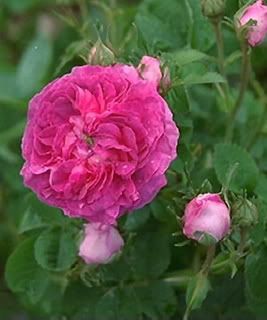 R.gallica ‘Belle deCrecy’ R.gallica ‘Belle deCrecy’ Introduced by Hardy 1829, allegedly raised by Roeser at Mme Pompadours’ chateau at Crecy (?) date unknown 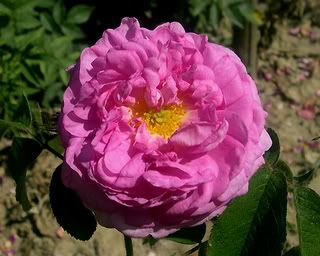 R.gallica ‘Gloire de France’ R.gallica ‘Gloire de France’ Introduced Vibert 1819 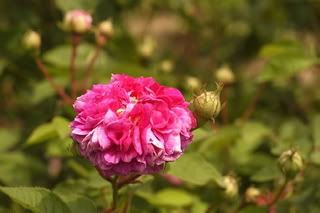 R.gallica ‘du Maitre d’Ecole’ R.gallica ‘du Maitre d’Ecole’ Introduced Coquereau 1831 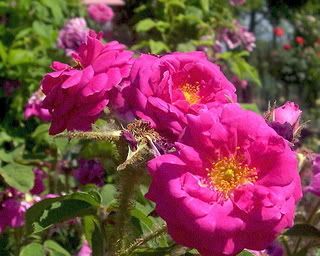 R.gallica ‘Duc de Guiche’ R.gallica ‘Duc de Guiche’ Introduced Prevost 1835 R.gallica is often called The Apothecary’s Rose or Provins Rose. Strictly speaking this only applies to a certain variation of R.gallica known as R.gallica var officinalis. In the 13th century the town of Provins, SE of Paris, became the centre of a chemical industry, which persisted for around 600 years. This industry was based upon the aforementioned variety of R.gallica. It was discovered that this variety was capable of retaining the perfume of its petals even when dried and crushed to a powder. The apothecaries of the time developed this discovery by making conserves and confection of the Roses in many forms and shipping them all over the World. The industry reached its peak in the 1600’s, by which time many thousands of cloned Red Roses were growing in and around Provins to support the industry and its attendant Apothecaries. Hence the synonyms! We in England called it the Red Damask Rose, as we believed it came from Syria, crusaders and all that. Even though it may have come from Syria it is a gallica rose. During the civil wars in the 15th century, the apothecary's rose was adopted as the red rose symbol for the House of Lancaster. Although not cultivated in such great quantity today, and it is now regarded primarily as an ornamental, garden plant, its fragrant petals are still popular for potpourri and are also used in the preparation of modern cosmetics and perfumes. (This may not come as a surprise, I have one)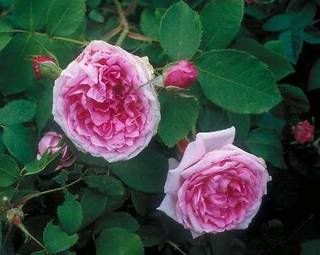 R.gallica ‘Agathe Incarnata’ R.gallica ‘Agathe Incarnata’ Vibert 1815 has Damask influence. 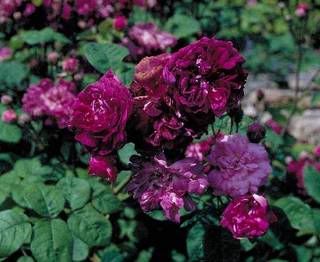 R.gallica ‘Cardinal de Richelieu’ R.gallica ‘Cardinal de Richelieu’ Introduced by Laffay 1840, some say bred by Van Sian in Holland others say Parmentier in Belgium 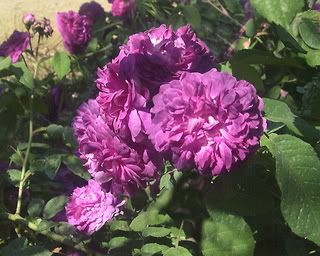 R.gallica ‘Hippolyte’ R.gallica ‘Hippolyte’ No information At some time in its history, date unknown, the Provins Rose had a “bud sport” (somatic mutation) – interesting, but not for here, you geneticists out there will know all about them. This sport became the much loved, but not by me, Rosa Mundi. Legend has it that the rose is associated with the Fair Rosamond of Henry II fame. Given that she died circa 1176, it must have been an earlier crusader who found it in a garden in Syria and named it after her before giving her the rose.   R.gallica var ‘Variegate’ R.gallica var ‘Variegate’ aka ‘Versicolor’ or ‘Rosa Mundi’ Like ’Maidens Blush’ this favourite Old Rose is found in many old gardens. She is often confused with ‘York and Lancaster’, which is a Damask and looks nothing like it! Also included in the Gallica group is something called The Frankfort Rose (aka R.turbinate, R.francofurtana) Its deemed to be a natural hybrid between R.gallica and R.cinnamomea It is practically prickle less with smooth gray green stems. The leaves are grey and wrinkled by its veins, a la Hornbeam and Elm. The flowers have a papery quality are pink flushed with lilac and purple and are veined all over with a deeper tone. It produces a small compact shrub reaching 3-4 foot high. Here you have the natural hybrid (again) plus two hybrids produced using it as a parent, they may be ‘sports’ no one seems to know   R.gallica ‘agatha’ R.gallica ‘agatha’ Details unknown but circa 1750s aka ‘Pope Pius IX’ or even ‘The Frankfort Rose’ 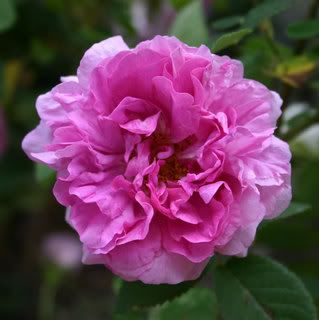 R.gallica ‘Empress Josephine’ R.gallica ‘Empress Josephine’ Again no reliable information but is also sometimes called ‘The Frankfort Rose’. Both Josephine and Agatha will reach up to 6 foot while the hybrid type will only get to 3-4 feet. If the wild hybrids are numerous, the garden varieties are even more so. It would appear that the pioneers of Rose-raising from seed were the Dutch nurserymen, who seem to have been the first to engage in it to any large extent. I can only assume that it was their success with tulips, hyacinths, and other flowers from seed, which caused them to turn their attention to Roses. Their first experiments were with the Gallicas , if you look at catalogues of around that period they would show the great number of Gallica hybrids raised and named by them at Haarlem, during the first half of the eighteenth century. Up to that time the number of varieties grown in the old gardens was very limited. Most of these early cultivars were, in breeding terms, unsophisticated varieties. Sorry Dutchy! (In my terms they were good for their simplicity) It was not until the French got involved, that the breeders potential was realised, even more so when other groups were used to influence the resulting hybrids. (Most, if not all, of the purplish varieties listed under R.centifolia will owe their colouring to R.gallica.)Some of the “Royals!” 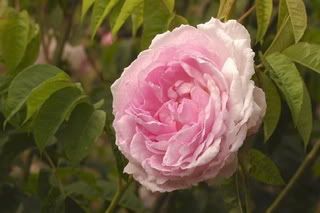 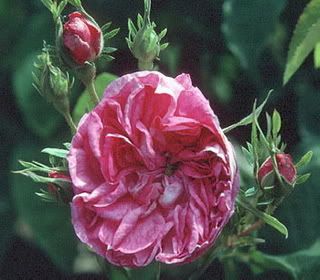 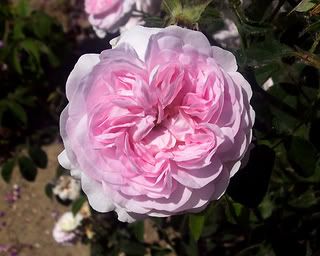 The three Lady’s are the Duchesses of d’Angouleme, de Buccleugh and de Montebello 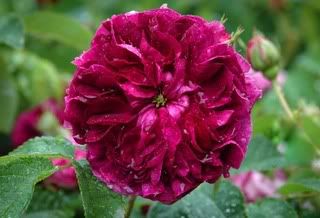 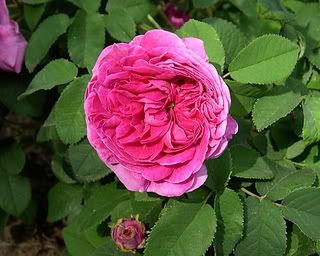 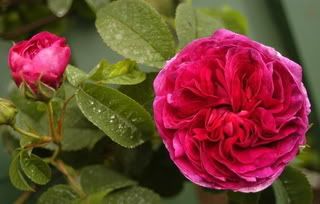 They are all R.gallica ‘Charles de Mills’ Breeder unknown believed to be Dutch, introduced circa 1790. aka ’Bizarre Triomphant’ Said to be the quintessential gallica, the shape of the flower is unique, they are full petalled and when partly open appear to have been sliced through at the bud. The range of colours above can be seen on a single plant at any one time A couple more Belles of the Ball, in addition to ‘Belle de Crecy above. 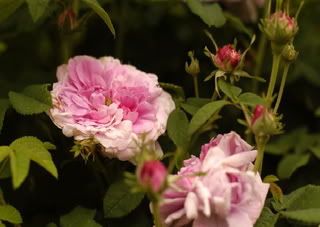 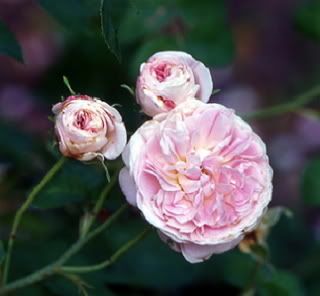 These two “Belles” are ‘Virginie’, and ‘Isis’ No details on Virginie, Now Isis is interesting, raised by Parmentier 1845, and used by one D Austin, as seed parent, to produce his first commercial Rose ’Constance Spry’ in 1960 Pruning Shrub Roses will continue to flower well even without pruning, but will end up as large and maybe congested shrubs. The main objective of pruning therefore, is to prevent the shrub from becoming too large or congested. The pruning should always be modified to suit the growth characteristics of the plant, but as a guide, shorten the main stem by about a third and any remaining side shoots by about 2 thirds. Cut out completely any dead, diseased or crossing stems. Always keeping an eye on the overall shape of the shrub. The frequency is up to you and how you want to grow the shrub. For example, if completed annually, you will encourage new growth from the base, keep it compact and have flowers close to the ground. I said earlier that the above would apply to all shrub roses, that it is still true. If I add this next paragraph, it may help to understand the principles: The natural growth pattern of the plant, when established, is to produce strong, shoots from near the base, which grow up in late summer. It is these that produce the foundation of the shrub/bush. In the spring they will produce side shoots up to a foot long, which will bear the best blooms. The following spring these side shoots will produce shorter, weaker flowering side shoots. This cycle is repeated annually until the branch/stem dies. Gallica specific, alternative, (optional) Alternative - Remove the flowering wood in July, after the flowers have finished. This will encourage better growth for next year, BUT NO HIPS for current year. Gallicas are useful and well suited as hedging plants. If grown as a hedge, then clip them annually in say January/February, using shears or hedge trimmer. The result will be the formation of many short flowering stems of uniform length, hopefully, each producing from one – four flowers. A few more…  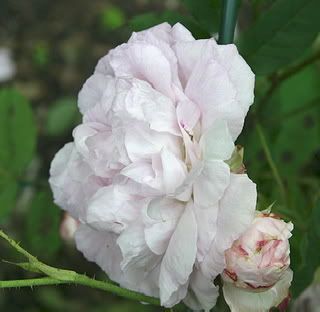 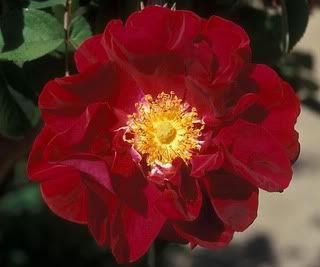 ’Anais Seglas’ ’Anais Seglas’ Vibert 1837 ’Atonia d’Ormois’ Vibert 1835. ’James Mason’ Beales 1982 I have tried to give you a flavour of the Gallicas with the pictures spread throughout the above, working from the early hybrids through to the French plants men and even a very modern one! But the choice was legion so I have added an extra page for some of the best, not of my choosing, but that of others notably G S Thomas perhaps because he liked them, and P Beales perhaps because he sells them! There are some I like and others… well, in time maybe!  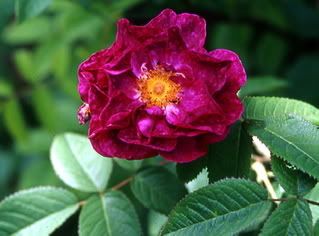 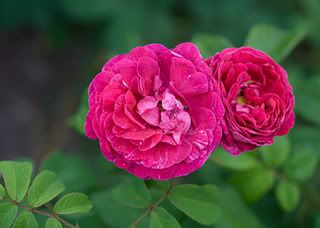 ‘Beau Narcisse’ ‘Beau Narcisse’ Meilles 1828 ’Alain Blanchard Vibert 1839 ’Assemblage de Beautes’ General Delaage (amateur) France 1823    ’Camaieux’ ’Camaieux’ Gendron or Vibert circa 1825-1830 ’George Vibert’ Robert 1853 ’Perle des Panachees’ Vibert 1845 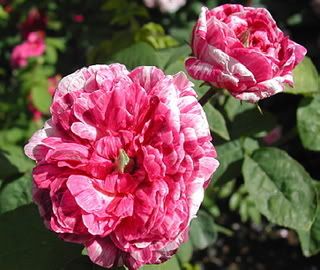 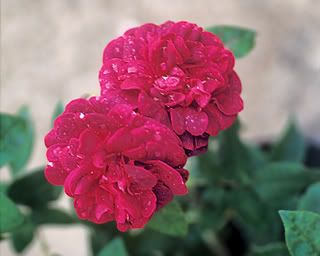 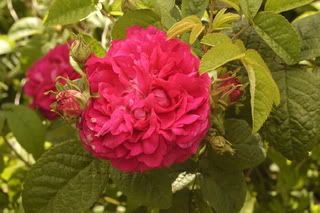 ’Tricolor de Flandre’ ’Tricolor de Flandre’ Van Houtte (Belgium )1846 ’Sissinghurst Castle’ thought to be of Dutch origin from 19th century. Found at Sissinghurst by Hon Vita Sackville-West 1947 ’d’Aguesseau’ Vibert 1832.  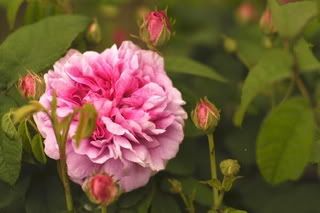 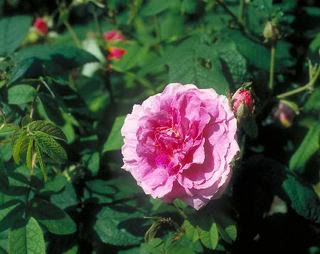 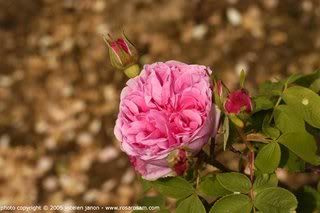 ’Ipsilante’ ’Ipsilante’ Vibert 1821 ’Henri Foucquier’Unknown 1842. The last two are ’Jenny Duval’ or ‘President de Seze’ they may be one in the same or two different plants President was raised by Mme Herbert circa 1830 Jenny by Duval circa 1840. Lots of confusion, looks like two plants to me.  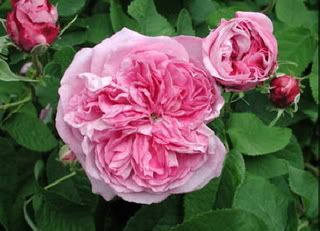  ’Fornarina’ ’Fornarina’ Vetilard 1826 ’Nestor either Vibert or Laffay circa 1840?? ’Nannette’ Unknown 1848 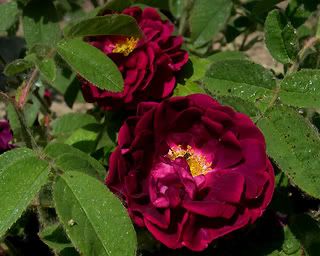  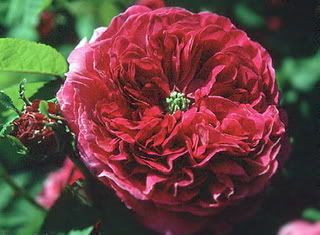 ’Tuscany Superb’ ’Tuscany Superb’ Rivers (Eng) 1837seedling of ’Tuscany’ a favourite of William Paul another English breeder. ’Van Artevelde’ unknown Dutch breeder introduced by Parmentier. ’Louis Philippe’ Unknown pre 1830, maybe Hardy in 1824
|
|
|
|
Post by fozzie on Jul 1, 2007 20:40:29 GMT
Part 5 DamasksI have split this post into two sections. Section 1 I’ll start with a quote from Graham S Thomas (a 20th century rosarian.) “These have proved the most elusive and diverse of all the Old Rose types. Their naming system has been, and still is, very confusing. This is because they comprise of so many different types, which is not so remarkable, when you look at their possible parentage.” (There’s a good start, doesn’t bode well does it?) Damask Roses are supposed to be from a hybridisation between R. gallica and R.phoenicia , which occurred in Asia Minor and became distributed throughout Syria and the Near East and Middle East. However, it is very difficult to get to the bottom of R. damascena. I can find references to the “Common Damask" in the early 1800's, and yet what the author is referring to by this term is unclear. It would seem that the " Common Damask" is the Autumn Damask and not the Summer Damask. ’Celsiana’, a beautiful rose, is possibly "typical" Damask; and yet, its provenance is being questioned. Even 'York and Lancaster’ , considered to be a sport of the original Damask, has been considered to be an Alba, due to it, allegedly sporting back to something like the Alba 'Semi-plena'! A theory I do not subscribe to. The cultivar used for the rose oil industry in Bulgaria, ‘Trigintipetala’ , is perhaps, R.damascena . 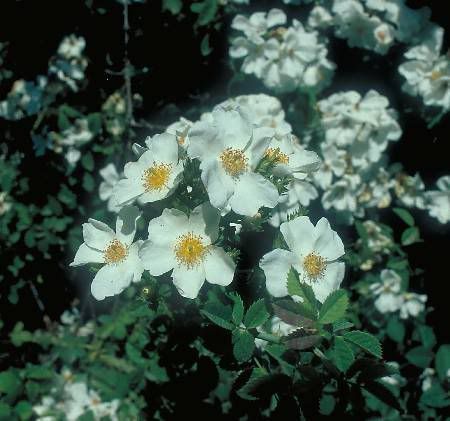 R.phoenicia R.phoenicia  R.gallica R.gallica  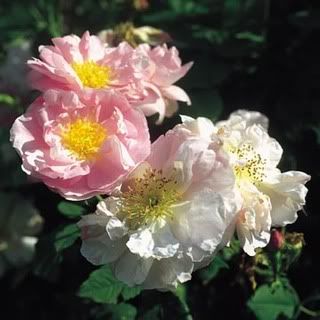 R.damascena ‘Celsiana’. R.damascena ‘Celsiana’. Introduced in 1732 by Cels. (Two pictures – I like this rose, its been on my “to get” list for a few years.)It’s a graceful shrub reaching some 4-5 foot in height and spread. The leaves are light green, smooth and have a hint of grey. The flowers borne, typically, in clusters, are wide semi double with yellow stamen. Opening a warm pink then fading to blush when fully open, with silky folded petals. In view of this somewhat mixed and disputed parentage it is difficult to describe a typical type for the group. Some will show characteristics of Centifolia while others will exhibit those of Gallica. So any description will be seen as vague and generalised, this will also be so for pruning. General Description (loose) They will have grey/green downy leaves, with 5-7 leaflets, flowers are frequently borne in clusters, the stems are prickly and sometimes thin tending to arch with weight of flower, with thin heps. The flower colour is in the range of whites through pinks. Hardy to zone 5 –29C (-20F) to –23C (-10f) I will give more detail, if I can find it, with the pictures and plants mentioned As indicated above, and as I am sure you are aware, there is more than one type of Damask. Not only do we have The Summer Damasks and The Autumn Damasks we also have Portlands or to give them their full name, but rarely used, The Portland Damasks Not to mention Damask Perpetuals so I won’t. There is also a school of thought that suggests the Damasks have had a part to play in the formation of the Moss Rose more of that later (!) If I’m still sane. 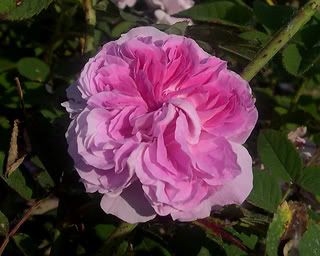 ’Blush Damask’ ’Blush Damask’ Introduced 1759- unknown breeder. Sometimes called ’Blush Gallica’ . People have questioned her parents, even hinting a Scot could be involved. Other believe she is the classic damask. If you grow Gallica you will see their influence. However, she is not a typical ’Damask’. She forms a large very twiggy bush, which in time can achieve 6 foot in all directions, bearing neat dark leaves. She bears large numbers of nodding blooms in June, they open a dark lilac pink, when fully open they reflex into a ball shape with the outer petals being lilac blush at the edges. Very strong fragrance. Know to be a favourite of a certain Miss Jekyll. (Pronounced? as you wish). A Little History, (a bit more than usual) The Damask Rose classified as R.damascena in 1757 by Mrs Blackwood, remember her? To the gardener the Damasks were a natural group, showing all the group characteristics of flower, colour and fragrance. The botanists, however, were not so sure. Although they agreed to the species classification and that they were a natural group. They also notice a strong resemblance to R.gallica . This resemblance was so close that they had to be hybrids of that plant, but with what? In some there were characteristics of R.phoenicia and in others the characteristics of R.moschata (have I got your attention Mrs P.) As a consequence The Damask Roses can be divided into two natural and distinct groups; (1) R x. damascena or x R.damascena (gallica x Phoenicia) The Summer Damask and 2) R x.bifera or x R.bifera (gallica x moschata) The Autumn Damasks 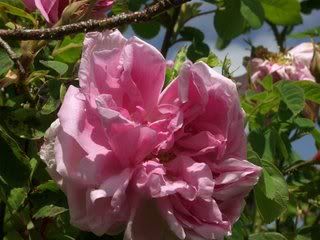 R.damascena R.damascena aka R.damascena ‘bifera’, Common Damask and Quatre Saisons 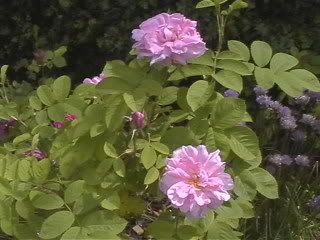 R.damascena R.damascena in my garden taken on one of the 4 days it did not rain in June! [ A little Techy footnote here.[/u] The above are the conclusions of Hurst. But it has always been a concern that both gallica and moschata are summer flowering so how does bifera end up flowering again in autumn. Hurst was convinced it came from moschata . He was correct of course. But, what did not come to light till recently was that he (Hurst) had been using the R. moschata species type, in his research. Some old R.moschata would flower in September till first frosts, while other flowered in June/July. The original autumn flowering “Musk Rose”, R.moschata appears to have been lost to cultivation, although it was well documented in the 17th and 18th century. It would have been this rose that produced the ”Damasks” It transpires that another rose, R.brunonii introduced in 1812 from Nepal, was for many years described and “sold” as Rosa Moschata, The Musk Rose has had R.moschata . In 1822 R.brunonii was classified as the Species type. Now Hurst, would have known of the “Old Musk Rose” , but may not have had a specimen, therefore his conclusions are based upon theory. I believe a specimen of “The Old Musk Rose” is thriving at Myddleton House, Enfield. (The home of the late E A Bowles) (Have I lost your attention now Mrs P, you and I have that summer flowering type, don’t even think of R.brunonii , it’s a monster reaching some 50 x 30 feet) R.brunonii R.brunonii  R.moschata R.moschata The summer flowering one, as growing in Plockets’ garden. 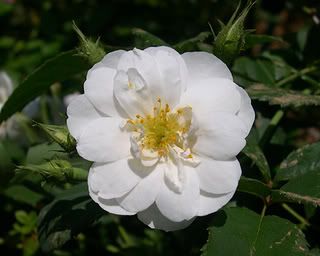 This is, allegedly, the one found in Myddleton House, but its difficult to unravel. Even this one is thought not to be pure and must therefore be a hybrid. Not surprising, can you tell difference from the one pictured above it? (Unless you have a serious sleep problem, my advice is, do not go there!)Back to the Damasks here’s a white one or two 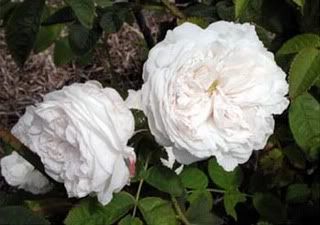 ‘Botzaris’ ‘Botzaris’ Introduced 1856 Robert. Medium sized shrub up to 5 foot by 3 foot wide. The flowers are double opening flat, creamy white, quartered with ‘button eye’ (where there are so many petals that the Stigma and Stamen get distorted to form a tight centre. I’ll show you a better example in Mme Hardy ). The white is possibly from R.alba 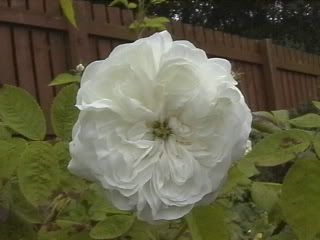 ’Mme Hardy’ ’Mme Hardy’ The keen eyed amongst you will recognise the fence-yes its mine! Introduced by Hardy, in 1832. Allegedly part R.centifolia , not sure to what extent. She produces a sturdy bush up to 5-6 foot, on good soil. The broad mid-green leaves and variety of prickles are not typical Damask . The clusters of flowers, however, are very typical of the group. The white flowers open cupped but very quickly becoming flat, the outer petals reflexing to leave the centre almost concave with a green eye. In the words of Dean Hole she was a perfect white and well formed rose, but alas green eyed, jealous maybe of Mme Zoutman , who had no such eye. What about The Portlands I hear you say, well just bide a wee while. Anyway, you should already know, it was mentioned in both the History and China sections. OK here is the Original 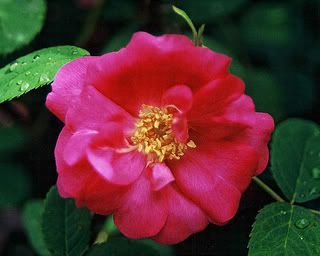 ’Duchess of Portland’ ’Duchess of Portland’ Circa 1780. Small to medium shrub 3-5 foot with erect twiggy growth, armed with small bristly prickles and bright green leaves, similar to R.gallica . The flowers are carried in clusters at the end of every stem. They are a bright, somewhat darker and more intense crimson, than ’The Red Rose of Lancaster , smaller and semi double with yellow stamens and in a shallow cup formation. They will repeat in autumn, not a strong scent. The Summer Damasks (R. X damascena) The old striped York and Lancaster Rose belongs to this group. One John Parkinson, who was Apothecary to James I, described it in 1629. W Shakespeare (or was it Bacon) when putting quill to parchment, mentions the York and Lancaster Rose. in both Henry VI and Sonnet XCIX (Don’t rush to your complete works reference book). The York and Lancaster Rose is the one often confused with R.gallica ‘Rosa Mundi’ . But as you can see from the following description of both, they are different. To quote Hurst “the striping in both is completely different, in ’Rosa Mundi the ground colour of the petals is pale pink, irregularly striped all over with rosy red. While in ’York and Lancaster’ the base colour is white with partially striping of rose pink” (he he, could not resist that). When you see them next to each other as plants the difference is very obvious, in shape and form if nothing else.  ’York and Lancaster’ ’York and Lancaster’ aka ‘Versicolor’ Introduction date unknown so best to say prior 1600. A typical tall growing Damask , mixed prickle size and shape, green wood with grey/green leaves. She has clusters of long stem flowers spraying outward, in blush and light pink. They are loosely double, may be wholly the paler or the stronger colour, or flaked with one or the other. They are never striped as in ‘Rosa Mundi’. A medium sized shrub up to 5 foot on good soil and like me, prefers partial shade. 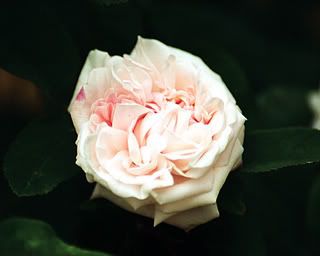 ’Catherine Ghislaine’ (Here’s that name again BB, not forgotten you) ’Catherine Ghislaine’ (Here’s that name again BB, not forgotten you) aka ‘Rose du Roi a Fleures Blanches' Introduced 1849 by Dubos Sometimes classed as a Portland She is a small/medium sized bushy shrub up to 4-5 foot, with small prickles and bristles. Light green leaves with a typical thin Damask hep. The flowers open blush pink then fading to a creamy white when fully open, with a muddled middle!( Know the feeling) A few more. 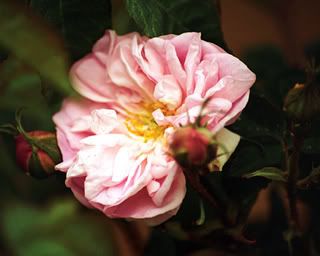 ‘Gloire de Guilan’ ‘Gloire de Guilan’ Introduced by Hilling 1949 A sprawling shrub up to 4 foot, small curved prickles. It has cupped blooms that open flat, the blooms are quartered and some petals remain folded. The colour is a very clear pink. The rose was collected and named by Miss Nancy Lindsay during the period between the WWs. It was growing in Iran where it is used to produce attar of Roses. 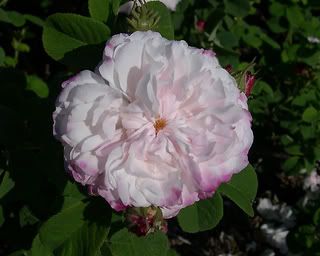 ‘Leda’ ‘Leda’ aka ‘Painted Damask’ Introduced circa 1820 unknown breeder believed to be English. She has dark green rounded foliage and dark red brown buds. The flowers open to bright milk white just tinged with blush pink. The external red tones develop to crimson and remain on the extremities of the outer petals. Thereby giving rise to the popular name Another mysterious historical member of the Summer Damasks is a rose known as The Holy Rose . The history of this rose appears to go back further than any other garden rose. The earliest record was that of a rose planted in courtyards in religious sanctuaries in Abyssinia. It was described in 1848 in the Flora of Abyssinia as Rosa Sancta . Its characteristics fit between the Red (Gallica) and Phoenician Rose , since R.phoenicia is not a cultivated plant The Holy Rose is deemed a natural hybrid with its home in Syria and Asia Minor where both parents overlap. A Christian traveller/missionary to Abyssinia from Phoenicia (Syria) in around 300 ad is said to have brought the plant with him. Hence it was found in sanctuaries. It is also thought that this was the same rose as found in the form of a garland in tombs in Egypt, dating back to around the 3rd century AD. In 1922 it was renamed R.x richardii after the person (Richard) who classified it in 1848. There was already a R.sancta registered in 1827 by Andrews a completely different rose. So Richards R.sancta Anyway it matters not a jot because both R.sancta and R.richardii are now synonymous with R. x damascena (Yes, I know. But just think of the impact, when you throw that in, to keep the conversation going in the Snug, on a cold winter’s night!)I could not decide so have given you two pictures of each. 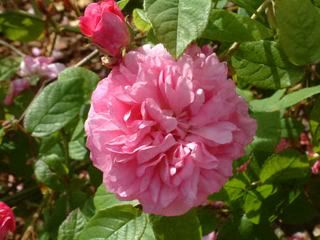 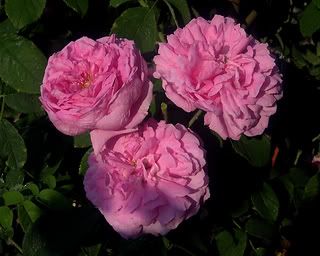 ’Ispahan’ (rose d’Isfahan) ’Ispahan’ (rose d’Isfahan) aka ’Pompon des Princes’ Introduced circa 1830 unknown breeder. She produces a bushy upright shrub up to 5-6 foot, very free-flowering in clusters, as per type for the class, but the small shiny leaves are definitely not as type and would suggest not pure Damask parentage. The neat buds, the half open blooms that reflex later when fully open, are at all times a clear vibrant pink. This is one of the first ‘Old Roses’ to open and one of the last to finish, with a brilliant display for the whole period. 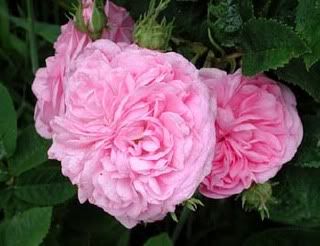 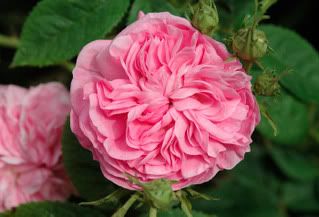 ‘La Ville de Bruxelles’ ‘La Ville de Bruxelles’ Introduced 1849 by Vibert Medium shrub up to 5 foot , has long large light green leaves. The flowers are possibly the largest of all Old Roses and when fully open will reflex at the edges of the bloom to form a large convex centre. The clear, clean rich pink is constant from bud to petal drop. The individual sprays are a picture, the only “down” side is that the weight of the blooms will send the blooms hiding amongst the leaves. Something else to throw in when the conversation lapses, a fresco painting of a rose was uncovered at Knossos, Crete. This fresco was from the Minoan era on Crete and dates to 2000 BC. Apparently these Minoans kept in contact with Egypt, Greece and Phoenicia. So, they may well have also been cultivating Damasks . Either way this Minoan fresco is probably the oldest historical record of a Rose.
|
|
|
|
Post by fozzie on Jul 1, 2007 20:42:17 GMT
Section 2 The Autumn Damasks (R. x bifera) Like their parents gallica and moschata are renown for their perfume and free flowering properties. First records show them on the island of Samos in the 10th century. They were said to flower twice a year and used in the cult of Aphrodite. The Egyptians grew them to supply the Roman market, especially in the winter, more profit supposedly. Frescos of this rose were found in the ruins of Pompeii, which was destroyed in AD 79. It would appear that Midas had brought them (the roses)from Asia Minor into Macedonia, from where they found their way to Greece and Italy According to Arab history, during the 10th century, this rose was cultivated in vast numbers in Syria for the production of rose water and medicines. In the 12th century it appears again with the Arabs but this time in Spain. In Cuba it is known as the Alexandria Rose , which is what the Spanish colonists would have called it, believing it came from Alexandria, via the Moors. We would know this particular hybrid as ’Quatre Saisons’ . Here are the ‘Autumn Damasks’ they are but few, two in fact, so all at once. The pink you have seen above, but here it is a gain 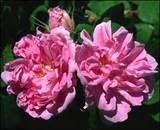 ‘Autumn Damask’ (Rosa damascena semperflorens)(R.gallica x R.moschata) ‘Autumn Damask’ (Rosa damascena semperflorens)(R.gallica x R.moschata) An untidy shrub reaching some 5 foot. She has an abundance of pale grey-green, with a hint of yellow, leaves. She will flower from June till October. They open from shapely buds, and are of a clear pink, deepening in intensity towards the centre with a few crumpled petals, sometimes quartered. They have a rich fragrance.  This is ‘Quatre Saisons Blanc Mousseux’ (Rosa damascena semperflorens ‘Albo-muscosa’) , both options a bit of a mouthful. Also called The Perpetual White Moss’ Introduced circa 1800 by Laffay. She is a sport of ‘Quatre Saisons’ above, which she will often revert back to, sometimes giving both colours on the same plant. All aspects as ‘Quatre Saisons’ except, she has mossy excrescences, (I had to look it up, so I thought I’d include it, it means abnormal or morbid outgrowth on the body or a plant) on the leaves and stems. The moss on leaf, stem and bud is brownish green. The flowers are white with a touch of blush on opening. This picture shows those mossy bits. 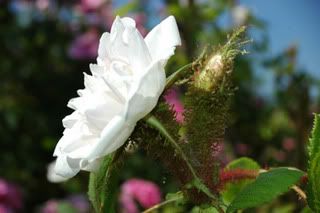 So there you have it the Perpetual White Moss is not a Moss at all, it’s a Damask . If only life was that simple, Even in modern times the Autumn Damask Rose is still preferred to any other for the production of rose water and attar of roses. There are vast plantations of this variety (’Kazanlik’) in Turkey, Bulgaria, Egypt, India and Morocco.  Growing in Bulgaria 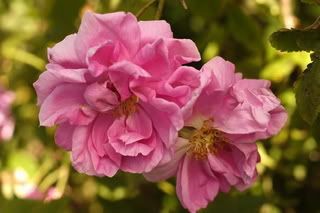 Variety known as ‘Kazanlik’ named after the region in Bulgaria, where 10s if not 100s of thousands are grown. Another conversation piece for the Snug, en passant, so to speak. The Romans, at the time of Midas in Asia Minor, called their rose with a 100 petals “ centifolia. ” Not surprising, considering Latin was their native tongue. It turns out to be our bifera ‘Autumn Damask’ It could not have been what we now know as centifolia as that did not appear until the 1700s in Holland. Although there was a time when they were believed to be the same thing. A few more Summer Damasks before we go on to Portlands 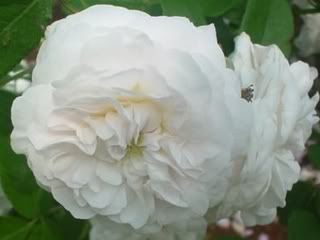 ‘Mme Zoetmans’ ‘Mme Zoetmans’ Introduced 1836 by Moreau, The flowers show it’s Gallica parentage. They open a pale blush and quickly fade to almost pure white with a faint blush centre and are fully double. They arrive early in the summer in a single flush. The leaves are a light green and carried on a small graceful bush up to 4 foot. David Austin has a specimen at his Albrighton nursery, but I have not discovered how it was or is used by DA 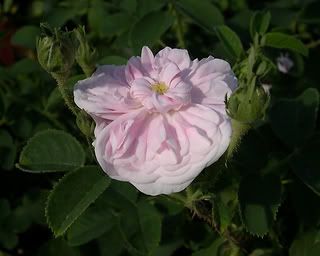 ‘Petite Lisette’ ‘Petite Lisette’ Introduced 1817 by Vibert This is a “miniature” 3-4 foot. Has a few small prickles and green wood; the leaves are greyish, small and coarsely toothed. They are a good foil for the flat, circular, pure pink flowers, which are filled with petals that radiate from their button eye. It is often classified as a Centifolia. , (I do not know how), It is closely related both ‘Omar Khayyam and R.gallica ‘Agathe Incarnata’ and maybe an original type of Damask  ‘Omar Khayyam’ ‘Omar Khayyam’ Introduced circa 1894, not known by whom. A true Damask propagated from a plant growing at the grave of Edward Fitzgerald, he of “The Rubaiyat of Omar Khayyam” fame, in Suffolk. Where it was originally planted in 1893 as a seed from the Damask growing at Omar Khyyams tomb at Nashipur, Iran. ( Not just roses but little bits of history, literature, geography and general knowledge that you can store away for later use.) Small shrub growing to some 3 foot, light green wood with dark prickles. The leaves are small, downy and a pale green. The small flowers are double, produced in spring. They show a distictive form, having a pronounced button eye with folded and quartered petals in a soft pink Portland DamasksTricky this, as the details are somewhat obscure. Was known to be in Paris circa 1809, obtained from England by M. Andre. Du Pont. Founder of the Luxembourg Gardens rose collection. He named it after the 2nd Duchess of Portland (Margaret Cavendish-Bentinck, Duchess of Portland (1715-1785), she brought it to England, from one of the family Italian estates. It was known in England as ”Rosa Paestana” or “Scarlet Four Seasons”. As usual there was a debate over parentage, with Hurst indicating that ”Slaters Crimson China” may have a part to play. It is now accepted that the parents of ”Portlands” were R.gallica and R.damascena var semperflorens syn R.damascena ‘bifera’ Portlands are easy to spot; they are short bushy shrubs up to 4 foot. The flowers have very short stems (“neck”) and seem to sit on a rosette (“shoulder”) of leaves. Just like a front row forward, head and shoulders, no neck. Amongst this group not only will you find some fine roses but also some very useful roses. They are all continuous or repeat flowering and generally reach a small size shrub 3-4 feet. They can fulfil a variety of roles from mass bedding to hedging and most do very well in pots or containers There are not many left in commercial production, I have chosen just a few for you. 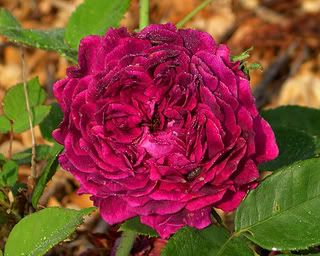 ‘Arthur de Sansal’ ‘Arthur de Sansal’ Introduced 1855 by Cochet A small erect shrub of up to 3 foot producing large heads of small flowers in late summer but will flower more or less continuously from mid summer. The leaves are a dark green, the dark purple buds open flat to a double, short petalled, quartered, deep purple-crimson flower. 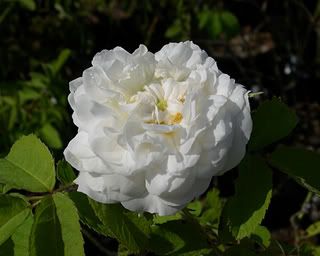 ‘Blanc de Vibert’ ‘Blanc de Vibert’ Introduced 1847 by Vibert It has that often described as yellowish-green leaves of a Damask I prefer pale green. It is a short, best described as loosely upright shrub. The flowers are cupped very double and almost pure white when half open showing a hint of lemon at the centre, becoming pure white when fully open. 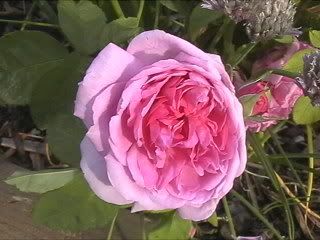 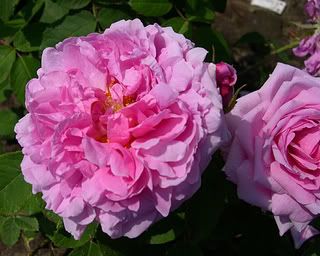 ‘Comte de Chambord’ ‘Comte de Chambord’ Introduced 1860 by Robert et Moreau. (I have this shrub, one of the pictures is my rose). If you look closely at the picture there are buds and the flower in three stages. It’s a first class plant, always in flower throughout the summer. Sturdy erect growth up to 4 foot, has pointed light green leaves. The classic rose buds open with rolled petals to a tightly filled flat flower, sometimes quartered but always with reflexed and rolled petals around the edges. The colour is a rich pink with lilac tones. Very fragrant.  ‘Indigo’ ‘Indigo’ Introduced c.1830 by Laffay. Upright bushes up to 4 foot, with smooth long leaves of a medium green. The flowers are a very rich dark purple, with expanded shape, flushed with dark crimson. It shows a few stamens and occasionally a white streak. They are carried at midsummer and again later in the year. Said by many to be the most effective of dark purple roses. You may well come across a group called ‘Damask Perpetuals’ . I am sure you are aware by now, in the 1800s hybridisers were crossing anything with everything and then trying to find a ‘group’ home for the prodigy of there crosses. ‘Damask Perpetuals’ were in fact one such ‘bucket’ for prodigy of Autumn Damasks that were crossed with…well anything really. You could say that the first members were in fact the Autumn Damasks and Portlands They are in fact the forerunners of Hybrid Perpetuals. (A group, which, I approach with trepidation and will place before you a little later.) Our cousins, over the pond, who allegedly, speak the same language as us, appear to use the term ‘Damask Perpetuals’ when talking about Portlands . 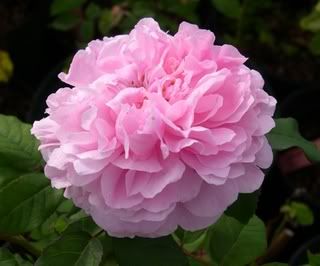 ‘Jacques Cartier’ ‘Jacques Cartier’ Introduced 1863 by Moreau-Robert. Sometimes confused with another rose called ‘ Marquise Bocella’. They look like two different plants to me. This is ‘Jacques Cartier’ . Has a compact yet erect growing habit up to 5 foot with plenty of light green leaves. The soft pink flowers are fully double often quartered and with a button eye. Very fragrant. Will flower early summer and a second flush later in season. I found this quote from an old Rose Manual circa 1840. “They ( ‘Damask Perpetuals’ ) are best grown as standards from 6 inches to 4 feet…….The rods that support the standards should be put on the South side of the plant; the strong sun is thereby warded off the stem, which is beneficial both in summer and winter.” It made me smile. So don’t forget to take your compass when planting standards! Pruning Shrub Roses will continue to flower well even without pruning, but will end up as large and maybe congested shrubs. The main objective of pruning therefore, is to prevent the shrub from becoming too large or congested. The pruning should always be modified to suit the growth characteristics of the plant, but as a guide, shorten the main stem by about a third and any remaining side shoots by about 2 thirds. Cut out completely any dead, diseased or crossing stems. Always keeping an eye on the overall shape of the shrub. The frequency is up to you and how you want to grow the shrub. For example, if completed annually, you will encourage new growth from the base, keep it compact and have flowers close to the ground. Damask specifics.For Summer damasks I would use the “general” method as above, with the following, remove the twiggy growth straight after flowering. Any long strong growth can be shortened by 2/3 in the autumn/winter prune. I found this advice for the Autumn damask and Portlands ; prune as HT in December /January (this was news to me I have never use this method on my roses of these types, I use the general method described above) Allegedly it improves flowering. A few more ‘Portlands’  ‘Rembrandt’ ‘Rembrandt’ Introduced Moreau-Roberts 1883. A somewhat thin but erect shrub up to 4/5 feet, rounded mid green leaves, has small fully double flowers of light crimson, veined and blotched, good scent and will repeat in the autumn. 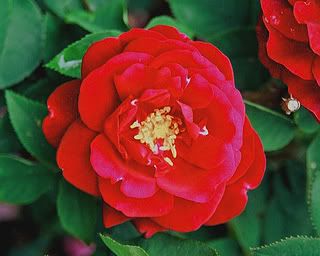 ‘Rose du Roi’ ‘Rose du Roi’ Introduced 1819 by Lelieur. Small/medium erect shrub 4/5 foot, with mid green foliage. The semi double flowers are a deep cherry red and will repeat later in season, highly fragrant. 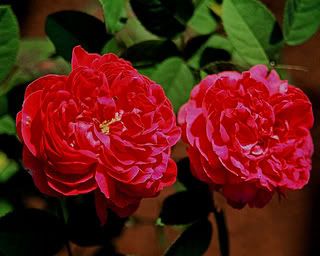 ‘Rose de Rescht’ ‘Rose de Rescht’ Introduced pre 1900 unknown breeder. Compact, dense, and upright shrub up to 4 foot. Has deep crimson double flowers, some say continuous. Others indicate spring/summer flowering with repeat in autumn. |
|
|
|
Post by fozzie on Sept 23, 2007 18:32:59 GMT
Not far to go now, we are about half way. Its getting like an Icelandic saga excuse me if I waffle on here and there only sometimes I feel like I'm writing a story! Part 6 Alba's (The White Roses)R.x alba 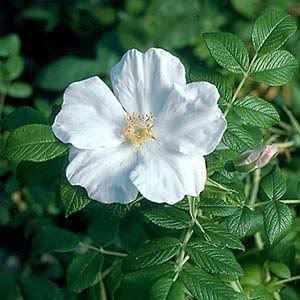  Notice the leaf texture a trait of Alba's A little aside on how I got interested in Old Roses. As many of you will know, I have a thing about HT roses and at times have been known, with tongue in cheek, to be derisory about them. It is not true to say that I dislike them, I just do not appreciate them. Like many of you I was brought up surrounded by HT roses. As a lad in the mid 50s it was my job to feed, water and spray them, and eventually prune them, after years of tuition. (bless you Granddad.) On one such pruning lesson I discovered a “sucker”, it was explained that this is not what we wanted to grow (what’s the last thing you tell a child!). It was ripped from the ground and thrown away, not on the compost but in the rubbish bin. I was told that it was a rose used as a base to grow other roses on. That “sucker” (unknown rootstock), started me on my discovery of Roses. My first discovery was the Species Roses and I have always had at least two in my garden (usually R.moyesii and our native Dog Rose R.canina). Species roses have always been my favourite. I do not think you can beat the simple beauty of a wild rose flower. My second discovery was the Old Fashioned Roses, as they used to be called. So now, in my discoveries, we have the two rose flower styles of Single flower and Double flower. All roses, bar one, were originally single with five petalled flowers, there would have been some natural crosses resulting in semi doubles or doubles. These have been cultivated further to produce some of our Old Roses. The Doubling of a flower is due to the stamen and styles being replaced by petals. It was not until the early 1800s that hybridisers selected the floral style of double flower. And it was the, flat fully expanded, circular flower with short petals, which they concentrated on. The rose in both these styles is at its best in full flower, something that cannot be said for the HT rose, which it at its best in bud or half open. (Not enough petals and they are too long!) I have a problem with plants that are less beautiful then their ancestors; I do not see the point of a flower ‘engineered’ to be at its best before being fully open. As I get down from me soap box I will add that I have 3 HT roses in my garden, National Trust (original bought by my mum, the colour is superb, it goes where I go), White wings and Mrs Oakley Fisher (bought by me! If you look them up you’ll see why. Every now and again they get thrown up as a sort of “throw back”).(Now the Alba's)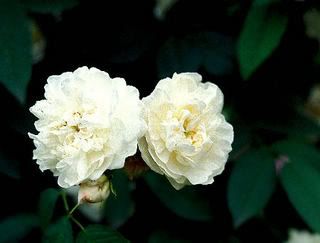 R.alba 'A Feuilles de Chanvre’ R.alba 'A Feuilles de Chanvre’ introduced in the 1700s in France, sometimes known as Rosa cannabina, the Hemp-leaved Rose it is a very old form, having near prickle less stems and long thin grey green leaves, as that of its namesake, semi double white flowers. Sometimes classed as a Centifolia. 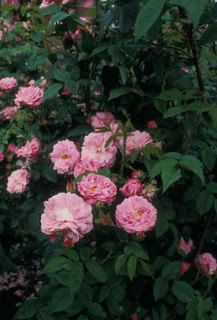 R.alba ‘Belle Amour’ R.alba ‘Belle Amour’ of unknown origin was found in a convent at Elboeuf in 1940, allegedly the only rose in the Old groups with such a salmon colouring. It is aid to have the scent of myrrh. (I have no idea what myrrh smells like). Those two traits colour and scent lead some to believe it has R.arvensis in its parentage. General Description The Alba's and their hybrids are known as the 'White Roses' (Alba, fem. of Latin albus – white), though their blossoms range in colour from pure white to soft shades of pink. They are vigorous, hardy and very disease resistant. Their sprays of blooms are fragrant and occur only once in a massive early summer display. They have bluish/Gray foliage and their upright growth habit means they make large shrubs up to 7’, with a spread of 5’. This makes them a fine backdrop for other roses. Many are shade and drought tolerant and hardy to at least zone 5 (-20F/-29C to –10F/-23C). Good for a North-facing wall. 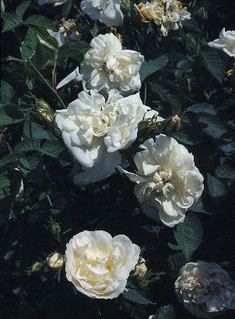 R.alba ’Blanche de Belgique’ R.alba ’Blanche de Belgique’ Introduced 1817 by Vibert. A medium-sized, bushy shrub up to 5 foot. Flowers held in clusters are white, fully double with a characteristic tight centre of small petals. Scent very good, likened by some to hyacinths. 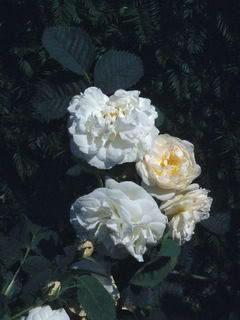 R.alba ‘Princesse Lamballe’ R.alba ‘Princesse Lamballe’ Introduced pre 1840 possible by Miellez. Medium bush up to 5 foot, fully double white flower. She was a loyal friend of Marie-Antoinette and ended up the same way in 1792. 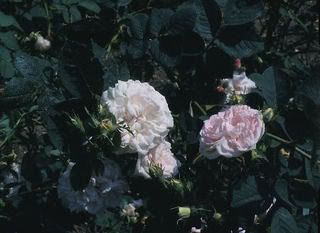 R.alba ‘Josephine de Beauharnais’ R.alba ‘Josephine de Beauharnais’ Introduced by Vibert before 1848. Remember the name it will appear again in a different class later A bit of history The Alba's are one of the, pre China, Old Group of roses, which has persisted through the centuries. It has been in general cultivation from the time of the Greeks and Romans with some evidence as far back as 25AD (Pliny Roman Emperor, wrote of a white rose). In the War of the Roses the white semi double English rose R.alba Semi-Plena was traditionally associated with the house of York. In 1753 Linnaeus made it a species under the name R.alba although it is obviously a garden hybrid, most botanists regarded it as a species until 1873. At this point it was suggested that it was a hybrid between R.rubra and R.canina . Thus named R. x alba. (Or x R.alba depending on whom you talk to!) By way of a change there has been some debate regarding parentage, (there’s a surprise) with Hurst detecting the influence of R.phoenicia and declaring R.damascena in place of R.rubra as one of the parents. (As if any of us are that bothered!) It has been reported as growing wild in the Crimea, and maybe it originated there as a natural hybrid. Although some of the older Alba's, 'Maidens Bush', R.alba 'Semi Plena’ (White Rose of York) and R. x alba 'Maxima' (Great Double White) have been with us since the 1700s, most of the albas available today were bred in the 1800s. The full double version R.alba Maxima (aka Jacobite rose) was the badge of Bonnie Prince Charlie and his followers.   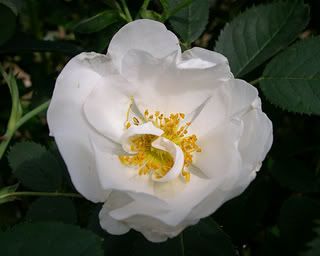 R.alba ‘Semi-Plena’ R.alba ‘Semi-Plena’ A very ancient rose, almost certainly grown by the Romans, and probably by earlier civilisations. A large shrub to 7 foot, with arching branches and strong new stems produced from the base. As well as being know as Rose of York, it also goes by the name R.a ‘Suaveolens’ or R.a ‘Nivea’. It is one of the Roses grown at Kazanlik for the distilling of attar. It’s a beautiful plant with large clusters of white nearly, single flowers with a good show of red hips in the autumn. 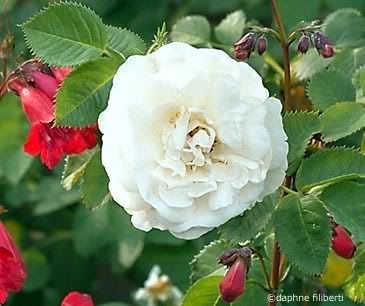 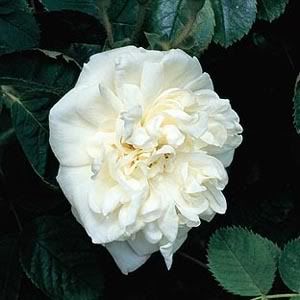 R.alba ‘Maxima’ R.alba ‘Maxima’ (aka Jacobite Rose Great Double White and Cheshire Rose) Said to be a sport of ‘Semi-Plena. A large shrub to 7-8 foot, with arching branches. Leaves greyish-green, with usually 7 broad leaflets. Flowers well-scented, open blush then turn creamy white. The centre of the flower has small, irregular petals and some stamens showing when fully open. It is similar in leaf and habit to ‘Alba Semi-plena’, and has been known to revert to it. Best for back of border, or small climber.  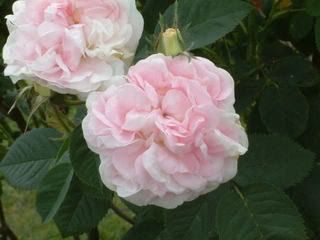 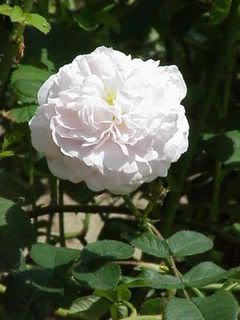 R.alba’Maidens Blush Great’ R.alba’Maidens Blush Great’ It has a plethora of aliases (La Royale, La Virginale Incarnata, Cuisse de Nymphe, Nymphs Thigh to name but a few) Bred at Kew 1797, one of the oldest favourites and frequently found in cottage gardens where its good growing habits and reliability have ensured its safe keeping. I believe it to be one of the best large shrub roses; it has beautiful blush pink turning to creamy white flowers and an equally unforgettable pure scent. The overall shape is informal like R.a maximaThe techy bit, chromosomes and all that (you did not expect anything else from me, did you?)As I said above, Dr Hurst showed that R.x alba was influenced by R.damascena and concludes, this and not R.rubra, to be one of the parent, and that the other was a white almost prickles R.canina from Europe. (Note the term prickles. Roses do not have thorns they have prickles, they might be bl**dy big prickles, but they are prickles nonetheless.) Furthermore, from the chromosome number, R.canina can be identified as the female parent. How? I hear you ask (You’ll be sorry!) R.alba is a hexaploid with 42 chromosomes, R.canina is a pentaploid with 35 chromosomes, (28 fem 7 male), R.damascena is a tetraploid with 28 chromosomes (14 fem, 14 male). If R.canina had been the male parent, R x alba would have been triploid with 21 chromosomes. (For those of you wishing to know R. x alba has 28 fem and 14 male chromosomes.) So, it is now generally accepted that the parents are R damascena and R.canina. While we are in the chromosome zone, you will often hear it said that some roses are sterile. This is not strictly true. They are just not as fertile as other roses. All roses will produce viable seed, in some it could be 1 in 100, in others it could be 99 in 100 or anywhere in between. 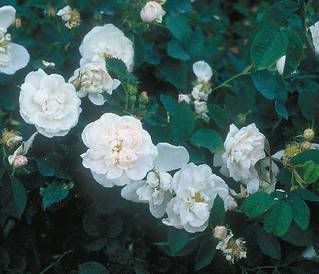 R.alba ‘Jeanne d’Arc’ R.alba ‘Jeanne d’Arc’. Introduced 1818 by Vibert. This is a dwarf version of ‘Maxima’, it forms a dense shrub of some 4foot. The flowers are well filled and of soft pink fading to ivory white. 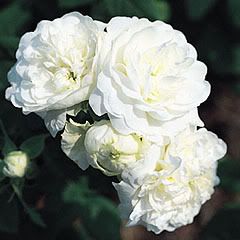 R.alba ‘Mme Plantier’ R.alba ‘Mme Plantier’ Hybrid Alba introduced by Plantier in 1835. The flowers are creamy white changing to pure white with a green button eye, very double; scent moderate; the foliage is rather small with normally seven leaflets. It can be grown as a lax shrub to about 5 feet or a climber up to about 12 feet. The Parents is thought to be R.alba x R.moschata It nice to know that our Dog Rose played a part in forming this group, which, to me, are possibly the best of the Old Roses, I think they are the most beautiful and refined of the groups, they have a delicacy of colour and pure scent that excels over the others. To quote Thomas “there is no rose scent so pure and delicious as Maidens Blush”. I can only agree. I have ‘Maidens Blush Great’ , when she is in full bloom you do not need to see her to know she is there. If you compare the Albas with the wild rose groups you will see the R.canina connection. All aspects of R.alba semi-plena (often called the typical Alba) are all R.canina . But the growth habit of Alba's is more straight up or upright, which is why sometimes they are referred to as “Tree Roses”. Their growth habit is perfect for a flowering shrub. And, unlike Gallicas they are not prone to run, although they will spread slowly, using that method, if on own roots or on rootstock or planted deeper than normal. They make strong new growth from the base, on smooth green wood, with sparse prickles. As the years pass the stems make many branches at the top causing the stems to arch over. After 4 or 5 years you will have a nice thicket of stems. This brings us neatly on to … 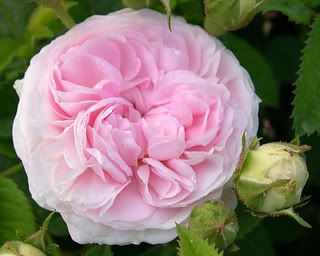 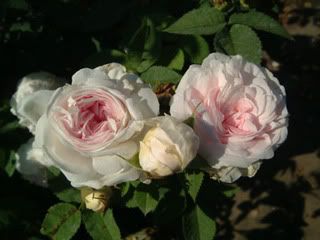 R.alba ‘Felicite Parmentier’ R.alba ‘Felicite Parmentier’ Introduced 1833/4 by Parmentier, a very popular shrub, is different from the group type by having yellowish green leaves and stems with dark prickles. She has densely pack buds that open to very full flowers of a clear pink. The fully open flower is a delight and is shaped almost like a globe and fading to white at the edges. 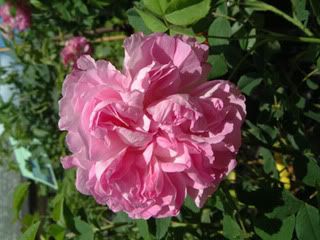 R.alba ‘Blush Hip’ R.alba ‘Blush Hip’ Unknown hybridiser introduced circa 1840, very strong pink, medium sized shrub up to 5 foot.  R.alba ‘Mme Legras de St Germain’ R.alba ‘Mme Legras de St Germain’ Unknown hybridiser introduced circa 1848, vigorous shoots up to 7 foot, almost prickle less, with pale green leave. The flowers as you can see are just perfection, they open from a small bud to a slightly cupped bloom, then flat when fully open. The ivory white flower has a pale yellow middle. PruningShrub Roses will continue to flower well even without pruning, but will end up as large and maybe congested shrubs. The main objective of pruning therefore, is to prevent the shrub from becoming too large or congested. The pruning should always be modified to suit the growth characteristics of the plant, but as a guide, shorten the main stem by about a third and any remaining side shoots by about 2 thirds. Cut out completely any dead, diseased or crossing stems. Always keeping an eye on the overall shape of the shrub. The frequency is up to you and how you want to grow the shrub. For example, if completed annually, you will encourage new growth from the base, keep it compact and have flowers close to the ground. 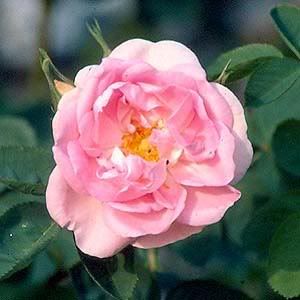 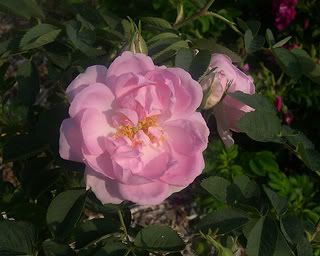 R.alba ‘Celeste’ R.alba ‘Celeste’ Introduced circa 1759. This is one of the most beautiful of old roses for its clear blue-green leaves and perfect opening flower of a rich pale pink with a circle of yellow stamen. It is easily grown and flowers well in poor conditions. It has all the Alba qualities, growing up to 6 foot 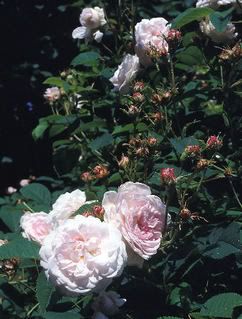 R.alba ‘Chloris’ R.alba ‘Chloris’ (aka Dew of the Morning) Introduced in 1820 by Descement. A good healthy bush, prickles are few, a soft pink flower that shows a button middle when the petals reflex. Alba Specifics (but optional!)If you are growing Alba's as a flowering shrub then all I would do is to remove some of that thicket growth completely on an annual basis in say December – February. As I said earlier I have a Maidens Blush Great. This is oft times sold as a small climber reaching some 8 foot. Really it wants to be a shrub. So to keep everybody happy, I have it against a fence with the rear stems trained a la climber, with the others stems cascading forward a la shrub. I only prune it to keep it within desired bounds. Come June/July when she is in full bloom I’ll post some pics in the My Garden section.  R.alba “Amelia” R.alba “Amelia” raised by Vibert in 1823. Low-growing for an alba, with stems to 4 foot. Flowers semi-double, of quite a rich pink, opening flat with a mixture of small petals and stamens in the centre. Leaves bluish-green, with very broad leaflets. Numerous small, red prickles  R.alba ‘Pompom Blanc Parfait’ R.alba ‘Pompom Blanc Parfait’ Introduced before 1876, probably by Verdier. The flowers are pale blush to white, double; virtually without prickles. Possibly an Alba crossed with a Rosa multiflora. Reaches up to 5 foot 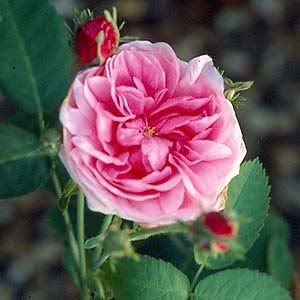 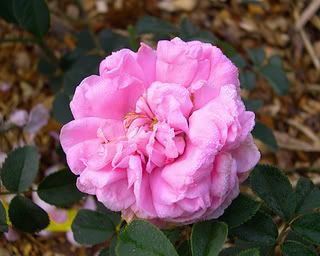 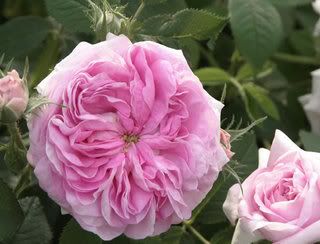 R.alba ‘Konigin von Danemark’ R.alba ‘Konigin von Danemark’ Introduced 1826 by Booth. The flowers are double with a strong fragrance, in a quartered, rosette form. Opening carmine and fading to a pale pink when fully open. Once flowering, in late spring or early summer and attains a height of up to 6' with a spread of 4' to 5'. (James Booth, a Scot, had his nursery at Flottbeck just outside the city of Hamburg; therefore was in the state of Holstein, which at the time was in sovereign union with Denmark, the King of Demark also being the Duke of Holstein hence the name, Queen of Denmark.) To some ‘Konigin von Danemark’ epitomises the qualities that the breeders were trying to achieve in Roses at the time. To quote a modern Rosarian “this variety has a perfection of form almost unequalled and shows what the hybridisers of that day considered superlatively beautiful.” She is a “seedling” of ’Maidens Blush’ (that normally means the pollen parent is unknown). I think I prefer the parent, but it’s a difficult choice. So difficult that I have both |
|
|
|
Post by fozzie on Oct 29, 2007 17:52:20 GMT
Part 7 The Centifolia Roses - Section 1 [/u] This will be in two sections: Firstly Provence Rose then secondly Moss Rose and others . Pruning is with Moss Roses , but you must all know it backwards by now! 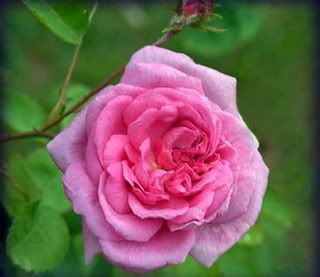 R.centifolia R.centifolia [/b] I must be honest. Not my favourite Class of Rose. Their open thorny growth is anything but elegant. Having said that I do have a couple, although mine are in a position where they are using other roses for support. They always remind me of children, who, after transgressing, will turn on the charm and wondrous smiles, and are then forgiven. So it is with Centifolia when they show their gracious flowers, we can forgive their frailties. As I am sure you are fully aware this group is also called ‘The Provence Rose' or ‘Cabbage Rose’ . Also included under ‘Centifolia will be ‘The Moss Rose’ and a couple of other items. General Description The plants in this group will produce a lax and open shrub. Sometimes achieving 5-7 feet. They carry varied prickles, from short spines to large hooks on their stems. The foliage consists of lush, coarsely toothed, sometimes wrinkled leaves. The many petalled richly scented flowers are carried singly or in large bunches. The long prickly stems would benefit from some support. There are, of course, exceptions. Some will form a plant of more compact and upright in growth. There are even some classed as miniatures. Hardy to Zone 5 (-29C/-20F to -23C/-10F). As before I’ll try to give as much details as possible in the individual description of the plants pictured.  R.centifolia ‘Bullata’ R.centifolia ‘Bullata’ A distinctive form introduced circa 1800 and apart from its leaves is a typical Provence Rose . The leaves are remarkable; they take the shape of a lettuce, in their puckered, bullate and enlarged segments, tinted brown (mahogany) when young. Grows to 5 foot, the plant not the leaves! 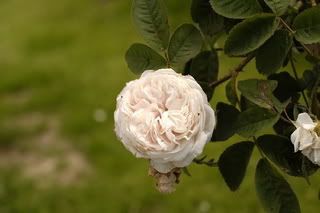 R.centifolia ‘Blanchefleur’ R.centifolia ‘Blanchefleur’ . Introduced by Vibert in 1835. Not a typical Provence Rose . It has a vigorous open habit again up to approx 5 feet. The flowers have the “cabbage” look, are creamy white with a hint of blush at the centre, often quartered and open flat with rolled edges to the petals. ![]() i163.photobucket.com/albums/t286/rosenfreund/Historical%20Roses/centifolia/spong300.jpg i163.photobucket.com/albums/t286/rosenfreund/Historical%20Roses/centifolia/spong300.jpg[/IMG] R.centifolia ‘Spong’ Introduced circa 1805 by Spong – England. Was produced in numbers by a gardener called Spong. It was unnamed so got called ……. Yes, you got it. Who said we English are unimaginative and boring! It has a bushy upright habit growing to about 4 foot. The flowers are cupped, opening flat but not pompons in shape. It is very early flowering and generally over before the larger Provence Roses are in flower. 1. Centifolia Roses: The Provence Rose 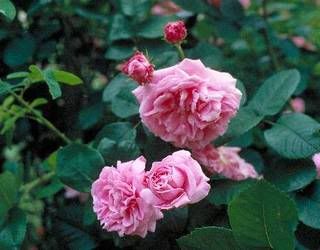 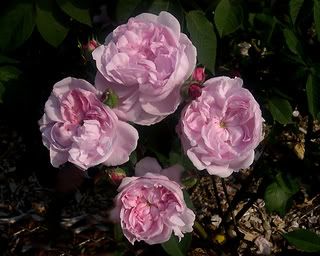  R.centifolia ‘Duc de Fitzjames R.centifolia ‘Duc de Fitzjames Introduction unknown (!) Grows to approx 6 foot, produces trusses of pink, cupped flowers that fade to a soft lilac. The petals are very tightly packed and reveal a wonderful quartering. R.centifolia ‘Fantin-Latour’ . Introduction unknown. She makes a large rounded bush of some 5-foot in all directions, covered in broad dark green leaves. The soft pink flowers are tinted blush at the centre and have a circular cupped shape when half open. Later the outer petal open fully (reflex) but still show a cupped centre. Very fragrant. She sometimes finds herself classed as a China . This is based upon the smooth leaves. In growth and flower she is a Centifolia . In addition there is only one season of flowering. 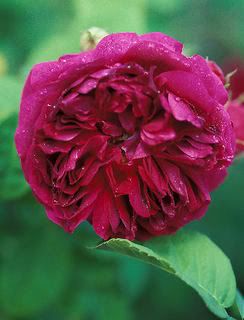 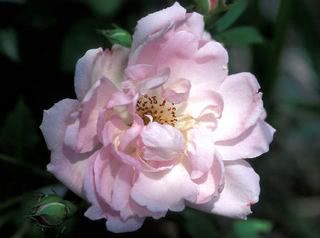  The first is R.centifolia ‘Jeune Henry’ Introduced by Vibert in 1815. An upright shrub getting to 4 foot. The flowers are a bright crimson fading to magenta. Very little scent. Has been known to be classed as Portland or Gallica ?? The next two are R.centifolia ‘ La Noblesse’ Introduced circa 1856 in France by Soupert et Notting. Will reach 5 foot has soft pink double flowers that have a single flowering season. The history bit For many years the “Cabbage Rose” of our great grand parents, or in my case knock off the ‘great’, time was considered to be a most ancient rose. With botanists and herbalist citing that it was grown by the ancient civilisations of both Greece and Rome. But, you will remember from the Damask section that this was The Autumn Damask and not R.centifolia . Modern research shows that our R.centifolia did not arrive until the 18th century. It transpires that the R.centifolia as classified by Linnaeus is not a wild species nor is it a simple primary hybrid a la Damask Roses . Further research shows that it is a complex hybrid between the following four species R.gallica, R.phoenicia, R.moschata and R.canina . Now the easiest way of doing that would be the crossing of The Autumn Damask (R.gallica x R.moschata) and The White Rose (R.canina x R.damascena). 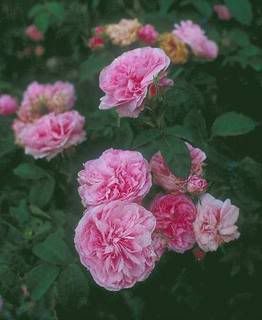 R.centifolia ‘ Petite de Hollande’ R.centifolia ‘ Petite de Hollande’ Unknown origin or date. It is a well-formed and proportioned miniature of the class, but perhaps a little more bushy. All parts are just reduced in size while the flowers appear to be held more erect/stiff. If you want a Centifolia and have a small size garden then this is the one for you! 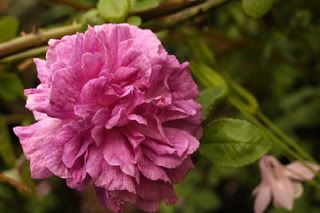 R.centifolia ‘Tour de Malakoff’ R.centifolia ‘Tour de Malakoff’ . Introduced in France by Soupert et Notting circa 1856. Opposite to the last one. This is a very large plant of lax habit. It has small leaves for its size; it can reach 7 foot or so! And should be supported to show the flowers at their best. The reverse of the petals are a light lilac, the half open bloom again is cupped and somewhat informal and is a vivid magenta, when the flowers get in full sun some petals will reflex and turn violet with many intermediate shades. Just before falling a grey-lilac hue is predominant. A bunch of blooms in various stages of growth can make an interesting show in a varse, vause or vase (Sorry could not resist. My pronunciation is the former) The Dutch painters of the 17th century used to paint R.centifolia at every opportunity. The reason I mention this is that if you compare earlier paintings with later ones you can see the evolution of R.centifolia , even allowing for artistic licence. Now to achieve such an evolution it would have been necessary to perform many crosses, including back crosses, giving many failures as well as successes. As those that have tried plant breeding will testify. Anyway what I am trying to say is, the process would not have been as simple as first implied above. The process started in the late 16th century and finished early in the 18th century and it was all down to the skill and industry of the Dutch breeders They started to produce them from circa 1580 and continued to try to improve the plant until circa 1710 at which point they decided they could go no further. Other breeders notably the French would continue to produce Hybrids into the 19th century. It is these that are, in common cultivation today. Soon after the Dutch breeders reached their decision to go no further the Moss Rose appears as a sport of x R.centifolia [/b]. It would have been a bud sport, as the parent R.centifolia , would have been virtually sterile due to its fully double flower. This ‘doubleness’ prevents the germ cells from reaching maturity in nearly all cases. 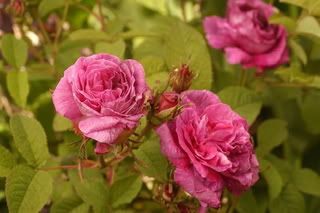 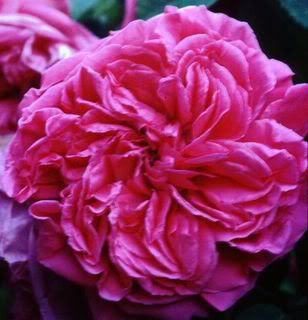 R.centifolia ‘Robert de Diable’ R.centifolia ‘Robert de Diable’ Introduction unknown. It is a late flowering lax shrub, it is almost procumbent and it’s 4 foot prickly stems are best displayed draped over a small wall or tumbling down a slope. The leaves are narrow and of a dark green. It is not a typical Centifolia . In fact if you look close you can see possible Gallica derivation, which is where it is sometime classed. The petals of the medium sized flowers will, all but the centre, reflex and show a variety of colour hues from lilac through to purple with highlights of cerise. Finally fading to violet-grey. Prefers dry hot weather. Don’t we all! So that’s England out then! R.centifolia ‘Paul Ricault’ Introduce France by Portemer in 1845 It has considerable charm and is one of the most free flowering shrubs. The flowers are fully double, once flowering and well scented. The plant will achieve 5 foot or more. Although the appearance is Centifolia it is sometimes classed a Hybrid Perpetual There are several more examples of “questionable class” within the group but who cares! 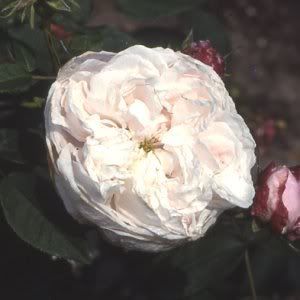 R. centifolia ‘Juno’ R. centifolia ‘Juno’ Laffay, France, 1847. An arching shrub with shoots reaching 4 foot. She partially fits the description of Hybrid Perpetual but is definitely not one. The flowers are ‘Provence Rose’ . The globular blooms of delicate pink open to a flat flower, showing a large button eye. Being of lax growth, would suit a position where she could tumble over a low wall or mound. 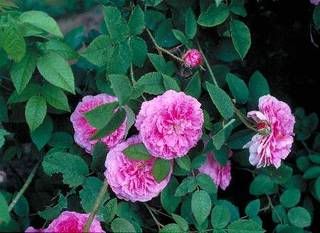 R.centifolia ‘Le Rire Niais’ R.centifolia ‘Le Rire Niais’ Dupont, France circa 1810. Maybe only Dupont knows why he named it so! It is a good graceful bush of some 4 foot, with mid green pointed leaves. Fragrant, warm pink flowers, fading to lilac/pink. 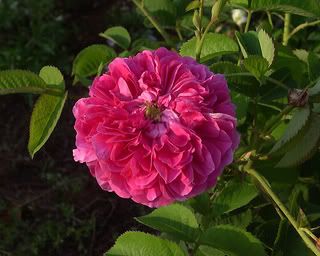 R.centifolia ‘ Justine Ramet’ R.centifolia ‘ Justine Ramet’ Vibert, France, 1845. A large lax shrub. Very prickly with good shaped leaves. The flowers are a rich magenta-purple, quartered and fragrant. The hep is almost non-existent below the flower. 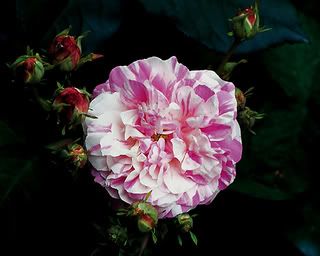 R.centifolia ’Variegata’ R.centifolia ’Variegata’ Introduced by Vibert from Angers in 1845. This is a Centifolia . The flowers borne singly or in clusters are globular and filled with thin petals, which do not like wet weather. The silky white blooms are streaked with pale pink. Very free flowering. The bush is vigorous, reaching 5 feet, and produces strong prickly shoots with dark green, toothed leaves.
|
|
|
|
Post by fozzie on Oct 29, 2007 18:01:37 GMT
2. Centifolia Roses: The Moss Rose - Section 2 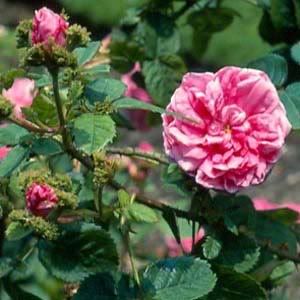 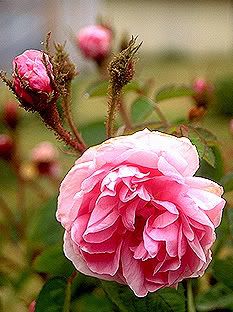 R.centifolia ‘Muscosa’ R.centifolia ‘Muscosa’ aka ‘Common Moss’, fine foliage of mid green, globular flowers of a clear pink opening flat, with button centre and a good scent. Grows up to 4 foot. I know at the top of this item I said Centifolias were not my favourite; however, there are some pleasing Moss Roses . The Common Moss above, being one of them. In these forms of the Provence Rose the sepals take on a major importance. These green segments that enclose the bud are arranged so that some edges lie over ands others under their neighbours, and they are always arranged they same way. The beards are elongated giving the effect of Moss, what really happens is that the glandular projections on both the sepals and flower stems, which adds to the fragrance of many “Old Roses”, are elongated. Thus giving the Moss appearance. There may also be an elongated leafy wing growth to the apex of each sepal. The ‘Moss’ is sticky to the touch and can be very fragrant. If you want to be botanically precise the following parts of the plant are also covered in these glandular branched bristles: petioles, stipules, pedicels, peduncles and calyx tubes.  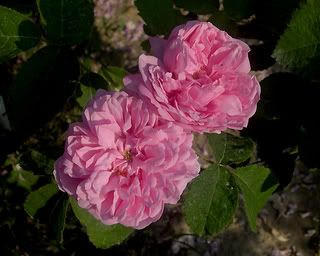 I have put these two next as I think along with the above they are possibly the most appealing of the Mosses R.centifolia ‘Muscosa Alba’ aka Shailers White Moss’ . This rose has all the attributes of Centifolia . The growth is lax and open; the leaves of mid green are well rounded. The flower stalks bear buds with long mossy calyces. The flower is less full than R.centifolia , but has the same papery quality, and the blooms are flushed with soft pink tint on opening, passing to pure white and reflexing quite flat with button eye. An occasional pink petal is produced. Very fragrant reaching some 4 foot in height and width. R.centifolia ‘Rene d’Anjou’ Introduced by Robert, France in 1853. Has the poise of a typical Centifolia . Will attain approx 5 feet of bushy growth. The young foliage is bronzy in colour. The buds are covered in a brown/green moss and open to a soft pink changing to a light lilac, both veined and crinkled and with a muddled centre. It is often said that the Moss Rose lacks some of the character of the true Provence Rose. Like all subjective observations, it’s all in the eye of the beholder. The Moss Rose comes in all shapes and sizes from the miniature Rose to the pillar Rose and a few bushy shrubs in between. There have been many hybrids produced, not all good. I’ll list a selection of the best, not my choice (they are really), but based on those that you can still purchase. In the early 20th century some hybrids have been produced that have the vigour and “Mossy” characteristics but with “loud/garish” modern colours, which do not sit well with “Old Roses”. It’s a shame really because they do not sit comfortable with the other Modern Hybrids (HTs) either. Perhaps the lesson is that certain plants are best as is. The Moss Roses filled a period in the development of Roses, so maybe should be left alone, to be enjoyed as a bit of ‘Victoriana’. In the garden Moss Roses have the same value as the Provence Rose , although on the whole they have a more robust and erect habit. 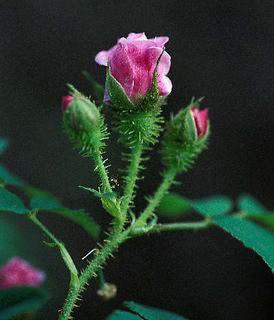 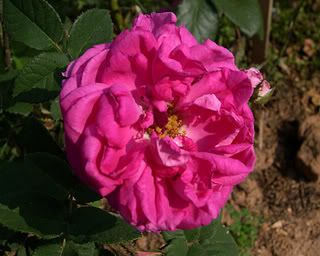 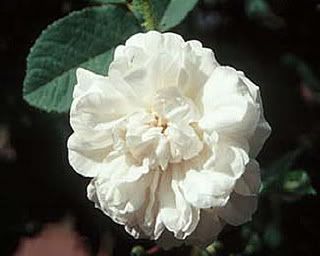 R.centifolia ‘’A longs pedoncules’ R.centifolia ‘’A longs pedoncules’ Introduced by Robert, France in 1854. A graceful rose, with clusters of long stalked blooms and neat foliage. The leaves are a soft green, the pale mossy sheaves of the buds open to a pink flower flushed with lilac. It’s a true Centifolia and will get to 6 foot. R.centifolia ‘Louis Gimard’ Introduced by Pernet Pere in France 1877.Very hard, densely packed cabbage like buds open to rich cerise-lilac flowers, flushed and veined with lilac, flat with muddled centres, the petals being rolled at the edges. Dark green pointed leaves will get to 6 foot. R.centifolia ‘Comtesse de Murinais’ Introduced by Vibert in France 1843.I try to avoid using verbs such as beautiful, unless I have first hand knowledge, (eye of beholder an all that), but all info on this rose use that descriptor. I am sure, those of you that have her, will let me know! It’s a vigorous shrub up to 6 foot, bearing light green, ribbed leaves. The blush white of the opening flower fades leaving a milk-white well formed flower with pronounced button eye. The petals will reflex flat and are sometimes quilled or quartered. The shoots/canes are well covered in prickles. The Moss is green and quite firm to the touch that may indicate a Damask Moss , remember that, derivation. The history bit, Moss Rose As per normal, lots of confusion. There are arguments that state the Moss Rose was introduced from into England during the 16th century. No evidence can be found to support this and there is no mention of them, by either herbalists or authors of that time. The first botanical reference was in 1720 by a guy call Boerhaave, in his book of plants cultivated at the Physic Garden at Leyden. It went under the name (your going to love this) R.rubra plena spinosissima, pedunculo muscosa . It was also alleged to be growing in London as mention in a catalogue of plants for a Kensington nursery circa 1724. A Mr. Miller, producer of a plant dictionary has it entered in the 1733 edition as (wait for it!) R.provincialis spinosissima pedunculo muscosa [/b] sub named The Moss Provence Rose It turns up again circa 1735 in a little place called Fulham in Middlesex (Broomhouse Nurseries, Broomhouse Lane) Our friend Linnaeus adds R.rubra plena spinosissima, pedunculo muscosa to R.centifolia where it has stayed under the name of the Moss Rose as a sub division. 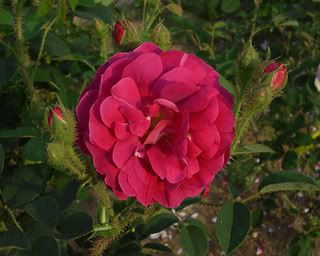 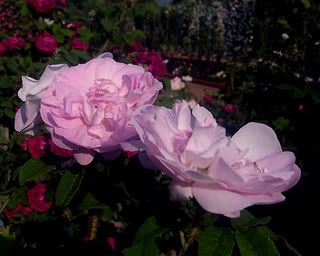 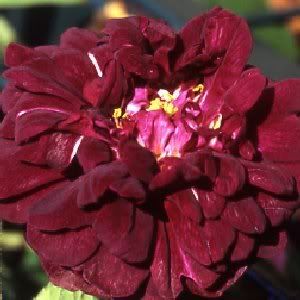 R.centifolia ‘Henri Martin’ R.centifolia ‘Henri Martin’ Introduced Laffay, France 1863. A graceful plant with wiry shoots. The foliage and scanty moss is of clear green. The flowers are not fully double, but are of a very clear intense shade approaching crimson, fading to a deep rose. The petals reflex with camellia like precision. Will tolerate shade therefore good for north facing aspect and will get to 6 foot. R.centifolia ‘General Kleber’ Introduced by Robert in France 1856. A good quality shrub, bearing a resemblance to R.alba. ’Celeste’ . The double flowers are wide and fragrant, in soft pure pink. The foliage and copious moss are a clear “lettuce” green. Will achieve 5 foot. R.centifolia ‘Nuits de Young’ Introduced by Laffay, France in 1845 Possibly one of the best known Moss Roses due to its growth habit, foliage and size and colour of flower. Will form a wiry thin bush of approx 5 foot, with sparse foliage covering of small and dark leaves burnished with metallic tones. The flowers are an intense purple, dark and velvety highlighted by yellow stamen. They are not fully double but reflex flat and do not fade with age. Flowers once at Midsummer. A little cultural tangent. ‘Nuits de Young’ or, as the linguists, will know Nights of Young. Now this name is, as was Night Thoughts, another name for a poem of some renown. Which, consists of some 10,000 lines of blank verse set in nine parts by an English poet named Edward Young. The full name of the poem is The Complaint: or Night-Thoughts on Life, Death & Immortality. It , the poem, was later illustrated by William Blake (satanic mills fame). There are other sports from R.centifolia they are, however, not so well known as the Moss Roses. So, maybe do not readily spring to mind. 3. The Rose Unique This is also known as the ‘White Provence’ or ‘Shailers White’. Its only difference from its parent is its colour. It is not a true albino as the buds are tinged with pink. Usually the flower is pure white when fully open but the five outer petals are tinged with colour. It was allegedly found in a garden in the eastern counties (Norfolk). I found this account while researching its origin. (I have applied the sub editors blue pencil) ”The Rose Blanche was found buy a Mr Grimwood, a nurseryman of Little Chelsea, whilst on a business trip to Norfolk in 1775. He purchased a cutting for a guinea; from this cutting he had three buds to use for propagation. The following year he returned and purchased the whole plant for a further five guineas. Over the next three years he paid his foreman, a certain Mr Shailer, 5 shillings per propagated plant while he sold the plants for 21 shillings (a guinea) each.” Now if you consider that Shailers share amounted to some £300, then he propagated some 1200 plants. Not a bad investment-return ratio. At that time a guinea must have been a fortune! (The area known as ‘Little Chelsea’ was in fact in Fulham just off Fulham Road and not a mile or more from Broomhouse Nurseries mentioned earlier!! In an area between Parsons Green, the River and Putney Bridge).  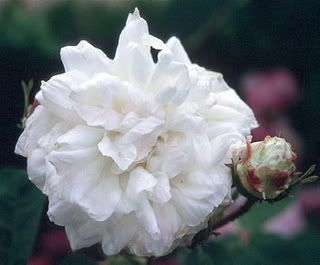 On the left R.centifolia ‘White Provence’ on the right R.centifolia ‘Unique Blanche’ . There is a school of thought that says they are two different plants (parallel sports from the same parent) others say they are one in the same plant?? Either way they are typical Provence Rose in growth, prickles and leaves. The buds with long sepals are red flushed; a half open bloom is cupped the central petals being held in place by the outer petals. A distinct button eye is surrounded by a starry display of white petals. Can achieve 3-4 foot with a single flowering season in late summer. 4. The Rose de Meaux This rose is a miniature of the Cabbage Rose . It differs only in that all its parts are smaller. The precise origin is unknown, but one Miss Willmott suggests that it arose from the garden of the Bishop of Meaux circa 1637. Regardless of exactly when it arrived there is no doubt that it is a bud variation of R.centifolia  R.centifolia de Meaux aka ‘Pomponia’ R.centifolia de Meaux aka ‘Pomponia’ A miniature up to 3 foot or so. It has Centifolia leaves but the flowers are not. They are those of a pompon, opening flat with a typical pink hue. She will flower much earlier than the larger Provence Rose 5. Moss Variations You will, of course, not be surprised to learn that both the above produced a “Moss” variation. In terms of genetics, if not surprising, it is, at least, interesting. Viz. you have a sport (bud variation), producing a bud variation, with the same ‘moss’ characteristics, of a similar bud variation produced by its parent.(phew) Anyway, these ‘Moss variation’ are Moss de Meaux appeared circa 1801 in the West of England (which I can find no picture) and Moss Unique appeared circa 1843 in France. See Shailers White Moss As a little sting in the tail I give you this hypothesis as put forward by Dr Hurst “ there are very few bud variations found in fertile Rosa such as damascena or gallica compared with the high numbers recorded with the near sterile centifolia. Is it possible that there is a connection between sterility and bud variation, are we to regard bud variation as an alternative mode of expression in the presence of sterility” Now there’s a thought. (All I can say is my little darlings are intelligent and they have worked out a way to ‘mutate’ despite us making them all but sterile!)Two miniatures and two pillars 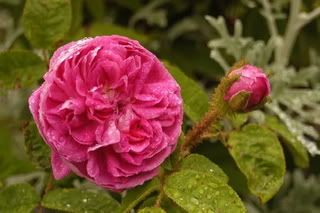 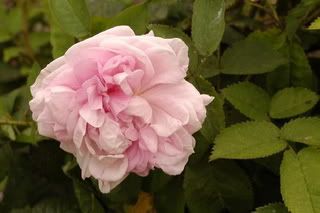 R.centifolia ‘Little Gem’ R.centifolia ‘Little Gem’ William Paul, England, 1880. A little rose growing to 3 foot is well covered with small neat leaves. The buds are not very mossy and reveal a flower of tightly packed crimson petals. These will open to a flat Pompon. R.centifolia ‘Mousseline’ aka ‘Alfred de Dalmas’ Portemer, France. 1855. Very compact bush up to 4 foot has spoon shaped leaflets; she flowers from June to October. The creamy cupped blooms are filled with high centres. Very free flowering, not very prickly and moss not conspicuous. All the above would indicate a Damask ancestry. 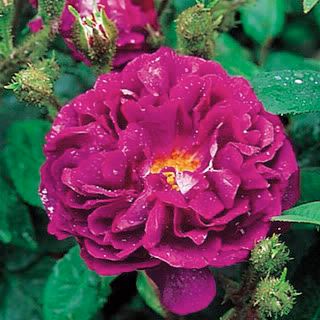 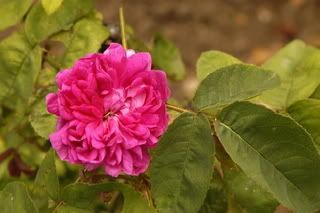 R.centifolia ‘William Lobb’ R.centifolia ‘William Lobb’ aka ‘Duchess d’Istrie’ Laffay, France, 1855. An amazing colour. The freshly opened blooms, large and double with a muddled centre, have petals of dark crimson with lilac reverse, fading the next day to a uniform lavender grey. The heavily mossed buds are carried in large clusters on strong stems, reaching some 8 foot or more. The foliage is small for the size of plant and is a dark green, will need support of other plants or can be trained on poles or up walls. If you’re near Kiftsgate Court they have it growing through ‘Albertine’ . Now there’s a thought I have one of them. R.centifolia ‘Jeanne de Montfort’ Robert, France 1851. Another vigorous grower reaching 8 foot or so. The bronzy, mossy stems have shiny leaves and large clusters of flowers. The buds are very mossy, with long sepals covered in brown moss, in contrast to the clear pink blooms with yellow stamen. Has been known to second flush latter in year. 6. Pruning Shrub Roses will continue to flower well even without pruning, but will end up as large and maybe congested shrubs. The main objective of pruning therefore, is to prevent the shrub from becoming too large or congested. The pruning should always be modified to suit the growth characteristics of the plant, but as a guide, shorten the main stem by about a third and any remaining side shoots by about 2 thirds. Cut out completely any dead, diseased or crossing stems. Always keeping an eye on the overall shape of the shrub. The frequency is up to you and how you want to grow the shrub. For example, if completed annually, you will encourage new growth from the base, keep it compact and have flowers close to the ground. Two Madame’s 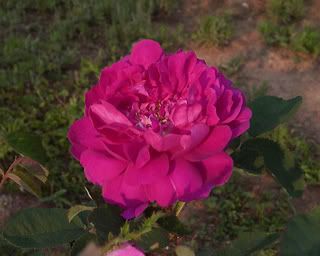  R.centifolia. ‘Mme Delaroche-Lambert’ R.centifolia. ‘Mme Delaroche-Lambert’ Robert, France, 1851. Purple/rose flowers of good size and bright colour, rolled petals and muddled centres. The buds are exceptional with their green moss and long sepals. The moss on the stems is brown and the leaves are a light green and rounded. Will get to 5foot and repeat flower till autumn. R.centifolia ‘Mme Louis Leveque’ Circa 1898. Of stiff upright growth up to 4 foot or so. Long pointed bright green leaves and little moss. The flowers are the largest of the group, possibly bred from a Hybrid Perpetual as it has a marked remontant habit. The blooms do not like wet weather and will tend to ball if wet. But, in dry weather will produce, large globular and fragrant flowers, reflexing slightly but keeping a soft pale pink. Looks a lot like ‘Mrs John Laing’, which is a HP. There are no specifics regarding pruning for R.centifolia . Having said that, it would not be a good idea to prune out all tendency to droop. This being part of their charm. The other thing to remember: cut back quite hard, in the winter, the side shoots of the perpetual flowering types, thus encouraging bushy growth and more flowers. Two Capitaine’s to go with the Madame’s above 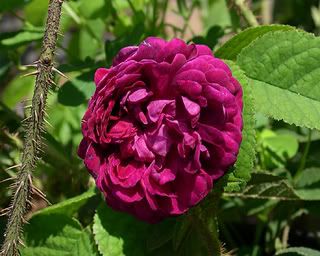  R.centifolia ‘Capitaine John Ingram’ R.centifolia ‘Capitaine John Ingram’ Laffay, France, 1856 A vigorous but dense shrub reaching 5 foot with small dark leaves and many prickles. The flowers are pompon like but open flat and compact from tight mossy buds. The first colour is a strong crimson, which changes to a softer purple and mottled with a number of tints. When fully open the button eye reveals the lilac of the reverse petals. Second only to ‘Nuits de Young’ for the darkest crimson colour. R.centifolia ‘Capitaine Basroger’ Moreau-Robert, France, 1890. Vigorous grower, another suitable as a pillar, or can be pruned to a bush. Lots of prickles, the bulging buds are only just covered by the green mossy calyx, which has nearly no wings. The flowers have an intense purple-crimson colouring, are cupped and reflexed will get to 6 foot. A little “stranger” in the camp? 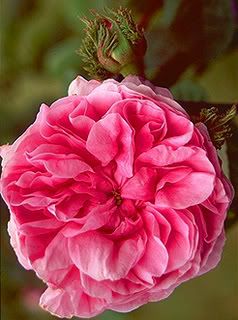 R.centifolia ‘Crested Moss’ R.centifolia ‘Crested Moss’ aka ‘Cristata’ Vibert, France, 1826. The wings on the calyx are crested and enlarged so much that the buds are almost enveloped. This gives a unique charm to the plant. It is sometimes fancifully referred to as ‘Chapeau de Napoleon’ as it resembles a cockade. It was first found in the crevice of an old wall in Fribourg, Switzerland in 1820. Thought to be a chance seedling. All other aspects are as R x centifolia It is not a true moss but thought to be a parallel sport. A few more before we go. 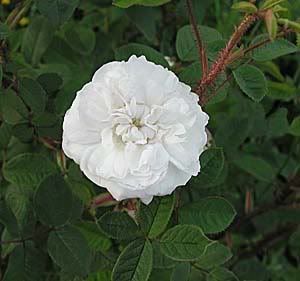  R.centifolia ‘Blanche Moreau’ R.centifolia ‘Blanche Moreau’ Moreau, France circa 1860. A good white Moss. The parents are listed as ‘Comtesse de Murinais’ and a Damask . It’s a vigorous, slender, lax plant up to 6 foot with many prickles and dark, brownish green moss. This dark moss contrasts with the small creamy-white flowers, very double. Can be either cupped or flat. There is little or no visible Damask influence apart from occasional repeat in autumn. R.centifolia ‘Japonica’ A slow growing and interesting shrub. Will attain 3 foot in height. The young shoots are covered in a clear dense green moss for their entire length; it spreads to the leaf stalks and is oft found on the pointed leaf surface. It is, of course, on the buds. The young foliage is frequently of metallic lustre lilac and coppery hues at the same time. The magenta/rose flowers reflex and fade to a soft lilac and are not unlike those of ‘William Lobb’ 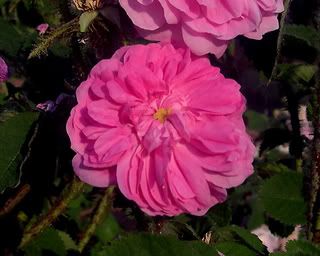 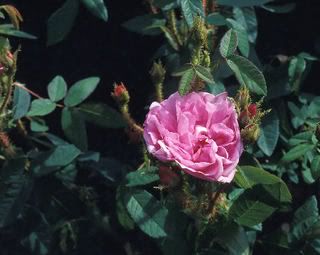 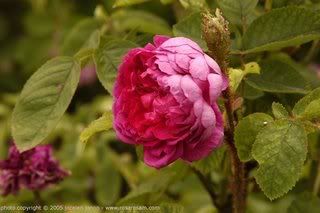 R.centifolia ‘James Mitchell’ R.centifolia ‘James Mitchell’ Verdier, France, 1861. Another vigorous plant reaching some 5 foot or so. But this shrub has a wide spreading habit, with neat bronze leaves. The brownish, green moss on the small buds creates quite a picture. When the plant is covered in flower either borne singly or in clusters its full garden value is evident. The intense magenta-pink of the buds fades to a soft lilac-pink in the flat, open flowers, each having a button eye. The flowers are said to be small for the shrub but the quantity and pompon shape more than compensate. R.centifolia ‘Duchesse de Verneuil’ Portemer, France 1856. One of the best and effective Moss Rose for the garden. Its bears a close relationship to ‘General Kleber’ with its pointed clear green leaves, she has flowers of a similar shape and clarity. The clear pink petals are paler on the reverse and show this in the button eye. A healthy shrub that will get to 5 foot in height. R.centifolia ‘Eugenie Guinoiseau’ . Guinoiseau, France 1864. Tall erect shrub up to 6 foot in height, with very few prickles. The leaves are rounded, dark and shiny and contrast the large fully double velvety blooms. They are cupped on opening reflexing with rolled edges thus making a broad round flower. The hues may vary from magenta to a soft grape purple fading to a lilac purple, but maintaining a rich claret colour at the centre. Will bloom again in autumn, has little moss, but long heps This is the last “chapter” referring to the pre Chinese groups. But before we go pell-mell into the post-Chinese groups. The next chapter will be a little diversion back into my comfort zone |
|
|
|
Post by fozzie on Dec 10, 2007 22:13:52 GMT
As said at the end of Part 7 this is a little interlude or diversion before we go to the post China Roses. I appreciate the title chosen covers the classes we have been through so far and those yet to be visited. It is however nicer than “Odds and Sods” which was my first choice. Some of the following you may have heard before under the Species heading (Part 2), but I’ll be brief and concentrate on the associated hybrids. Some of these ‘discoveries’ or hybrids were introduced quite recent, so much so, that some are younger than me!! Some may well be classed as Modern Shrubs, I’ll try and avoid those and leave them to Rosefan. Part 8 Hybrids from Species As I have said before the Species Roses and their very close hybrids is where I really like to be. But the majority are large and you would need a large acreage to do them justice. But I’m sure if you try you could find a home for just one somewhere, especially if I find a smaller one or two. There are a few sections here, and a lot of pictures. So here we go Section 1 Garden varieties/Hybrids of the Dog Rose and its Relatives. Our beloved native wild Rose, R.canina , the Dog Brier. A tough little shrub of (IMO) great beauty. Now I can say that cos, as you know I always have one somewhere in my garden. Bearing in mind that millions are raised each year as understock, it is quite likely that you have at least one, albeit, only the root in your garden. So next time you remove a “sucker”, treat it as a cutting and you’ll end up with a nicer shrub!! Its natural habitat would be in a hedgerow so if you have a large shrub or two just let it ramble through and around them. If you a lucky enough to have a hedge, well all the better.  ‘Abbotswood’ ‘Abbotswood’ a hybrid of unknown origin and date, from R.canina , some have it as late as 1954! That maybe when it got its name but was about much earlier Vigorous plant up to 6 x 6 foot. Has light green foliage. The flowers are a typical pink, fairly double and borne on arching branches in sprays. Heps are oval orange/red. Scented sweetly as R.canina At about 1800 several forms of Eglantine, a treasure of English wild flowers, were being grown. Very few have survived, but here are a couple. The original species R.rubiginosa had flowers of a clear pink, were well shaped and had a good fragrance, which was outdone by the aromatic fragrance of the leaves. This characteristic has to some degree been carried through to these hybrids. 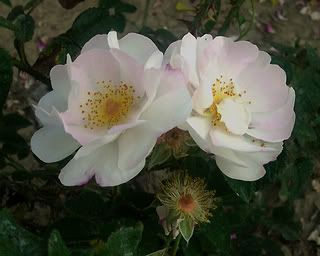 ‘Janet’s Pride’ ‘Janet’s Pride’ Introduced by Paul 1892. Allegedly found growing in a Cheshire country lane far from any garden influence. It is less prickly and vigorous than its parent, and bears faintly aromatic foliage. The flowers are a bright cherry pink with a white centre and have two or three extra petals. Gets to 6 x 5 foot. 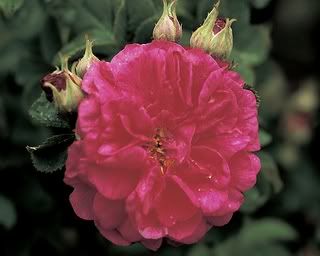 ‘La Belle distinguee’ ‘La Belle distinguee’ Again unknown origins. Grows to about 4 x 3 foot; leaves are a very dark green, tough but faintly aromatic. The flowers are flat, very double, deep red but not very fragrant. ‘Janet’s Pride’ is said to be the inspiration for Penzance to start his breeding of Rosa eglanteria so I’ll include some here. He produced about 15 varieties most very similar using Hybrid Perpetuals and Bourbons as the other parent. There were two exceptions, when he used R.foetida or her derivatives. 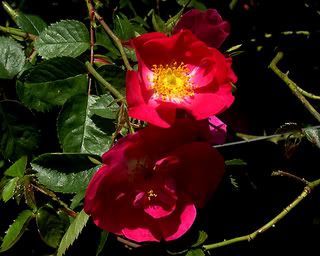 ‘Amy Robsart’ ‘Amy Robsart’ 1892 deep rose pink, large semi double flowers, scarlet heps. Grows to 5 foot leaves have an apple aroma. Flowers once in spring  ‘Catherine Seyton’ ‘Catherine Seyton’ 1894, soft pink single flower. Grows to 6 foot. Has retained the aromatic leaves from its parent. Flowers once 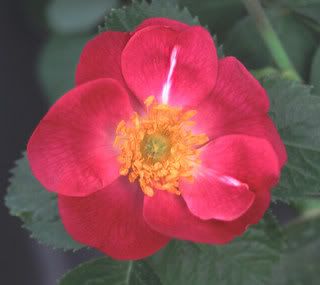 ‘Greenmantle‘ ‘Greenmantle‘ 1895 Rose crimson with a whiter centre, will grow to 6 foot or can be trained as a medium climber. The name Greenmantle rang a bell, as a character in a schoolbook so I looked it up. Yes, she was a character in Walter Scott’s “Redgauntlet”. It transpires that all Penzances’ Rose names have a Scott connection. Anther little snippet I have learnt! The two using R.foetida or her off spring are 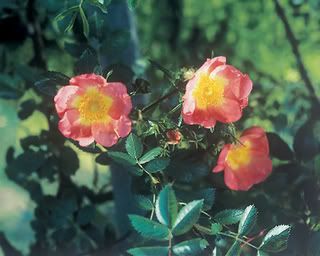  ‘Lady’ and ‘Lord Penzance’ ‘Lady’ and ‘Lord Penzance’ Her ladyship has [R.foetida var bicolor [/b][/I] as a parent while his lordship has an off spring called ‘Harrison’s Yellow ‘Lady Penzance’ 1894 Single flower, bright yellow centre, with a coppery salmon pink over most of the petals. Arching growth with aromatic foliage. Grows to around 5 foot and flowers early spring, will tolerate shade. Section 2 Garden varieties/Hybrids of the Yellow Roses. It so happens that most of the yellow species are in the same Group viz Pimpinellifoliae, now, when I last checked, I could only find hybrids using two of the group R.foetida and R.pimpinellifolia . But that was a few years ago. These roses form a rather diverse group as garden plants go but are grouped together in the group under some common aspects; They are upright growing shrubs with straight prickles, leaves small consisting of anything from 5 – 19 leaflets, narrow stipules, vertical sepals that stay on the heps that are rounded, red, orange or maroon. So we have an ordinary shrub with small leaves; no great attraction to the heps and only the colour in its favour. However the species in this group do add a lot of value. Those soft pale yellows and whites of early summer blooms compliment the lilacs and mauves of the rhoddies and vivid colours of the azaleas. And, all modern Roses owe their entire yellow- flame colour range to R.foetida . The use of R.ecae and R.foetida in the garden requires a little more thought, they are so bright that they really only sit comfortably with their own type or derivatives. The yellow is so insistent that it needs a rich partner or background such as a copper beach hedge to add tone. And in the case of ‘Austrian Copper Brier’ the flame colour also warrants some special thought. 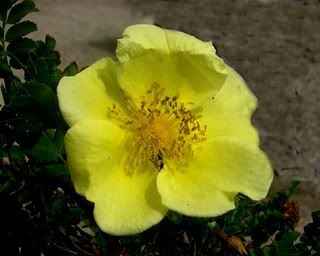 ‘Canary Bird’ ‘Canary Bird’ . One time distributed as R.xanthina spontanea [/b], under the impression it was a species all on its own. It is now considered as a hybrid, perhaps from either R hugonis x R.xanthina or maybe R hugonis x R.pimpinellifolia The richly coloured brown stems have few prickles towards the base but are covered with small excrescences (wart like). The small fern like leaves are of a bright green. The flowers of a bright clear yellow, open wide on long arching stems. It appears to be most at home in the drier parts of UK on well drained soil, reaching some 7 foot in all directions, that is up and across. Allegedly raised at Osterley Park. Date?? 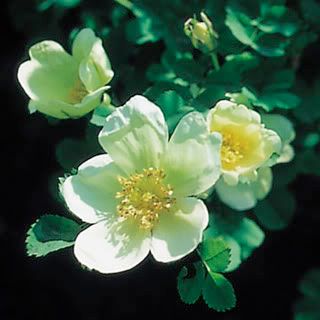 ‘Cantabrigiensis’ ‘Cantabrigiensis’ UK 1931 A chance seedling allegedly, between R.xanthina and R sericea occurring at Cambridge Botanical Garden. Possibly one of the best species like yellow Rose. She is an erect shrub of 7 foot by 6 foot densely covered by tiny hairy bristles on strong young growth. She has the ferny leaf effect of its parents but not the large wing like prickles. The five petalled flowers are of a marginally paler hue than R.hugonis but still a very clear yellow and opens wider than that species. Very free flowering with small orange red heps in summer. Fragrant. 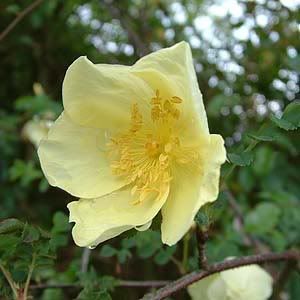 ‘Earldomensis’ ‘Earldomensis’ Raised by Page UK 1934 aka R.pteragonis pteragonis Why ?? Seedling from R.hugonis and R.sericea pteracantha Bushy ‘thorny’ shrub with some of the reddish flattened prickles of the father, mums are always quoted first on a hybrid. Small leaves, bright yellow flowers early in the season 7 foot by 7 foot. ‘Golden Chersonese’ Raised by Allen in Ipswich 1963 ‘Canary Bird’ x R.ecae Fern like foliage and bright yellow flowers that benefit in size from ‘Canary Bird . Flowers early in season. Fragrant, erect bush to 8 foot by 8 foot.  ‘Headleyensis’ ‘Headleyensis’ Raised at a house called Boidier, at Headley near Epsom circa 1920. The seed parent was R.hugonis possibly pollinated by R.Pimpinellifolia Grandiflora She is a strong plant that will reach some 9 by 12 foot. Good creamy yellow single flowers, very fragrant. It is possible the most ornamental yellow rose shrub from R.hugonis G H Thomas is surprised it has remained in obscurity for so long. You would need some garden to house her! 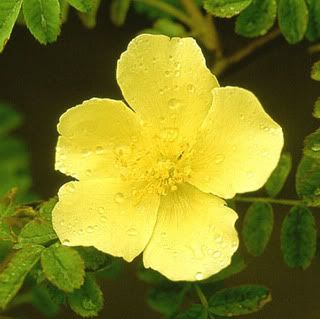 ‘Hidcote Gold’ ‘Hidcote Gold’ UK 1948, still younger than me! Raised at Hidcote, but not recorded anywhere. Parents thought to be R.hugonis and R.sericea pteracantha’ There is no doubt re the pollen parent (father) as it bears the same flattened prickles. It’s a graceful plant with long branches getting to 7 foot, and having drooping side shoots that are covered in clear yellow single flowers. Section 3. Garden varieties/Hybrids of the Burnet Roses I love this research bit, it’s amazing what you come up with. Here, I quote from Gerard’s Herball dated 1597 with all its quaint spellings. “The Pimpinell Rose was found groweth in a pasture as you goe from a village hard by London called Knights bridge unto Fulham a village thereby.” (The first pastures would now be Kensington with Chelsea being more pastures, no wonder they cannot play football there!) This early reference would probably be the reason Linnaeus named the species R.Pimpinellifolia . This species has the widest distribution of any, and as such has a number of variations occur in nature, the plant can be found growing from Iceland to eastern Siberia and as far south as the Caucasus and Armenia. Around the coast of GB it grows in the sand dunes and may only reach some 9 inches, whilst other variants will get to 6 foot or more. The species will spread easily by suckers, has large numbers of straight prickles with an even larger amount of hairy bristles. It has small fine leaves of between 7-9 leaflets. The flowers are also small and are borne singly on short stems coming from leaf axils, flowering once in early summer and then followed by near black heps. It was the flowers that attracted the breeders to this species; she was as profuse with them as she was with her prickles. If you look back into history you will find that she became a favourite, more in Scotland than England, during the 19th century, with over 200 varieties listed by some Scottish nurserymen. I’m sure she will forgive me for saying but she was so easy to breed from that her off spring popped up all over the place, sometimes quite literally. The naming and recording of these names left a lot to be desired so today it is difficult to find any meaningful history or sometimes the correct name! So if you struggle to locate some of these do not blame Foz. First the species, only because I like it!  Now some of the garden varieties. ‘Andrewsii’ . Grown a lot in France, sometimes difficult to find in UK. Appears to like a warm dry climate and light soil. The semi double or double flowers are cupped, of clear rose pink and possibly the largest in group. Being of dense bushy growth to 3 foot or so will make a good hedge. 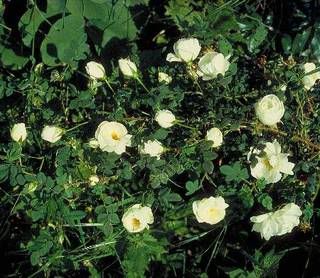 ‘Double White’ ‘Double White’ . This could be ’William IV ’ as recorded by Rivers or ‘Duchess of Montrose’ . (I had a locomotive called that), as listed by Austin. Is a very free in growth reaching 5 foot. The fully double flowers of pure white have long petals and as such remain cupped when open. Has a very strong fragrance, some say as fresh lily of the valley. 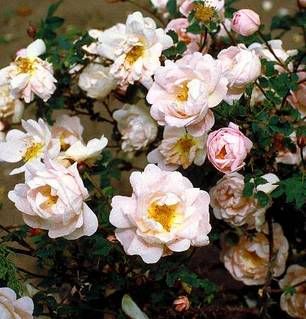 ‘Falkland’ ‘Falkland’ has greyish green leaves, which make the perfect backdrop to the semi double flowers. Which are of the softest, palest pink with a hint of pale lilac. They will fade to white in the summer Sun. grows to 4 foot. 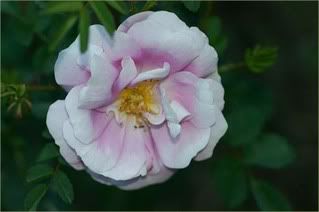 ’Irish Rich Marbled’ ’Irish Rich Marbled’ has soft pink buds that open a deep cherry pink with lilac reverse. Semi double with 3 rows of petals, the outer ones reflexing fully, has a yellow centre 4 foot.  ‘Mary Queen of Scots’ ‘Mary Queen of Scots’ Quoted as a most beautiful form, the story goes that the Queen brought it back from France. The grey lilac buds open to double blooms. The surface, of who’s petals are a rich plum. Grows to 4 foot. 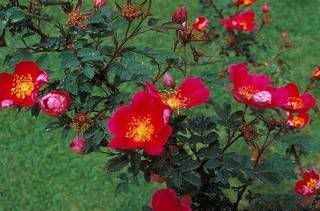 ‘Single Cherry’ ‘Single Cherry’ Bluish green foliage. The bright rose pink buds open to a vivid, intense cherry red flower. Reaches 3-4 foot. 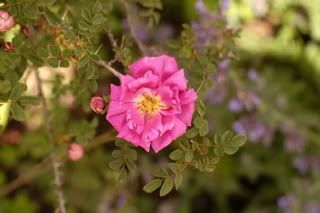 ‘William III’ ‘William III’ Very dwarf but vigorous. Grey green leaves, thickly covering the dense thicket of shoots. Semi double flowers showing a few yellow stamens, magenta-crimson fading to dark lilac pink. Reverse is paler. Black heps, up to 2foot. Now for some of the Hybrids.  ‘Stanwell Perpetual’ ‘Stanwell Perpetual’ . Regarded by some as a real treasure and likely to remain in cultivation for as long as roses are grown. Reason; its perpetual flowering throughout the season, and its very heady sweet scent. It was a chance seedling in a garden at Stanwell, Middlesex, and put onto the market by Lee of Hammersmith in 1838. It is presumed to owe its perpetual flowering to that most famous of groups Gallica , probably ‘Autumn Damask’ . It can grow to a 5 foot, lax, thorny and twiggy shrub. With greyish small leaves resembling R.Pimpinellifolia , which is no doubt its other parent. The flowers are of a pale blush pink opening flat with quilled and quartered petals. Its main display is mid summer but never without a few blooms during the season. 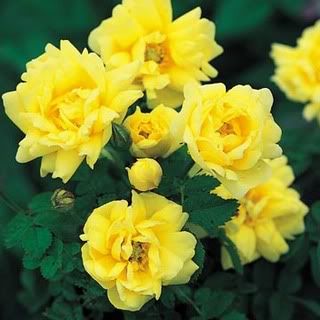 ‘Williams Double Yellow’ ‘Williams Double Yellow’ aka R.pimpinellifolia lutea plena’ or ‘Old Double Yellow Scots Rose’ . Raised circa 1828 by John Williams, Worcester from seeds obtained from R.foetida She makes a freely suckering, branching prickly bush to about 4 foot high, with neat leaves and loosely double, yellow flowers. These have green carpels at the centre. The scent is as R.foetida and the petals reflex. The last time I say this was at the NT property of Upton house, near Banbury. That was when I was rich and lived in the south. Now I’m poor and live in the North I only get to see Lakes, Mountains and Moors. This plant is often found in the gardens of the Western Highlands were it goes by yet another name ‘Prince Charlie’s Rose’ |
|
|
|
Post by fozzie on Dec 10, 2007 22:15:55 GMT
Part 8 continued Section 4 Garden varieties/Hybrids of the Cinnamon Rose. This group contains R.moyesii and R.rugosa the former is another favourite of mine and always found in my garden. It is however a little monster getting to some 12 foot. R.moyesii .  This is the first and only flower, this year, on the shrub in our new garden. 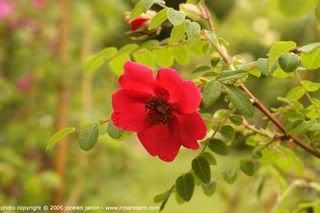 R.moyesii R.moyesii She was introduced into cultivation in 1908, by Wilson following an expedition to Western China. She has brilliant red flowers borne singly or clusters. Achieves 12+ feet on, what seems to be, a few stout, prickly stems. The leaflets are between 7-13 and are a dark bluish green. “Although the flowers are such a good colour, they are out done by the heps, which are equally colourful but have the added feature of being “flask” shaped” I found this quote allegedly from a rosarian. “The heps are indeed very good, but they only add another interest to the shrub”. You cannot beat this flower (my opinion, of course) and the word “Rose” will always bring this flower to mind. You may hear me prattle on about this rose or that rose, but this is the one. Some get very, very close, but nothing beats it. Here are some hybrids 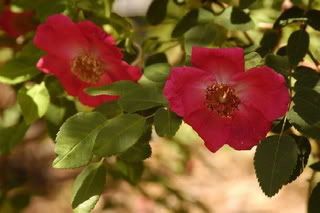 ‘Sealing Wax’ ‘Sealing Wax’ raised at Wisley, of more compact growth only reaching 9 foot.  Heps of R.moyesii ‘Geranium’ 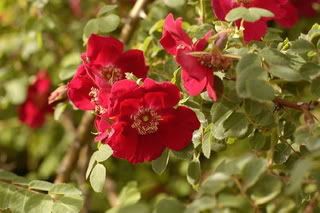 R.moyesii ‘Eos’ R.moyesii ‘Eos’ both parents being vigorous growers, this will get to 12 foot. Sending up stiff arching shoots that are clad with small foliage of dark green. The next spring they will turn a coral red when they are covered with nearly single flat flowers. Its well named as “Goddess of the Dawn” as those colours appear at sunrise. 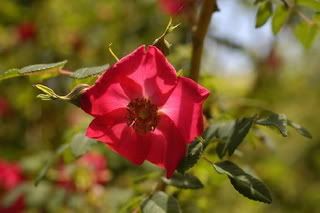 R.moyesii ‘Highdownensis’ R.moyesii ‘Highdownensis’ Appeared in the garden of Highdown, Goring-by-Sea. Slightly softer red than that of its parent, also more bushy and carrying copper tinted leaves. The flowers are borne in clusters and followed by large orange-scarlet heps R.rugosa . A good group of Roses. But, they are much maligned and misunderstood. They have two disadvantages. First mention Rosa rugosa and everyone gets a mental picture of that plant used as an understock, especially for Standard Roses, what ever they are, or used by local councils in “difficult” areas like road sides, roundabouts, car parks parks. Secondly, they do not fit as cut flowers so have lost a lot of ‘press’ at shows or in the home. I have nearly trained Mrs F to appreciate flowers, all flowers, on the vine, so to speak. My only failures are Sweet pea and Miscanthus. She, R.rugosa , that is, is a native of north-eastern Asia, northern China, Korea and Japan. First recorded botanically in Europe by Thunberg 1784. First introduced to UK from Japan in 1796 by Messrs Lee and Kennedy of Hammersmith as a novelty plant. It failed to be come popular for the fad for things “oriental” was over and “flower shrubs” were not yet popular. It also added nothing to what was already there. If we look at her today; we find a rose with few faults. She is extremely hardy; bushy; thrives on sandy and other soils, although not very good on heavy clay. The opposite to her relatives. She will flower from May till autumn, bear’s good heps and provides autumns leaf colour. She has a variety of colours and a good fragrance. Her petals are used as pot-pourri and the heps are used for making preserves. Speaking personally I have seen no diseases on her or any varieties that I have and pests do not make any impression on her. Having laid out that list of merits she is hardly the most popular shrub. From a garden prospective she grows quite feely, sets lots and lots of viable seed, she will hybridise with nearly any other rose growing near, so just collect the seeds and see what happens. Down side, the double flower varieties are not as good as the single flower varieties. Excessive prickles, which she likes to pass on to her off spring, often with interest. (This could be an advantage if you want a “Keep Out” hedge.) Suckers may be an issue on light soils. She will form a dense rounded shrub usually as high as she is wide, covering the ground with many shoots, all protected by large and small prickles and numerous bristles, making them near impenetrable. The leaves are 7 – 9 leaflets are glossy, veined and sometimes corrugated and cover the plant in a rich green that turns yellow for the autumn. The flowers are borne singly or in small clusters on short shoots.  As in my garden ‘Blanc Double de Coubert’ raised in France by Cochet-Cochet in 1892. Allegedly has ‘Sombreuil’ as the pollen parent. Now I have both and can see no trait of alleged hybrid pollen parent. The pure white blooms, semi double and have a slight blush tint in bud, gets to 6 x 5 foot 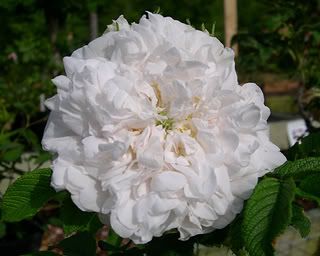 ‘Souvinir de Philemon Cochet’ ‘Souvinir de Philemon Cochet’ Cochet-Cochet France 1898 Sport from ‘Blanc Double de Coubert’ It differs in floral shape only, this is a fully double version. There are many more but these are usually described as Modern Shrub roses e.g. Frau Dagmar Hastrup, Scabrosa and Roseraie de l’Haÿ Only a couple more, but I’ll lump them together. Section 4.Garden varieties /Hybrids of R.roxburghii, R.stellata and R.persica The heps on many roses bristly but only a very few are actually prickly, like those of a horse chestnut, though smaller. There are three species in cultivation with this characteristic. Two are very closely related R.stellata and R.mirifica , so close that sometimes the latter is quoted as a variety of the former. The other species is R.roxburghii aka R.microphylla is totally distinct. The first two are small wiry shrubs, R.roxburghii is a much larger plant all together. R.roxburghii aka R.microphylla or the Burr or Chestnut Rose She is a native of China and Japan, make a large shrub of up to 9 foot. The angular-branching stems have flaking buff coloured bark, attractive in the winter months. A very difficult shrub to work on, she is heavily armed with pairs of straight prickles, hiding below the leaves, on the rigid shoots. As many as 15 leaflets may be present, the flower colour varies from pure white to deep rose supported by stalks and calyx, which are equally defensively covered in prickles.  R.roxburghii var normalis R.roxburghii var normalis Presumed cultivated in China date unknown. Introduced circa 1900. It’s the single type. The four-inch flower is “beautiful” but shy as they hid themselves under the leaves. Can get to 9 foot. There is a double version R.roxburghii var roxburghii Introduced into UK in 1824. But, not so worthy as the single flower type. 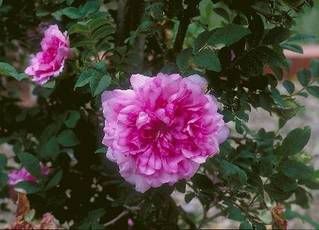  ‘Triomphe de la Guillotiere ‘ ‘Triomphe de la Guillotiere ‘ Guillot, France 1863. Pollen parent unknown! The dainty leaves are divided into leaflets, indicate R.roxburghii as the seed parent. The flowers are borne singly or in clusters, are a light rose pink, fragrant about 3 inches across, tightly filled with petals and with a button eye These last two are really very close to Species and possible only of interest to the plantsman, not very PC, but then I try to avoid being so. We used to have a Chairman but now apparently we talk to a chair!! But I’ll include them anyway. 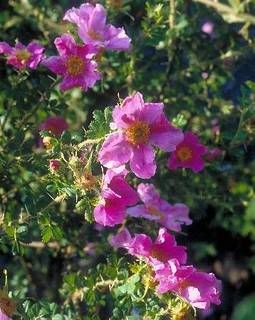 R.stellata var mirifica R.stellata var mirifica aka ‘Sacramento Rose’ New Mexico. Forms a dense shrub, filled with wiry stems of up to 3 foot that branch easily and are set with sharp prickles, of an “ivory” colour when young. The stems themselves are quite smooth. The leaves are interesting as they can be sometimes only 3 leaflets, but normally 5. The singly flowers are silky and like a cistus, the colour being a soft pale pink. This one really is a specialist plant R.persica although we all know and love her as R.persica she has been reclassified as Hulthemia persica which is a separate genus, so technically not a rose! Being a ludite I ignore things like that. She is a very strange little shrub of a few inches high that spreads by underground runners, throwing up small shoots bearing single, not pinnate grey green leaves. The flowers are a brilliant buttercup yellow and have a scarlet blotch at the base. There is a single natural hybrid namely R.hardii or to be botanically correct x Hulthemia hardii It was introduced by a Mr a Hardy, circa 1832(you remember him from Damask fame) he found the chance seedling whilst employed at the Luxembourg Gardens in Paris between 1829 and 1847, he cultivated many seedlings the most famous of which is the lovely white Damask ‘Mme Hardy’. This is the only picture I could find but it does not do her justice! 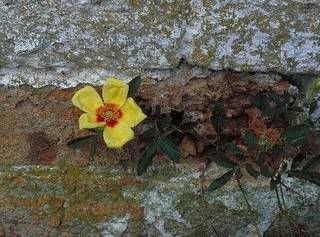 R.hardii R.hardii is very difficult to cultivate and keep alive; being a short lived specimen and readily succumbs to mildew. It is her flowers that keep her in cultivation they larger than the parent being 2 inches across and still have that red blotch at the base, albeit larger. There was a reputedly a specimen at Cambridge and one that grew to 9 foot at Berkeley Castle, Gloucester. A few people believed that these plants could be the way to a new breed of hybrids. Harkness performed a lot of work at around the mid 20th century, to achieve new hybrids using seeds from R.persica . They all proved to be sterile, or, not commercially viable seed. So the breeding stopped. But I found a few. Although strictly speaking they would be classed Modern Shrubs Euphrates, Tigris and Nigel Hawthorne 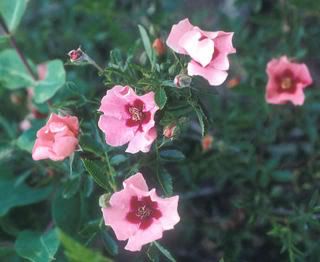 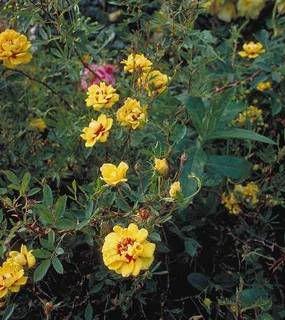 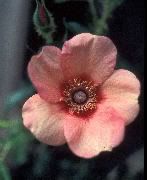 This was supposed to be just a little interlude cum diversion but got carried away as usual. I have not included much history, techy stuff or pruning info but if you need to know re pruning, then treat them all as Species and you’ll not go far wrong. Not so sure I found any really small examples, but maybe, just maybe you found one that appeals. They are, after all, just shrubs.
|
|
|
|
Post by fozzie on Dec 10, 2007 22:16:33 GMT
Both part 9 and part 10 in one posting Part 9 The Post China Roses First and only part with no pics but it has to be! And I kept it as short as possible In part 1 we looked at the history and development of The Rose. One of the most, if not the most important developments was the introduction of the China Roses . This took place circa 1800. The China Roses are at the very foundation of all our modern roses, be they bedding, shrub or perpetual flowering climber. There are 4 China Roses alias the 4 stud roses, to whom we owe the introduction of Tea Roses, Noisettes, Bourbons, Hybrid Perpetuals and eventually Hybrid Teas. All these groups are so inter-related and come into being at or around the same time that it can get very confusing. Before we look at those individually we need to do this….. Very Early Techy bit! Sorry You may or may not remember from Part 2 Chinas that we touched, albeit very, very scantily, on the subject of “recessive” genes. Well I’m sorry, but we have to go there again. Only this time a little deeper, it will become obvious why as we journey through the next few Parts. I am going to break a rule now by making an assumption. And that is, that you, dear reader, have little or no knowledge of genealogy, if I am wrong I apologise. We are going to look at something called “Mendel’s Law of Segregation”. (Georg Mendel 1822-1884 Austrian Monk). The segregation here is of the characteristics of the parents. In animals it could be colour of hair, eyes, skin or height. Now in plants it could be, for example, the flower colour, flower shapes, flowering period and plant height amongst others. I will keep it as simple as possible, for my sake as much as anything else. So I am not talking down to you, just bringing it down to my level! Mendel’s conclusion on his experiments 1 Pure lines these will breed true for a particular characteristic both genes in the pair are identical (AA or aa, or whatever the nomenclature is.) 2 These characteristics are carried in something called an allele or gene. 3 Each parent has an allelic pair/ gene pair, in each cell, for each characteristic. 4 The gene pair split when producing gamete (egg/sperm/seed/pollen) so each gamete will only contain one of the gene pair. 5 Gametes unite at random and irrespective of the other gene pairs involved. (ie having the repeat flower gene does not affect, nor is it affected by, the colour of flower or height of the plant.) For this argument we have two “pure line” plants. If parent 1 were once flowering only the gene would be, for this example, AA If parent 2 were repeat flowering then its gene would be, for this example, aa If crossed you would get an Aa gene pair at the F1 stage, meaning that it has the capability to produce either characteristic, but will only produce the dominant one. Which in our case is once flowering, the other recessive one is not changed in any way. And both can be passed on unchanged. Now we have two more expression. Dominant gene; that which expresses itself at the expense of the other gene in the gene pair at F1 Recessive gene; that which is suppressed in the presence of the dominant gene at F1, but will reappear at F2 If we self fertilise our F1, and using the above conclusions, particularly 5 we get the following gene pairs AA, Aa, aA and aa at F2 (Hope you are all still with me) You will notice two things, we have two pure lines (AA and aa) and two intermediate (Aa and aA). What concerns us is that result is a ratio of 3:1 in favour of Once flowering, or only 1 in 4 will have a "pure line” repeat flowering gene, so will repeat flower through the season. The other 300 or 3000 or 30,000 seedlings being thrown away, well perhaps not; some turned up as something called China Hybrids. But many thousands would have found their way to the big compost heap in the sky! (As they still do today. Yes, even I throw some away!) Mendel also discovered that if you self an F2 the same 3:1 ratio will appear, along with the 2 Pure lines i.e. (AA AA AA AA, AA Aa aA aa, AA,Aa,aA,aa and aa aa aa aa). Not too painful I hope If nothing else it is mildly interesting and of course can be applied to you and me! Mendel is often quoted as being the father of genetics, and was in opposition to Darwin. The truth, I suspect has elements of both theories/laws. Mendel completed all his experiments on Peas! (Now just a little aside, you now know that if you sow seeds, collected from a F1 plant, you’ll have a 3:1 chance of getting the same plant or a 1:3 chance of getting a pure line. So all that about F1 seeds not coming true, is not strictly correct. The only problem being is it self-pollinated? And what are the chances of all the characteristics, you want, coming true in the same plant?)  ‘Little White Pet’ ‘Little White Pet’ You knew I could not leave you without any pictures. This is a little something I found; en passant, both Beale and Austin have her in their catalogues. (This does mean she may find herself looking up at some of my larger specimens, but I’m sure she will hold her own!) Do not believe their classification of her as a ‘Modern Shrub’ or ‘Polyantha’ . She is, in fact, a “sport” from ‘Felicite Perpetue’ herself a ‘Sempervirens Rambler’ introduced in 1827. Therefore ’Little White Pet’ is neither a ‘Modern Shrub’ nor Polyantha’ . She is a perpetual flowering plant that seldom reaches more than 2 foot and is rarely without a cluster of her tight packed rosette-flower of creamy white. A very free flowering plant. Introduced in 1870’ish by Henderson, US. All this investigation into different classes and groups is costing me a fortune. The ‘to get’ list is overflowing! |
|
|
|
Post by fozzie on Dec 10, 2007 22:17:17 GMT
Part 10 The Bourbon Roses Lots of picture in an attempt to make up for Part 9  ‘Rose Edouard’ ‘Rose Edouard’ Allegedly the original ‘Bourbon Rose’ as propagated by nature on the L’Ile de Bourbon. Will get to 5 foot, fully double pink flowers. Occasional repeat showing her ’ Damask’ parent. Two extremes from the original 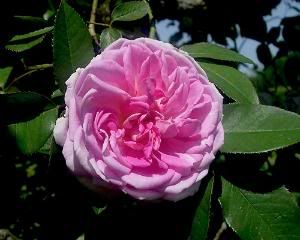  The first is ‘Blairii No2’ Raised by Mr Blair, of Stamford Hill in 1845. Can be seen at Hidcote manor, Gloucestershire. This is a vigorous reaching 15 foot and best grown as a climber or pillar rose. She will produce long shoots bearing rich brown tinted foliage. The flowers are large and very double they open a rich pink colour, which is retained at the centre while the outer petals fade to a pale pink, also veined. She would also be happy if planted amongst other shrubs through which, her long shoots would meander. There is a No1, which is all together a more compact plant ‘Boule de Neige’ Lacharme, France, 1867. A small, slender and erect shrub that will reach some 4-5 foot. Constantly pushing up new shoots of dark green foliage. The flowers are in clusters and are borne from June till October. The buds are tinted crimson and open to flowers of a creamy white, densely packed and shapely. The petals reflex to nearly make a ball. The roses in this section represent some of the first output from hybridising certain ‘Old Roses’ with ‘Chinas’ probably ‘Old Blush’. The ‘China Roses’ have a lot to answer for, and not all for the good. Over the years they have corrupted the “perfections” of the ‘Old Roses’. However, I do concede that, some of their early progeny are worthy garden plants. (I do have three in my garden, though Lancashire may not be ideal, weather-wise) 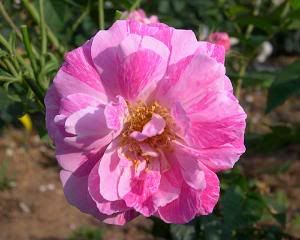 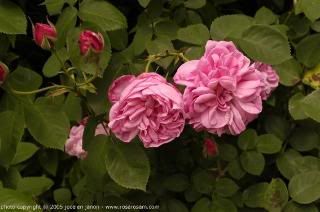 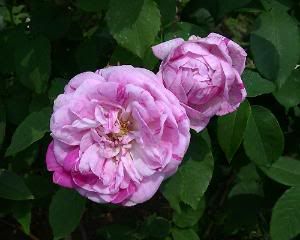 ‘Bourbon Queen’ ‘Bourbon Queen’ Breon-Mauget, France, 1835An old favourite, which can still be seen displaying her semi double magenta and pink flowers, mainly in June. The flowers are cupped and loose with crinkled petals that are veined with a darker colour. As a climber will reach 12 foot or there about. But can easily be pruned to a manageable shrub. ‘Champion of the World’ Introduced circa 1894. To me, a very strange name for a rose. I can find no other details apart from a description. For one introduced late in time, it still maintains an affinity to the refined ‘old style’ of ‘Louise Odier’. Has small light green leaves and brown pickles. The crimson buds give way to medium sized reflexed flowers a soft pale pink with some lilac tints. Will get to some 5 foot or so and flower all through summer into autumn. ‘Honorine de Brabant’ Introduction unknown. A vigorous growing, sturdy shrub of up to 6 foot. Shows signs of a “relationship” with ‘ Beaurepaire’ has shoots with few prickles but they are large, good mid green foliage. The main flowering is mid summer, but she is seldom without till autumn arrives. Her flowers are informally cupped and quartered of a pale pink, striped and splashed with mauve-violet tones.  ‘Commandant Beaurepaire’ ‘Commandant Beaurepaire’ Moreau-Robert, France 1874. This is an amalgam of quotes from several sources. “This is one of the, if not the, most spectacular striped roses, containing in its flowers shades of light carmine-pink, splashed or striped with rose-madder, carmine, purple and an occasional splash of scarlet on the inner surface”. It has arching; prickly shoots that will have numerous blooms open at the same time. The flowers are double, loose and cupped. In contrast the leaves are long pointed and of a light yellow/green colour. The Flowers will appear at mid summer. I had to look it up and this is what I found; Rose madder: A distinctive, transparent red. Made from madder root. Also known as madder lake, madder pink. 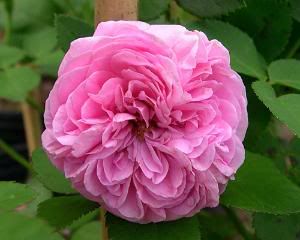 ‘Louise Odier’ ‘Louise Odier’ Margottin, France, 1851. A rose of vigorous growth to around 6 foot, bright green leaves. Constantly in flower from June till October. She is a Bourbon that is full of old world charm and perfection. Each bloom shows a face that appears to be made up of circles of closely laid petals, of soft pink tinted lilac. General Description A typical Bourbon will have the arching growth showing its ’ Damask’ ancestry, with the lush flowers and fragrance from much the same source; but it will also have a strong tendency to “repeat flowering” from the China ancestor, as well as a certain, often subtle, influence of the China flower form. Bourbons, however, are often not typical at all, as a result of either hybridising or segregation and range from the tall arching growth just mentioned to the very dwarf, China-like growth 'Hermosa', indeed one of the oldest Bourbons still available They range in colour from deep reds through pinks to blush and white. They are generally hardy down to Zone 5 (-20F to –10F or –29C to – 23C). The best flowers will often be those, which appear after the first flush of blooms, in say late July through to September. Those in the first flush of blooms will sometimes seem that little bit poorer in quality. It’s as if they are a practise run. I do not know why, it just seems that way. Harking back to the techy bit there are some in this class that will only flower in spring.   ‘Hermosa’ ‘Hermosa’ Introduced in France circa 1835-41. The flowers are cupped, plain lilac-pink, fully double, of good substance, with a delicate scent. It flowers particularly well in autumn, even in wet seasons when other roses fail. Prickles few; leaflets smooth, bluish beneath. Will reach 4 foot. Supposedly, she appeared, independently at four nurseries between 1835-1841. Segregation ‘throwback’ to a ‘China’ ancestry? She is sometimes class as a ‘China or China Bourbon Hybrid’. ‘Great Western’ Allegedly Laffay, France 1838. I suspect it maybe later say 1840. SS Great Western was not built till 37 and did not get awarded the “Blue Riband” till ’38 for her 15 day crossing from Bristol – NY. Averaging 6ish knots per hour, not bad for a paddle ship!(Gods Wonderful Railway) another passion of mine, and living in London meant Paddington station was a second home. Enough of that, back to the rose. A fairly open vigorous shrub of well rounded, quartered magenta-crimson blooms, tinted purple. She only flowers once at springtime. 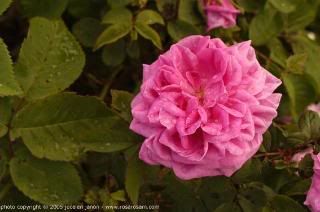  ‘Heroine de Vaucluse’ ‘Heroine de Vaucluse’ Robert et Moreau, France, 1863. A large open shrub, reaching some 5-6 foot, lax growth with good foliage. The flowers are a dark crimson, fading to lilac-pink. Cupped and quartered; the petals have rolled edges. Good scent. ‘Charles Lawson’ Circa 1853 of unknown breeder/introducer. A vigorous plant that would benefit from support so would be good on a fence or a pillar. The flowers that only appear once at midsummer are large loose and a soft pink will get to some 8 foot or so. They seem to be enjoying a bit of a revival amongst the Rose enthusiast, even though their popular time was 1830-1890, with no major introduction post 1900. It must be their undoubted charm! (Or am I looking through rose tinted glasses. Ooow! I can see you cringing from up here.) During their heyday they contributed to the development of our garden roses, they were party to the creation of ‘Pink Tea Roses’ and ‘Hybrid Perpetuals’ 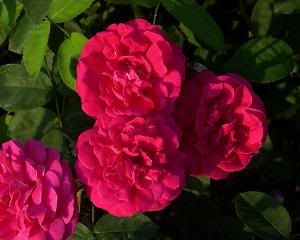 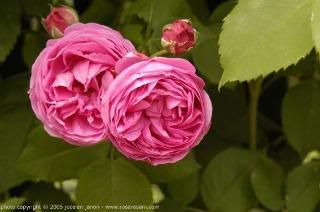 ‘Prince Charles’ ‘Prince Charles’ Hardy, France, 1842 A nearly prickles plant, reaching 5 foot. Very deeply coloured Bourbon - which is unusual. Almost purple/carmine in the Gallica sense. Good fragrance. The petals are veined and crinkled. The flowers are borne in the usual clusters or singly. They are loose and not very double, they fade to a lilac-magenta, at which time the veining of crimson becomes more noticeable. All these rich hues are highlighted by the pale base of the petals. ‘Coupe d’Hebe’ 1840. Introduced by Jean Laffay. Can be grown as a medium shrub to 5 foot or a small climber to 10 foot, depending on how you prune her, to shape and size. Possible best as a pillar rose. Clear soft pink blooms in clusters on the arching canes, fading only a little and sometimes show a quartered effect. Usually once flowering in midsummer. History bit The Bourbon Roses like all other classes of the “post China Roses “ appeared in the second generation of hybrids as per Mendel. The first generation of the Bourbon [/b] was a natural hybrid between The Autumn Damask and Parsons Pink China found growing with its parents in a garden on the French island of Bourbon in 1817. A botanist named Breon, who was working in the Botanical gardens, found it. It was a vigorous hybrid that displayed characteristics of both parents. Locally it was called ‘Rose Edouard’ . So if your ever in Mauritius and hear a rose thus called you’ll know all about her! In 1919 Breon sent seeds, to a M. Jacques in Paris, now, he was head gardener to Louis Philippe, a person of note, mainly because he happened to be King at the time. It is alleged that 5 in number sprouted, but only two produced repeat flowering roses, From one these M. Jacques raised the first Bourbon Roses . This was named ‘Rosier de l’Ile Bourbon’ , possible by Redoute after illustrating the seedling. As was his wont he also named it ‘Rosa canina Burboniana’. This rose was a better garden rose than its parent. It had a more compact habit and continued to flower into autumn. These traits would have come from its ‘China’ genes as “pure lines”, as per Mendel. It was a rose pink, semi double flower, with nearly evergreen foliage. From its ‘Damask’ genes it inherited its good scent. M. Breon, circa 1820, also sent cuttings of ‘Rose Edouard’ to a M. Neumann who was working in the Jardin des Plantes, Paris. So in theory, during the early 1820s, there were in Paris, three ‘Bourbon’ stock for the breeders to play with, ‘Rosier de l’Ile Bourbon’ , ‘Rose Edouard’ and an unknown seedling. Most of the early work resulted in ‘sterile’ off spring. So much so that only around 15-20 plants were introduced pre 1830. After which they appeared to get the hang of it and new plants were introduced in greater numbers on a regular basis. There is, however, an exception to all that, which is a plant called ‘Gloire des Rosomanes’ [/b]. Raised by M. Plantier (Lyon) and introduced in 1825 by M. Vibert. Now, she is has continuous flowering of her crimson and scarlet flowers. Which are borne upon long stems of a strong growth habit. This led her to be the chief ancestor of ‘Hybrid Perpetuals’ . She does have some gossip surrounding her, although I cannot possible comment. having not met the lady. It is said that the elapsed time from seeds available 1821, to introduction 1825 would not be enough to complete the introduction process. And as such she is a different hybrid, still between ’Damask and China’ . This time using ‘Slaters Crimson’ instead of ‘Parsons Pink’ . This would of course explain the colour difference. All ‘Rose Edouard’ offspring being pink!  ‘Gloire des Rosomanes’ ‘Gloire des Rosomanes’ [/b]. Here she is, so you can make your own minds’ up A few ladies for you to enjoy. 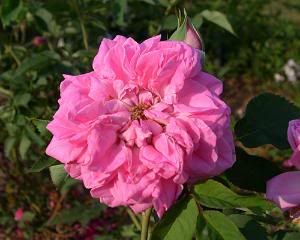 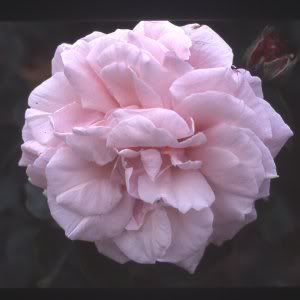  ‘Mme Lauriol de Barny’ ‘Mme Lauriol de Barny’ Introduced by Trouillard, France, 1868. Produces light pink, large fully double blooms. With smooth mid green foliage, they are set along the stems. Another duel purpose either an open 5 foot shrub or can be trained as a 7-8 foot pillar. The bottom two are both ‘Mrs Paul’ Paul and Son, Old Nurseries, Cheshunt, England. 1891. A latter addition to the group. (There is another rose called ’Mrs William Paul’ but she is a ’ Hybrid Perpetual’ . This one is a seedling of ’ Mme Isaac Pereire’ She is a strong grower, with good foliage and quite free flowering, with repeat flowers into autumn. In fact the September blooms are considered by some to be of equal quality as her parent. She would be grateful for and benefit from a wall, or another rose or even another shrub to lean against. The official flower description is white, suffused pink and a soft peach. I have given you two pictures so you can see the scope of flowers likely 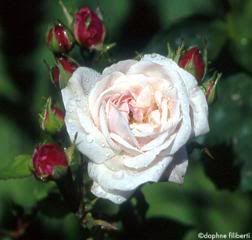  ’Mlle Blanche Lafitte’ ’Mlle Blanche Lafitte’ Pradel, France, 1851. A different kind of Bourbon in that the flowers of a whitish rose and double are smaller than most and bloom in clusters. That being said the blooms still retain the typical shape, fragrance and habit of constantly blooming. A smaller growth habit than others in the class, reach between 3 – 5 foot ‘Mme Isaac Pereire’ Garcon, France 1880. I must admit she is in my garden. And these are the reasons why. Possibly the strongest scented rose I have come across, but that does depend on your ability to appreciate that characteristic! The flowers are very large, of an intense red, shaded magenta with rolled petals, quartered and open to a large saucer face. They are produced in flushes through June-September. I must admit those of the first flush are not of the same quality as the latter flushes, which on established shrubs, can leave you open mouthed and speechless. The shrub in my garden is only 3 years old, but I can wait! If Bourbons are your type of rose then this is it. Having said all that, she will get to 7 foot or so. Those, that I have pictured, would fit neatly into an ’Old Rose ‘ garden, particularly, those having a repeat or continuous flowering habit. The class in general kept evolving, therefore many different growing habits and flowers would appear. It’s therefore difficult to be more than very general, as above, in describing the class. Every now and again you get a ‘new’ Bourbon but they seem to lack the original Bourbon character. Being true to form I’ll stick to the older hybrids. These have a good ‘Old Rose‘ shape and a charm all their own. On top of which they have those ‘silky’ flowers of the ‘China Rose’ . There are many more out there, those included here are just some encountered whilst researching the group. There were, on average, around 30-40 Bourbons in the catalogues I looked at. A few memories! 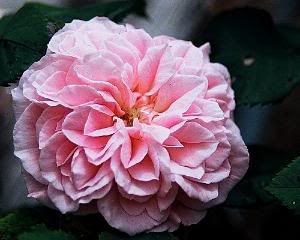 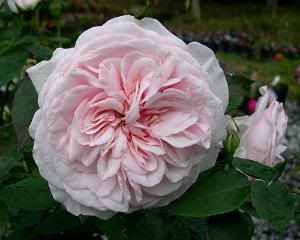 ‘Souvenir de Mme de Auguste Charles’ ‘Souvenir de Mme de Auguste Charles’ Moreau-Roberts, France 1866 A lax, strong growing shrub, would need some support. She has small light pink flowers with tightly packed petals, quilled and quartered, similar to the camellia. The shrub will flower early then repeat again in autumn. Only a faint scent ‘Souvenir de La Malmaison’ Beluze, France 1843. Another I must admit to having in my garden. I am informed that it was the Grand Duke of Russia that named the plant after obtained a few for the Imperial Palace St Petersburg. If you’re on a romantic trip to Paris then La Malmaison is worth a visit (even better in June!) Now, the plant herself, she is a little ‘minx’. In warm, dry areas she is outstanding, constantly in flower till autumn. The flowers are large (some 4inches across), a flesh pink, fully double, quartered and will fade slightly when open. However, the slightest spring or summer shower is enough to cause her to ‘ball’ and refuse to open her wet buds (perhaps Lancashire is not ideal for her, last year was awfully wet up here.) The latter buds will open if not rained on. All those I have grown never get above 4 foot. So if you have one do not prune her just keep her tidy using the 3 Ds She, ‘Souvenir de La Malmaison’ , does have some prodigy from self-seeding (sporting). The best known being her climbing version. This will reach 15 foot so, on good soil, and be covered in those 4-5 inch blooms at flowering time, midsummer and again in September. As said before on other Bourbons it is often the blooms produced in the cooler temps of September that surpass all others. She has the same soft nearly ethereal perfume that may be from one of the Tea ancestors. Three more ‘Souvenir de La Malmaison’ ‘sports’ 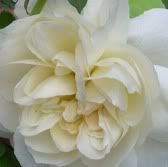 ‘Kronprinzessin Viktoria von Preussen’ ‘Kronprinzessin Viktoria von Preussen’ Bred by Vollert, France. Introduced, Spath, Germany 1888. Thought to be ‘lost’ but was indeed found again some years ago in the gardens at the NT property of Smallhythe, Kent. She makes a compact shrub of 4 foot or so. It is a pure white sport, showing lemon tints in both bud and flower. She is unique in bring this colouring to ‘Bourbon Roses’ and for the same reason is sometimes called ‘Malmaison Jeune’ 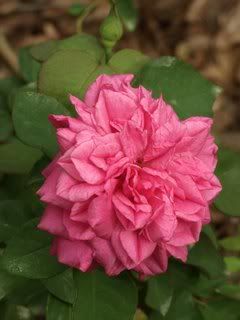 ’Leveson Gower’ ’Leveson Gower’ Beluze, France, 1846 aka ’ Malmaison Rouge’ A wide bush with mid green leaves, smooth heps and few prickles, reaching 4 foot. The flowers open to a rich deep pink, with a hint of a copper/purple flush. They are loose; muddled at the centre and have recurve petals. 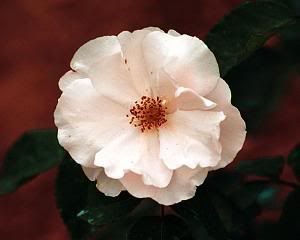 ‘Souvinir de St Anne’s’ ‘Souvinir de St Anne’s’ Found in Dublin during the first decade of the 20th century. She was being nurtured in the gardens at Willbrook House. Having originated in the gardens of St Anne’s, another family residence in Dublin. A nearly single sport, having all the characteristics, of the parent, apart from flower form. The petals are a deeper shade on the reverse. She is in flower till autumn with a good fragrance, not from her petals, but like her ‘Moschata’ ancestor, from the stamen. Reaches 6 foot. Pruning These Roses will need a different regime than that of the Old Roses , as they will flower on the ‘old’ wood as well as the ‘new’ wood. Pruning away all short twiggy growth straight after the first flowering (June-July time) will be beneficial, as it will encourage fresh growth., but you will loose some hep display. The major pruning time would be winter (February). Remove the 3 Ds dead, diseased and dying, also any crossing/rubbing shoots. Remove an old main shoot to encourage new growth. Shorten all small growth back to 2-3 buds and strong growth by a third. All this is very reminiscent of the regime for Hybrid Tea Roses and is the “official” guidance given. Me, I let them get to the desired size and shape, then, will apply a pruning regime of winter pruning to maintain that shape and size. However I will apply the 3 Ds rule and perhaps every 3-4 years remove a stem or two, although I am not over keen on that, with the “Post Chinas”. 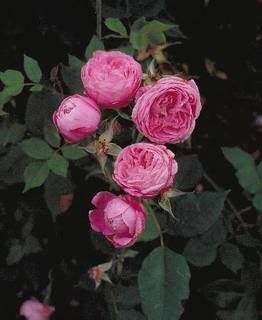 ’ La Reine Victoria’ ’ La Reine Victoria’ Introduced Schwartz 1872. Another of those in my garden!  ‘Mme Pierre Oger’ ‘Mme Pierre Oger’ Introduced 1878 a sport from ’ La Reine Victoria’ Both plants are identical, but for some reason this has become more popular. I personally cannot see why! They are identical in all but colour; both will attain 6 foot or so and will flower into September. The flowers are full and very rounded keeping their cupped shape till petal drop. The flowers on ‘Reine Victoria’ , which is supposed to be what you call her these days, have petals of a rich rose madder, with a “pearl” like look about them. On ‘Mme Pierre Oger’ , they open a soft creamy/flesh colour and in dull weather will remain so. On sunny days when it gets warmer and brighter the petals will change through a clear rose to an intense rose colour again having that pearlescent appearance. Could not finish without showing you just a few more  ‘Zephirine Drouhin’ ‘Zephirine Drouhin’ Bizot, France, 1868. Acclaimed as the most popular ‘Bourbon’ , partially due to her prickle free stems and to her bright, loose semi double, cerise-pink flowers, very sweetly scented and carried till autumn. She is best grown as a climber reaching 12 foot. The leaves are a strong green tinted copper/purple.  ‘Variegata di Bologna’ ‘Variegata di Bologna’ Bonfiglioni, Italy 1919. On good soil will reach 10 foot. On poor soils not so vigorous. The flowers are produced in midsummer only. The blush tinted, near white petals are many and open to make a somewhat globular flower, striped with crimson-purple. Like all of the class can be pruned to retain desired shape and size. Has been known to ‘sport’ to a dark crimson rose, presumably her parent, but no-one seems to know the parents name. Although modern she still retains that ‘Bourbon’ look and feel. Something the newer varieties have failed to inherit And here is a couple of the new breed, so you can decide for yourself. 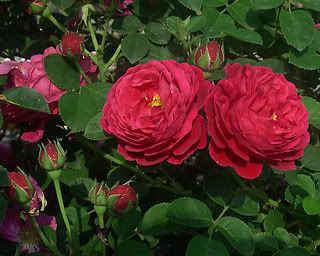 ’ Zigeunerknabe’ ’ Zigeunerknabe’ If you have trouble finding that, it is sometimes listed as ‘Gipsy Boy’. 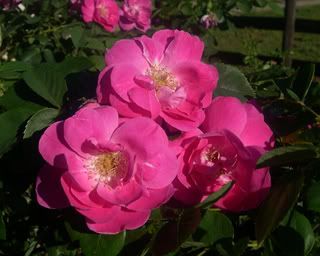 ’Adam Messerich’ ’Adam Messerich’
|
|
|
|
Post by fozzie on Feb 4, 2008 18:30:49 GMT
Part 11 Noisette Roses [/u] These along with the ‘Bourbons’ you have just seen and the ‘Teas and Hybrid Perpetuals’ that we will explore later are getting very close to those ‘Hybrid Teas’ , as such are not my first choice, but as indicated I do have a few, notably ‘Bourbons’ . Some say that they are too close to each other to distinguish. But. More of that (heresy) later. 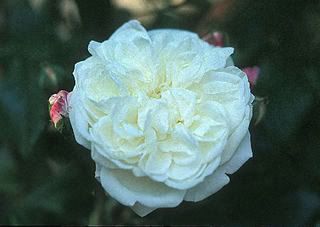 This is ‘Aimee Vibert’ Vibert 1828. Difficult to accurately place given traces of China, Musk, Tea and Evergreen in her ancestry. This seems a good place for her, as she is the result of a ‘Noisette’ crossed with a hybrid from R.sempervirens For those of you wondering R.sempervirens is known as the Evergreen Rose With those parents it is difficult not treat her as a climber. Which she will quite happily comply with, when trained against a wall, reaching some 15+ feet. You could also let her develop into a large arching open shrub. Covered with what has been quoted as “the best rose foliage”. It is dark green, deeply veined, glossy, long pointed and serrated. Her flowers are carried in trusses on long branching, nearly prickles shoots that are thrown up during the summer. Her buds are pink opening to near full double white flowers with yellow stamens. They are good for cutting. It is not often you hear me say that as it is normally taboo in my garden, I like flowers on plants. She will flower from June/July while Autumn (Lancashire rubbing off) The late flowering coming from R.moschata She is also known as Bouquet de la Mariee or Nivea you Latin scholars will understand the latter. Hardy down to zone 7 (5F or –15C) so will loose a few shoots in a hard winter. If I were looking for, possibly the best, white perpetual flowering rambler Aimee would be it. The vigour and habit of growth of ‘Noisettes’ would put them as climbers but their close relations with Chinas have made me include them as Old Roses. The original ‘Noisettes’ would not have been climbers. And, they represent the first introduction of the repeat flowering gene into our garden roses. 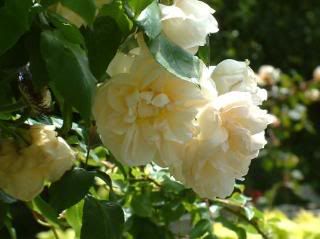 ‘Desprez a fleur jaune’ ‘Desprez a fleur jaune’ aka ‘Jaune Desprez’ Desprez, France, 1830. She is a cross between ‘Blush Noisette’ and Parks Yellow Tea Scented Rose’ . Is it only me, or do you ever sit there and wonder what was in the mind of the breeder when producing hybrids? Not only roses but any hybrids. Take Mons Desprez, he would have had little or no idea what was going to arrive from his work when he started. He actually produced one of the most enduring of all roses, which is still popular with Old Rose growers. She will reach some 15 foot if trained against a wall, has few prickles and is well covered in light green foliage. Her shoots will zigzag at each node, a trait BB should recognise, which is why I think her mystery rose is a Noisette . The flowers, carried in clusters and continuous, are 2 inches across, double of creamy tinted apricot pink flushed with peach they also have a powerful fragrance. She really needs to be seen to be appreciated all these words do her no justice. I would only be happy risking her down to zone 7 (5F –15C) so that’s me out, until we warm up a bit! I would make her a feature with her main stems trained against a wall and all other secondary growth allowed to cascade outwards and downwards, similar to another method I use, explained a little lower down. General Description A general description is difficult; they make a very mixed group. This is very broad brush. They are vigorous, reasonably disease resistant, remontant, and fragrant. The colour range is not large; and they are generally quite tender in the face of cold weather. Still, where they are cold hardy, they can be a good garden rose. Given that sketchy description, I’ll add as much detail as possible with each picture. Interesting, but maybe not surprising, the description will show the changes during the evolution of the class with these different characteristics being introduced. When showing you pictures I’ll attempt to give them in chronological order, which may show the developments. In terms of cultivation they will be at their best on sunny walls in the warmer areas of the UK. As I have painfully found out up here in the artic northwest! They are reputedly cold hardy down to zone 7 (-15) but I’ve managed to loose one. It was one of the later ones so was possibly more ‘Tea’ than ‘Noisette’ .I repeat they are normally seen as climbers but some will only get to 10 foot or so, but would still do best against a warm wall.  ‘Lamarque’ ‘Lamarque’ [/b] Marechal, France, 1830 originally named ‘The Marechal’ after the breeder, subsequently renamed in honour of General Lamarque. She has two things in common with ‘Desprez a fleur jaune’ they were both one of the first ‘Noisettes’ with a yellow colouring. Secondly they both had the same parents, but, as I am sure you can all spot, she leans towards her ‘Tea’ parent. Sadly she one for warmer climes. I would not go much beyond zone 8 (10F /-10C), although she is quoted as zone 7. The flowers have the “nodding” trait of ‘Teas’ are very double, flat, quilled and quartered petals. They open a lemon white and fade to near white and have a strong scent. Would only get to a medium size shrub in our climate say 7 foot. I found this quote from a magazine. It came from our cousins across the pond, so maybe needs a pinch of salt. If I malign the author than it must have been one hell of a sight. The Floral World 1874 “This rose, that now clothes the house of Mr Randall of Santa Rosa, is an example of ‘Lamarque’ one of the finest ‘Noisettes’ . It covers an area of 400 superficial feet and in season is fully loaded with flowers. In fact it has had some four thousand open roses and twenty thousand buds at one time. It appears to have been planted some 15 years ago, but so vigorous is it that it has now covered the roof” If you are thinking of growing one of these ‘Noisettes’ , in particular one of the “shorter” plants then try training the back 2-3 shoots as a climber on the fence or wall and let the front shoots grow and cascade forward, so you get a bit of both climber and shrub. A little variation on the method mentioned above. The History Bit [/I][/b] You remember that rice farmer from Charleston? No! Well, his name was John Champneys. Not only was he a farmer he was also a keen gardener, so therefore must have had a bob or two. Why do I think he was rich? Gardening is not cheap both financially and in time needed to tend the plants. So he must have had someone to work/manage the farm. Well, this young American that has the distinction of introducing the ‘China gene’ for repeat flowering to our ‘Old Roses’ . In 1802, he crossed ‘The Old White Musk’ R.moschata with the pollen of ’Parsons Pink China ‘. He had acquired ’Old Blush’ from his neighbour Phillipe Noisette, who had received it from Louis, his brother in Paris. The result of this cross was a hybrid that combined the open climbing habits of the ’ Musk’ and the semi double pink flowers of the ‘China’ . Champneys called it ’R.moschata hybrida’ . Its common names were ‘Champneys Pink Cluster or Champneys Rose’ It is of course a ‘China Hybrid’ . Here she is. 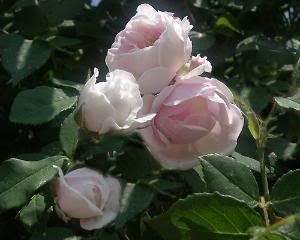 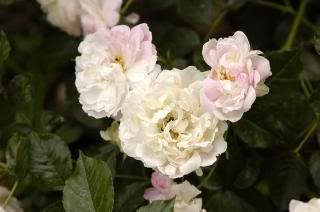 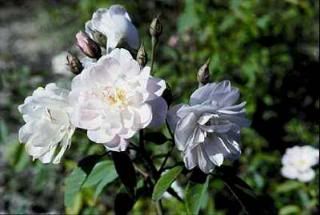 ‘Champneys Pink Cluster’ ‘Champneys Pink Cluster’ Introduced circa 1810, given a seven year intro cycle from 1802. Small double blooms that start pink and open white engulf the upright growing shrub all year. They are quite fragrant. It is not a climber but rather an upright shrub and it does repeat. Some call it a climber, but it is not it will get to about 5-7 foot as a medium shrub and is hardy down to zone 7 (5F or –15C.) Champneys, to return the favour, gave Noisette a ‘Champneys Pink Cluster’ or two? A few years later Noisette sowed seeds from these and being the second generation, yes I can see you’re ahead of me, raised the original ‘Noisette Rose’ The f2 segregations to appear were, shorter plant, a more compact growing habit, the flowers were a white/blush borne in clusters and most important were carried from June to September. In 1814 he sent these to his brother in Paris, from where Louis distributed them in 1819. This “first” ‘Noisette’ was named ’ Blush Noisette’ . A specimen of this rose can be seen at Nymans (NT) For non members and/or those not living close to or in Sussex. Here she is… 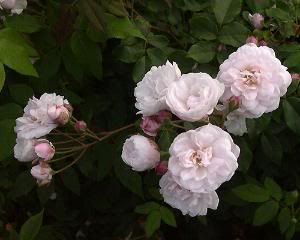  ‘Blush Noisette’ ‘Blush Noisette’ Introduced circa 1814 by Philippe Noisette US. Often confused with and named ‘Champneys Pink’ She is a lax shrub, covered with leaves of mid green, on prickle free wood. The flowers, in small and/or large clusters, from mid summer onwards are borne on the plum coloured wood, they are small and cupped, a bit more than semi double but not fully double with yellow stamen. In bud they are a deep rose fading to light pink. Fragrance of cloves. Again, she can be described as a climber or a medium/large shrub, as a climber against a warm wall will get to 15 foot as a shrub can be up to 10 foot Up to 1830’ish there would have been little variation in ‘Noisettes’ raised. There was some use of ’multiflora’ that may well account for violet/crimson colourings. Then there is the well known ’Aimee Vibert’ who had R.sempervirens as a parent, which would explain her lax growth habit. Up to this point the ‘Tea Rose’ , although it was present in the gene pool, had little or no influence. I’m sure you remember some months ago we decided that 3 of the 4 studs were in fact hybrids between R.chinensis and R.gigantea’ and as such would be ‘Tea Rose’ . There now was a drive to bring yellow to the class, so around 1830 ‘Blush Noisette’ was crossed with ‘Parks Yellow Tea Scented Rose’ . This cross had a big impact, it introduced yellow to garden roses in two forms a) the yellow ‘Noisettes’ , and b) the yellow ‘Tea Roses’ . The ‘Tea Roses’ were short and shrubby, whilst the ‘Noisettes’ were “Tea Scented” climbers. The enthusiasm for yellow would mean many further crossing would follow using ‘Parks’ . As a consequence the ‘ Noisette’ evolved to become the ‘Climbing Tea’ . Along the way some remarkable ‘Noisettes’ were to appear. So over that 80–90 year period you have ’Noisette’- ‘Yellow Teas’ ‘Climbing Tea-Noisette’-‘Climbing Tea’ and you may well encounter some or all of those class names when looking through catalogues. And just to make the soup complete, the odd ‘Bourbon’ was used here and there in some hybridising programmes. 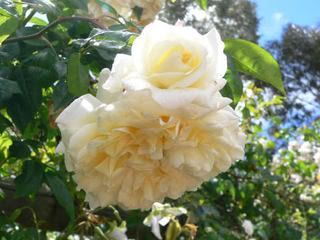 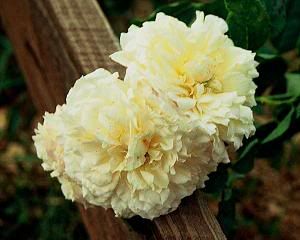 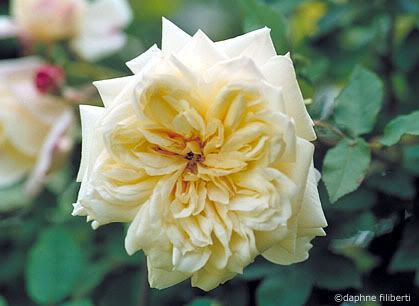 Could not decide so gave you all ‘Celine Forestier’ Introduced by Trouillard, France in 1842. Parents not recorded but possibly the result of “selfed” early yellow ‘Noisette’ . Her ‘Tea’ genes have come to the fore, particularly in scent and colour. It is a tough old rose, but even then not lower than zone 7. My garden appears to be a frost trap, so again not me! She has that Old Rose shape. Her buds are borne singly or in clusters along prickly shoots along with light green loose leaves. The buds open to a near perfect circle of flat petals, with quartering and a button eye. They are silky and a creamy pale yellow with peach tones at the centre. A good scent and always in flower June (while) till autumn. She will reach 8-10 feet, so medium shrub or small climber or mixture of both. A word of caution she is a good rose once settled in to her surroundings but may take her a little time to make herself at home. 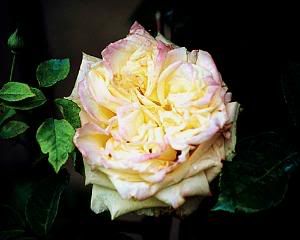 ‘Cloth of Gold’ ‘Cloth of Gold’ Introduced by Coquereau, France 1843 A ‘Lamarque’ seedling and as her parent is somewhat tender and needs a warm wall, where she will reach 12 foot. Her flowers are a soft sulphur in colour, fully double and a deeper tone at the centre. They are borne continuous and are very fragrant. 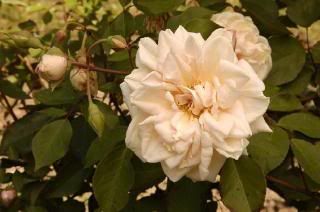 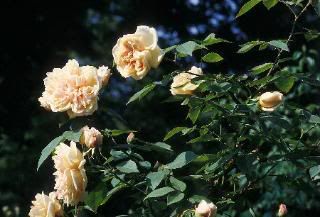 Both are ‘Solfatare’ Another “selfed” ‘Lamarque’ She is quite often classed as a ‘Tea’ , maybe she has more traits from that grandparent. Who knows why someone puts one “sibling” in box A and another in box B. It’s all down to Mendals’ law again I bet. Another 12 footer so, again, could be trained as a shrub and/or climber. Allegedly, hardy to zone 6 (say –20C), will tend to be more vigorous in warmer climes. She has the growth habit of her parent with large double flowers of sulphur yellow and both very fragrant and repeat flowering. My view; a ‘Tea’ down to –20C no! Unless they are really mollycoddled over the winter. And they will have to be very special to get that treatment from me. The first two yellowish ‘Noisettes’ ‘Lamarqe’ and ‘Jeune Desprez’ appeared around 1830. (Pictured above) A plant called ‘Smith’s Yellow’ appeared in 1833. Although classed a ‘Noisette’ , she is the first dwarf yellow ‘Tea Rose’ . It hurts to say this but I can find no information to give you, nor a picture to show you. PS not to be beaten by a rose I have found the following information. Smith was an English amateur gardener more famous for Rhodies than roses. I have a picture of the plate published in a French magazine 1834. Smith called his plant a ‘Noisette’ but if the plate is accurate you can see it is not. It did not last long as a garden plant, apart from some southern states of North America, due to its tenderness and dislike of wet weather were the blooms would “ball”. 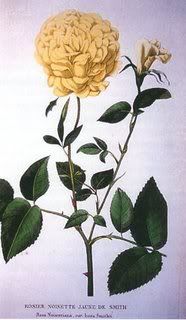 ‘Smith’s Yellow’ ‘Smith’s Yellow’ Smith, England, 1833 these descriptions I gleaned from several sources. “Pale yellow, large double flowers, but does not open well in moist weather; it is a superb article when perfect, and is quite a dwarf having very little of the Noisette character, but delightfully scented.” “It is a beautiful yellow rose when grown to perfection; in order, however, to show its full beauty, it might need to be grafted and planted in a rich and deep situation; not a very good bloomer, and rather dwarfish You will now appreciate why it is no longer in cultivation. Those first yellowish ‘Noisettes’ were ‘selfed’ and produced some famous plants viz ‘Celine Forestier’, ‘Cloth of Gold’ and ‘Solfatare’ , to name a few. During the next decade or so further breeding so diluted the ‘Noisette’ characteristics that they all but disappeared as they changed into ‘Climbing Tea’ or ‘Climbing Tea-Noisettes’ 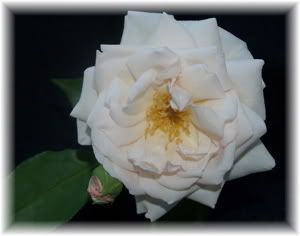 ‘Mlle de Sombreuil Clg’ ‘Mlle de Sombreuil Clg’ Introduced Roberts, France 1850. There is some debate whether the picture is the young lady in question or another hybrid not even closely related to ‘Noisette’ . This debate has been going on for some time in particular by our cousins. She looks to have a bit of ‘Tea’ [/b] so that will do for me. If you wish I’ll go into detail! On second thoughts you are unlikely to be exhibiting in America, so it has no consequence. It’s only a name and the genealogy around these classes is confused to say the least. Just to give you a taste the real young lady is sometimes either a ‘Tea’ or a ‘Noisette’ . Her mother, with the same name minus the “climbing” tag, is most classed as a ‘Tea’ with a ‘Hybrid Perpetual’ father. I now know why I prefer the good clean living ‘Species Roses’ Anyway the young lady will grow to 12 foot on a warm wall and produce continuous flowers of creamy white with a flesh flush centre. They are similar to ’ Souv de la Malmaison’ being flat and quartered. 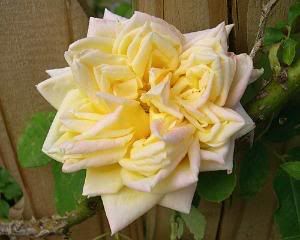 ‘Marechal Neil’ ‘Marechal Neil’ Introduced Pradel, France 1864. Said to be a seedling of ‘Cloth of Gold’ . She is quoted as being probably the best yellow climber. I have never seen her, so I could not possibly comment! What I would say is, the colouring is a good yellow, akin to butter. Your now experienced eyes will detect a lot of ‘Tea’ influence and none more so than in her fragrance and long pointed bud shape. There is a lot of ‘Tea’ , so really should be called a ‘Climbing Tea’ . On the down side she has weak flower stalks that support the nodding loose flowers, which are prone to rain damage although the flowers do repeat through the season. Hardy down to zone 7 (-15C), will reach somewhere between 10-12 foot, depending on warmth and shelter. So not the ideal garden addition, in fact I would say only for the enthusiast. Do not look at me, I plant them and then they are on their own! Which, of course, you can do with those that I am most fond of. 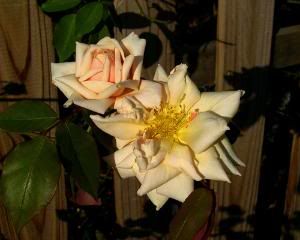 ‘Reve d’Or’ ‘Reve d’Or’ Introduced by Ducher, France 1869. A strong growing plant for the warm, sunny garden; fine rich green leaves, that famous coppery tint when young and loose semi double, buff yellow flowers, with a hint of pink, others will just call the flower apricot, that fade to a butter yellow. In flower till autumn and reaching 15 foot. There is, allegedly, a mild fragrance, which I can never get. Pruning If it were me, I would not touch them for three-four years, at least, apart from a quick tidy up around Feb time. (3 Ds and all that plus some shape training.) Once they have established themselves, then all you need to do in addition would be to shorten the side shoots to 2-3 buds and occasionally, very occasionally remove some of the older wood. These are a couple that I had before I carelessly lost one. 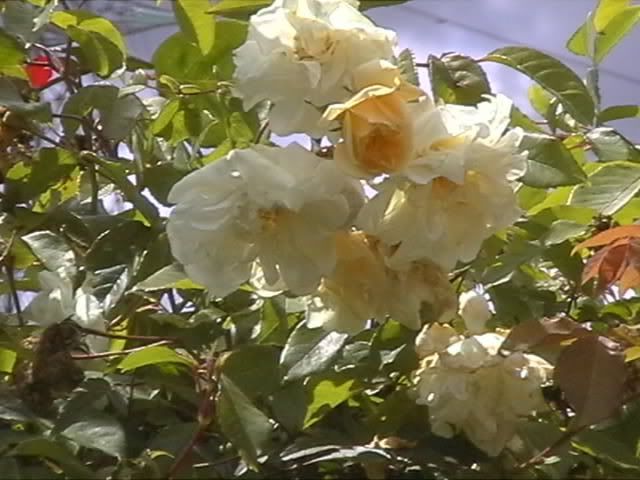  ‘Allister Stella Gray’ ‘Allister Stella Gray’ Yes you have seen these before she was in flower up to 12 Dec in my garden. Introduced by Paul, England, 1894, having been raised by Gray in 1893. I must be honest she is like an old friend, always, or near enough, first to arrive at the party and last to leave. I grow her up one side of an arbor but let the front shoots fall forward. She has a good scent, mainly from the tight yellow buds, which are there every day right through till Oct/Nov, the flowers that emerge a day or so later are double, flat, have that ‘Tea’ silky look, can be 3 inches across and are carried on small sprays and are of a good scent. I have been known to let Mrs F cut one or two on special occasions. The dark green leaves and flower sprays are carried on zigzag shoots. I learnt something about her; she received the RHS AGM in 1893. 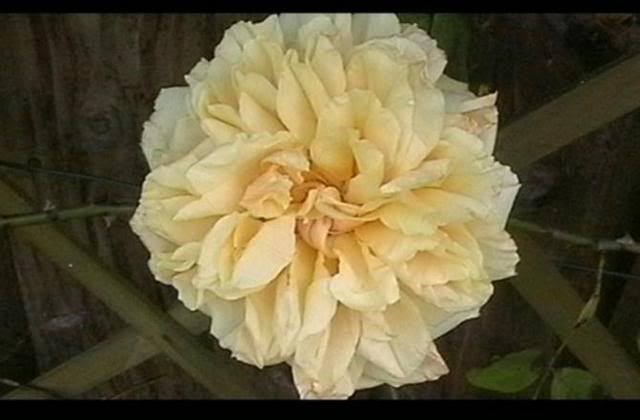 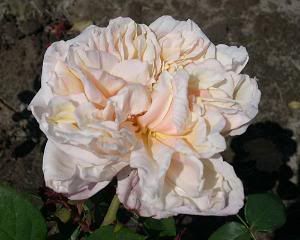 ‘Gloire de Dijon’ ‘Gloire de Dijon’ Introduced Jacotot, France 1853. Was In my garden but no more I am sad to say. My fault I put her in the wrong place. She is so far away from ‘Noisette’ to be virtually a ‘Climbing Tea’ , which was the problem, I found the perfect frost pocket to kill her. Makes you wonder how she was ever class a ‘Noisette’ , one parent was ‘Souvinir de la Malmaison a Bourbon’ the other was a ‘Tea’ . She is a popular and pleasing member of the old climbers. During the three seasons we had together she was always in flower from June while autumn. The soft yellow flowers were heavily scented and had a flush of pink/apricot. She grew on my back fence where she made 12 foot by 12 foot. She does have a tendency to show her legs off, but if you under plant her or grow her on a fence betwixt a couple shrubs to hide her modesty then all should be well. I have now found a dryer spot, as I believe this was the real problem so next year we will have each other’s company again! The top picture is mine in her last flush. Just a few more before we go, I’ll keep them in the 19th Century-just! 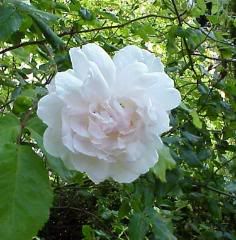 ‘Mme Alfred Carriere’ ‘Mme Alfred Carriere’ [/b] Introduced Vve Schwartz, France 1879 In favourable conditions has been known to get 18-20 foot against a wall a la Sissinghurst. Or, will easily attain 10 foot as a medium shrub a la Kiftsgate She is so far removed from the early ‘Noisettes’ [/b] characteristics that it is difficult to see any relationships. Nevertheless a popular white climber of the old school. The flowers are large, fully double somewhat globular. The official colouring is creamy blush fading to blush white. They are sometimes quartered or have a muddled centre. 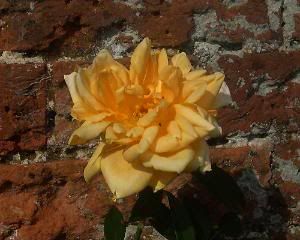 ‘William Allen Richardson’ ‘William Allen Richardson’ Introduced Ducher, France, 1878 A sport from ‘Reve d’Or’ , it has, some say a better colour, I leave that to you. It is also said that its colour is the reason why it is still grown. Not so much a rarity now but go back 130 years or so! The flowers are borne singly or in twos, they are a shapeless, double, of vivid orange/egg yellow quickly fading to white in the Sun. The young shoots and foliage are a mahogany colour, prickles on the main stems but nearly no prickles on the smaller stems. Not so vigorous or graceful as its parent. 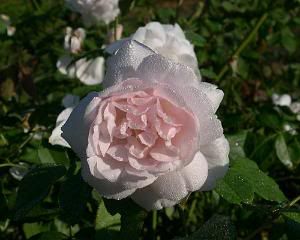 ‘L’Abundance’ ‘L’Abundance’ Introduced Moreau et Roberts, France, 1877. Parents nor recorded, she appears to be a good kept secret. I had not heard of her, but now know more than I did 10 mins ago, small medium climber 10-12 foot, has white flowers with a hint of blush, continuous in small clusters. Finally I give you this; 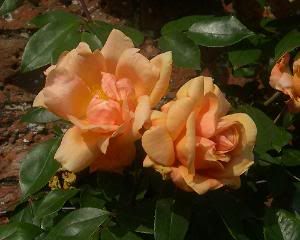 ‘Crepuscule’ ‘Crepuscule’ Introduced by Dubreuil, France, 1904. No record of parentage, but look how close we are getting to ‘HT’ . A shrub/climber about 8-10 foot, somewhat tender and needs a sunny wall for protection, although allegedly zone 7 (-15C). The loosely double flowers are of several tones of apricot and yellow. The plant is seldom without flower after the main flush.
|
|
|
|
Post by fozzie on Feb 23, 2008 18:23:06 GMT
Part 12 Tea Roses    You knew I would not miss an opportunity to show you these again! All are the ‘original’ Tea Roses and have the same parents R.chinensis x R gigantea . Or was R.gigantea aka R.odorata the original. There are twists and turns around the parents but we discovered those in the China episode. Over the last few months I have been reading lots of descriptions and giving you a summary on each rose pictured, it occurred to me that you might not be aware of my terminology. Some anorak somewhere has devised a formula, in terms of petal numbers, for the terms single, semi double and double flowers. Mine is easy; a single flower is > or = 4 petals, a semi double flower = a little more than 5 petals and a double flower (aka full and very full) = a lot more than five petals. You may detect a little petulance, why does it have to be so black and white or am I missing the point? The answer is yes; if I exhibit or sell as it’s all to do with “exhibition/commercial standards”. Or no, it matters not if like me you only see the flowers for what they are. Anyway anything over 5 is not a rose!! That’s it, soapbox put away As in previous episodes, I will try to give as much detail as possible in the examples shown. In an attempt to keep to the arteficial division between Old and Modern I’ll try and stay in the 1800s, but will fail. OK, but you should have remembered, they are Hume’s Blush, Parson’s Pink and Park’s Yellow Introduction Teas are considered by many rosarians to have the finest form and colour palette of all roses. ( If talking about the originals then I agree, some of you may well agree unconditionally. ) The problem is that the plants producing these flowers are somewhat tender, and the blooms are susceptible to damage from the weather. This was, and is still particularly true, in France and England where most of their early development was to take place. Some of the early growers and breeders took to growing them as greenhouse plants; others tried to improve them by crossbreeding. 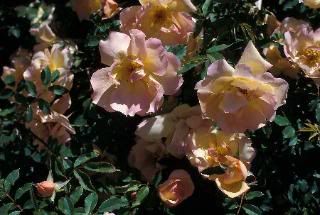 ‘Fortunes Double Yellow’ ‘Fortunes Double Yellow’ Introduced by Fortune 1846. A little bit of an oddity, but strictly speaking is a Tea . She is best in warm climates where she will ramble up to 20+ foot. Here, Lancashire, you may get 10 foot if conditions are good. The bright coppery-yellow flowers are flushed copper-scarlet carried single or in small cluster at midsummer. This was a brilliant rose of its time; she will still turn heads today, even amongst non-believers. It is, after all, just a big shrub with pretty flowers!  ‘Niphetos’ ‘Niphetos’ Introduced by Bougere, France, 1843. Parents not recorded. Has light green dense foliage that act as a good foil for the white flowers that carry a hint of lemon at the centre, they open from long pointed buds, into globular flowers that will repeat in flushes. She is a small shrub to about 4 foot, there is a Clg sport same name which will get to 12 foot. The shrub is recorded by one source as needing glasshouse protection or by another as hardy to –15C. I know what my money is on. She was very popular with Victorian florists as a cut flower, which is maybe why she was grown in greenhouses and got use to the idea. A couple more of the earlier hybrids. 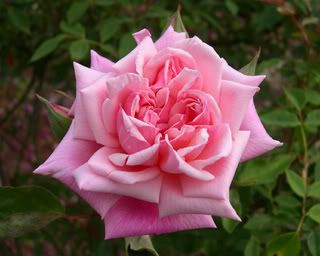 ‘Souvinir d’un Ami ‘Souvinir d’un Ami Introduced by Belot-Defougere, France 1846. The flowers are made up of incurved petals of a light coppery pink. They form large cupped semi double blooms with a strong fragrance, and are normally held as single flowers. Although her parents are not recorded you can see she is close to Hume’s She will get to about 5 foot but is of a delicate nature needing lots of protection and care. And you know my feelings about that! 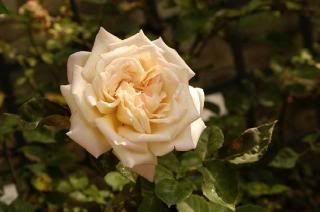 Mme Falcot Mme Falcot Introduced Guillot (fils), France, 1858. A bush getting to about 5 foot, with glossy leaves. The flowers are normally singular; double with a muddled centre, the colouring is yellow getting darker towards the centre and fading with age ( know the problem ). She will repeat in flushes through season. Said to be a “sport” of Safrano Identifying Teas can be difficult. They will, due to their ancestry, exhibit characteristics from any of the following China, Bourbon or Noisette . If you bear in mind that the originals were, for argument sake ‘China hybrids’. Add to that crosses were made with Bourbons and Noisettes , which, themselves, were, originally ‘China Hybrids’ and you can start to see what sort of muddle you end up in! 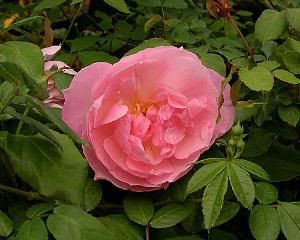 Duchesse de Brabant Duchesse de Brabant Introduced by Bernede, France 1857. She has light pink, cupped double flowers with a strong fragrance, which she freely produces. Her parents are unknown. Allegedly hardy to –25C but is prone to mildew. But she did have a famous ally; “Teddy” (Theodore Jnr) wore her buds as his buttonhole flower. Will reach 5-7 foot. 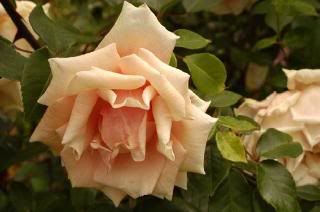 Anna Olivier Anna Olivier Introduced by Ducher, France 1872. A vigorous, if somewhat small shrub only reaching 3 foot. Her foliage is a mid green and has pointed leaves. The blooms are a soft pink flesh with darker tones on the reverse, carried singly but repeats in flushes. Remember poor old ‘Gloire de Dijon’ from the last episode (!). She is oft classed as any or all of these Tea, Bourbon, Noisette or Clg Tea . So could also be included here. This is why. ( I know you like these little diversions ) She is believed to be the seedling of an unknown Tea or Noisette crossed with the Bourbon, Souvinir de la Malmaison , who in turn was the result of a Bourbon x unknown Tea cross. Is it no wonder she, ‘Gloire’ , is confused. It’s all the same when you get to this point in the evolution ( or revolution. ) Once those China Roses are involved it’s a mess. It is also an endless source of discussion for those in anoraks sitting round a table sipping their Rosé wine. 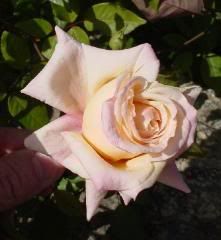 ‘Mlle Franziska Kruger’ ‘Mlle Franziska Kruger’ Introduced Nabonnand, France, 1880. A fairly tough little rose with pale yellow and pink double flowers carried on somewhat weak stems. Quite a bushy shrub and against a wall will get to 6 foot. ( Are you spotting a familiar shape and form, there are more later!) She was the result of an assignation between a young lady and a military person. And here they are. 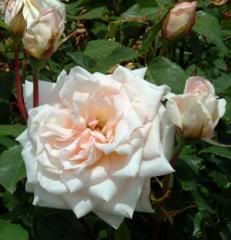 ‘Catherine Mermet’ ‘Catherine Mermet’ Introduced, Guillot the younger, France 1870. As so often happened, her parents not recorded, the blooms are a clear flesh pink tinted lilac and appear from high centre buds. Reminiscent of things to come! The foliage is a medium green and edged in a copper tint. Would require the shelter of a warm wall to reach her potential 5-7 foot. 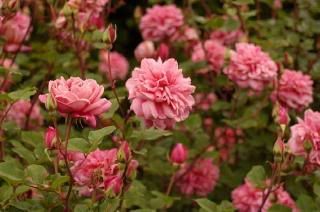 ‘General Schablikine’ ‘General Schablikine’ Introduced Nabonnand, France, 1878. She has plum coloured shoots that support the coppery carmine pink, others say orange pink blooms. They are fairly strong stems but still have that ‘nodding’ trait. She will flower in bursts through the season. A small to medium sized shrub, will reach 3-5 foot, depending on position and climate. I have discovered various descriptions ranging from 4 –20 foot. I’ll stick with my original, as several indicate that she would be a subject suitable for pot/tub cultivation. DescriptionThere is no “standard” description for a Tea Rose , because there is no specific Tea Rose You have the originals, then those using Bourbons , then those using Noisettes . There are even a few that have used those “other” roses shhh HT . I have picked up a few indicators for you. That well know southern distinction between North and South known as “Watford” is probably too far North for any self respecting Tea Rose . It not so much the cold but the damp that upsets them most. But, they have been known to survive in ‘sheltered accomodation’, North of Watford, offering a rich soil. They are allegedly hardy to zone 6, which is –20, I am not convinced. I have heard of them being grown in a cold GH, or heavily mulched, to protect them over winter in the open. The height range is dependant on parent so could be 3 foot or 15 foot. In true Teas the leaves are broad and large in relation to the flower. The leaflets are ovate with the single terminal leaf larger than the others. The leaf stem (petiole) has curved prickles on the rear. While the flowers would be semi double/double and carry its name sake fragrance. The petals may show a tendency to roll I would advise that you treat them as you would Noisettes , grow against a warm sheltered wall/fence. One of my sources had trouble growing them in Surrey! If you come across Tea Roses in catalogues, you will see some identified as suitable candidates for tubs. This may be another way of giving them shelter, as you could position them in the lee of a building. Beware, growing roses in pots does demand extra care and attention regarding feeding and watering. Just as important, remember to “bend the knees” when moving or lifting heavy pots/containers! 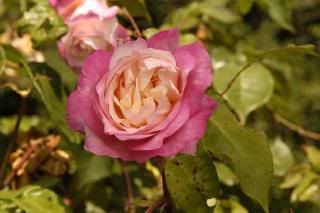 ‘Marie van Houtte’ ‘Marie van Houtte’ Introduced Ducher, France 1871. Her parents were both Tea Roses, Mme de Tartas x Mme Falcot . She is quoted as being “the most satisfactory of Teas ”. Having shapely high centred, full blooms of creamy yellow, deeper at the centre and tinged with rose at the edges, good foliage and reachinf 4-6 foot. Good fragrance. 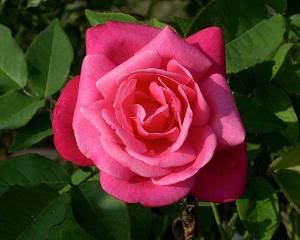 Mme de Tartas Mme de Tartas Mme de Tartas Mme de Tartas Introduced by Bernede, France 1859. She has large, double, flesh flushed pink flowers that are cupped in shape. The colour may be variable with climate conditions. Flowers through out season and grows to 6 foot ‘ish 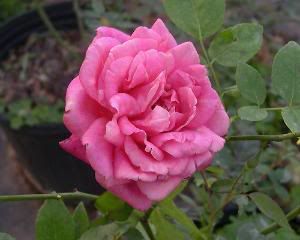 ‘Papa Grontier’ ‘Papa Grontier’ Introduced by Nabonnand, France, in 1883. She is a “sport” of another Tea called ‘Duchess of Edinburgh’ also by same breeder. Our subject is a small shrub 3-5 foot. Has semi double bright pink flowers with darker tones on reverse of petals. More cupped than flat flowers that will repeat in flushes.There is a clg “sport” but that did not arrived till 1904. Just to muddy the water some more.. If you call a China Rose crossed with A N Other; a China Hybrid and you call a Musk Rose crossed with A N Other, a Hybrid Musk . What is a Tea Rose crossed with A N Other called. It’s a Tea Rose of course! Or is it? ( More heresy )  ‘Maman Cochet’ ‘Maman Cochet’ Introduced Cochet,France, in 1893. An alleged famous shrub, with dark green leaves. The flowers open from globular buds to give a soft pink flower with a hint of lemon at the base and a darker pink at the centre. Her parents are both Teas ‘Van Houtte’ x ‘ Mme Lombard’ , both of which have ‘Mme de Tartas’ as a seed parent. (The chances of that happening naturally, must be a little remote!) . She will do best in a sheltered position reaching 3-5 foot and flowering continuous through season. Another contender for a container. 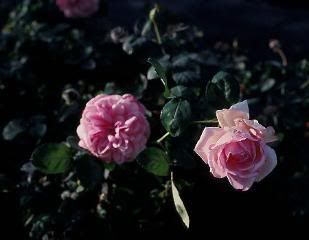 Often refered to as ’Mme Wagram’ her full title is ‘Mme Wagram, Comtesse de Turenne’ introduced by Bernaix in 1894. Her flowers are large, pink with a deeper pink reverse to the petals, and a moderate scent; growth vigorous reaching 6-7 foot. Will repeat flowers in flushes through the season. The History bit You will remember, I’m sure, from the “short history” there were 4 “stud roses” from China, R.chinensis, Parsons’ Pink China, (aka Old Blush), Hume’s Blush Tea-Scented China, (aka R.odorata) and Park’s Yellow Tea-Scented China. You may also remember, they are either the original species or hybrids ( Tea Rose ) from two species found in China, namely Rosa chinensis and Rosa gigantea (aka Rosa x odorata). Without going back over all that, suffice it to say that Rosa gigantea was the original Tea and is now classed as Rosa x odorata [/b]. So true Teas are all the aforementioned “stud roses” and any crosses between them. Then along came those Bourbons and Noisettes . In 1833 the first pink Tea was produced using the original Bourbon, Rose Edouard crossed with Hume’s Blush Tea-Scented China , fittingly it was named Adam , although I suspect for no other reason then it was the name of the breeder a Mons Adam, a florist/gardener from Rheims. I am sure it was a coincidence that in the same year in England, Smith produce Smith Yellow , a cross between Parson’ Pink China (Old Blush) and Blush Noisette , which he sold as a Noisette but was in fact the first yellow Tea . Several years later, in 1838, Mr Foster (alias Foz) performed a back cross i.e. crossed Smith Yellow with one of her parents namely Parks to produce a magnificent rose called ‘Devoniensis’ . In 1839 ‘Safrano ‘ appeared. She was the offspring from a Parks x ‘Desprez’ (Noisette) cross, and became the head of a group of yellow-copper Teas . There followed many other notable Teas between 1840-1890, usually as a result of crosses between the yellow Noisette Teas and the pink Bourbon Teas . After this date they started to loose all their typical qualities by being crossed with that other rose shhh HT , a class in which they had a hand in producing. Murdered by your own offspring! ‘Lady Hillingdon’ is one of that output and is the centre of debate over which class she should be registered under. 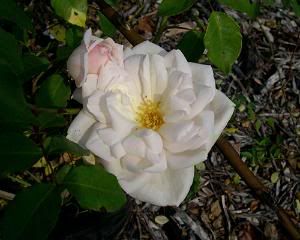 ‘Devoniensis’ ‘Devoniensis’ Introduced in 1838 by George Foster, England. Raised from a cross between ‘Smith’s Yellow’ and ‘Park’s Yellow’. She has large double creamy white flowers that are tinged pink when in bud and an apricot at the centre when fully open. The petals are both numerous and quilled, with a strong scent of the class. She will repeat her flowers in a recurrent manner in the autumn. In the right environs will get to 7 foot or so. There is also a climbing variety, which will get to maybe double that and more on a warm wall. The climber was introduced at about 1858. I have found at least three breeders who are claiming to have raised the climber. Suffice it to say she would be a “sport”, probably as a seedling, from the original. But it is interesting to note multiple and maybe simultaneous occurrences at different locales 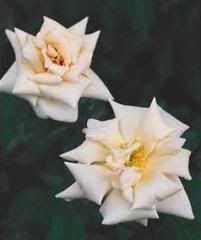 ’Safrano’ ’Safrano’ Introduced by Beauregard, France, in 1839. Here I quote from Dr Hurst “In 1839 appeared the remarkable Tea Rose 'Safrano', with the outside petals bright rose and the inner petals butter-yellow; it appears to have been raised from Park’s Yellow China crossed with Noisette 'Desprez'. 'Safrano' became the head of a special line of yellow and copper Teas, including 'Mme. Falcot' (1858), 'Perle des Jardins' (1874) , and many others...” She is an historic rose that can still give a good account of herself given a sheltered position. The flowers are a rich yellow with a hint of pink in the bud, opening apricot, fading to white in the heat of day. Height, depending on which reference you use is anywhere between 3 – 8 feet. Allegedly hardy down to -15°C. Pruning As Noisettes Do not touch them for three-four years, at least, apart from a quick tidy up around Feb time. (3 Ds and all that plus some shape training.) Once they have established themselves, then all you need to do in addition would be to shorten the side shoots to 2-3 buds and occasionally, very occasionally remove some of the older wood. Here we slip over into the 20th century. ( Just so you can judge ‘Lady Hillingdon’ for yourselves!) 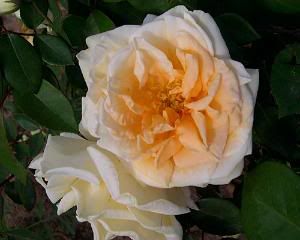 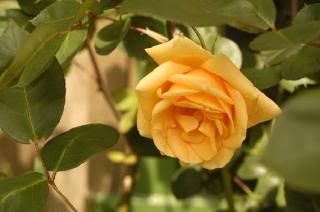 Both are ‘Lady Hillingdon’ Introduced by Lowe and Shawyer, England in 1910. Parents are ‘Papa Gontier’ x ‘Mme Hoste’ both Tea Roses . She has plum coloured young shoots and prickles, with dark young foliage. Her flowers are a loose double, a soft apricot yellow and emerge from long pointed buds of a similar colouring. Will require a sheltered site and some winter protection. But will flower from summer till first frost. She is another contender for container cultivation growing to 3 –5 foot. There is also a climbing form that will reach 20 foot. May I present Mme et Mons Jules Gravereaux, yes there is a small diversion on its way! 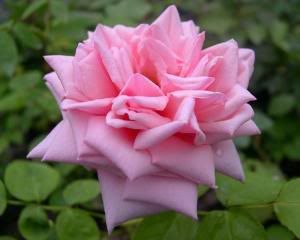 ‘Mme Jules Gravereaux’ ‘Mme Jules Gravereaux’ . Introduced circa 1901 in France by Soupert. She is the offspring from a ‘Reve d’Or’ (Noisette) x ‘Vicountess Folkestone’ (HT) cross. She is a good, “later” example of the class, given that you know who was involved. Mainly pink with a tint of apricot flower colouring, but will have lighter and darker shading. She is a strong growing plant up to 12 foot so can be either a small climber or medium/large shrub. Quoted as hardy down to -15C. 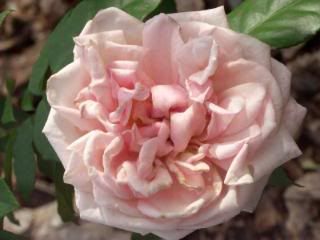 ‘Rhodologue Jules Gravereaux’ ‘Rhodologue Jules Gravereaux’ OK here is the diversion. There are in fact two, firstly that name ”Rhodologue”. The learned have already spotted a clash of the two giants “Rhodo”(G) giving us Rose and “logue” (L) giving us word(s) and learned with several others interpretations in between. (The better know clash of the titans is, as I am sure you know “Television”) . So I loosely translate the title to be “learned rosarian”. Anyway, this is the guy that bought a large plot of land in the village of L’Haÿ. Here he built the rose gardens that are now known as the Roseraie de l’Haÿ. They were the first gardens to be solely devoted to roses and became so popular that the village changed its name to L’Haÿ-les-Roses. In the early 20century he was commissioned by the Paris Parks director to build the rose gardens at Bagatelle and to rebuild the garden of Mme J Beauharnais at Malmaison. The rose itself was introduced by Fontes, France or Brazil (?) 1908. She is a vigorous and free flowering shrub, reaching 4-5 feet. The flowers are double, a yellow/pink or two tone pink with a slight fragrance, they will repeat through the season. The parentage is ‘Marie van Houtte’ (Tea) x ‘Mme Abel Chatenay’ (Tea? / HT?). Another little bit of nonsense. I found this list as reported in RHS journal 1889, compiled by the Rev C Wilks; it represents what he considered to be the hardiest Tea Roses at that time; 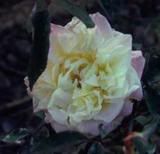 Mme Lombard Mme Lombard
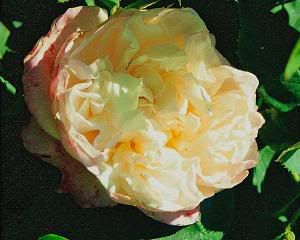
Marie Van Houtte
Anna Olivier
Souv d’Ami
Gloire de Dijon-bless her, she keeps popping up all over the place.
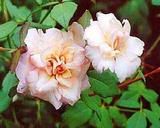
Rubens
Franziska Kruger
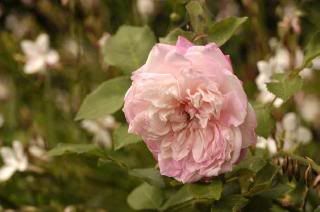
Homere
Hon Edith Gifford
![]() i163.photobucket.com/albums/t286/rosenfreund/Historical%20Roses/hardy%20T%20list/jeanducher.jpg[/IMG i163.photobucket.com/albums/t286/rosenfreund/Historical%20Roses/hardy%20T%20list/jeanducher.jpg[/IMG
Jean Ducher
Caroline Kuster
Catherine Mermet
Mme Willermoz
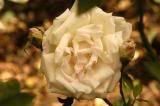
Mme Bravy
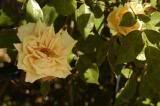 Mme Berard Those with no picture are those that I cannot locate or already shown. Before we leave the world of the Tea Rose I give you a few further images; 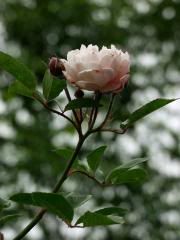 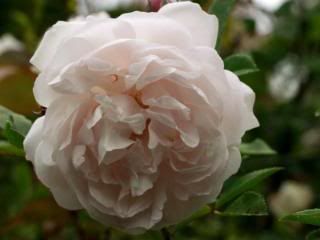 To many people “The Original Tea Rose” , looking anything but rose like. And 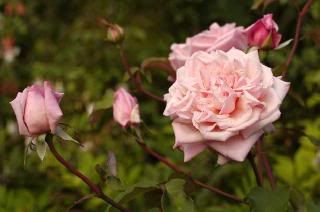 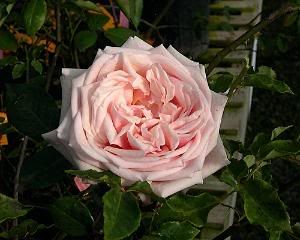 ‘Baronne Henriette de Snoy’ ‘Baronne Henriette de Snoy’ looking like an Austin creation! She was in fact introduced in 1897 and is possibly one of the last true Tea x Tea cross, or should that be Noisette x Tea cross, as her seed parent is our old friend ‘Gloire de Dijon’
|
|
|
|
Post by fozzie on Mar 1, 2008 16:02:21 GMT
Part 13 Hybrid Perpetual [/b] I have left this class to the end because it is a class of simple complexity or complex simplicity, depending on how you look at it. It is a natural progression from the previous classes to this class, however as usual, we have managed to complicate it. So slight change of format we will now go straight into the history. (With regard to the photographs, I’ll try and mix them up to show the variety of the class)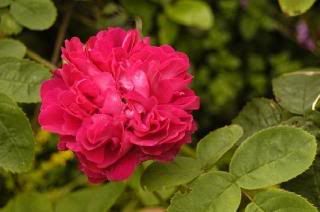 ‘Rose du Roi’ ‘Rose du Roi’ Raised in 1816 by Souchet, in the kings’ garden, at Sevres, Paris. Thought to be descending from the ‘Autumn Damask’ through the ‘Portlands’ and is nowadays looked upon as the first ‘Hybrid Perpetual’ . You will, however, also see her classified as either ‘Damask’ or ‘Portland’ . A small–medium shrub 3-5 foot in upright growth, bright crimson double flowers, strong scent and repeat flowering. History bit Chronologically these roses were around at the same times as those described in the previous 3 or 4 “groups”, circa 1810-1890. Although in their heyday, from 1840’ish onwards. In the early 1800 the ‘China’ influence in the introduction of Bourbons, Portlands and Noisettes gave a welcome change, to some, from the summer flowering roses and the so called ‘Hybrid Chinas’ . You should bear in mind that Mendelian Laws were not understood at this time, so these hybrids would still be spring/summer flowering only. In the early 19th century the term ‘Hybrid China’ would have referred to any original cross between perennial and summer flowering rose groups. 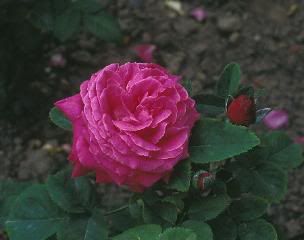 ‘Souvinir de Jeanne Balendreau’ ‘Souvinir de Jeanne Balendreau’ Introduced in France by R.Vilin in 1899.Vigerous, and almost prickles, grows to 5-6 foot. Has large flowers of a deep crimson fading to madder, long lasting and fragrant. ‘Vick’s Caprice’ 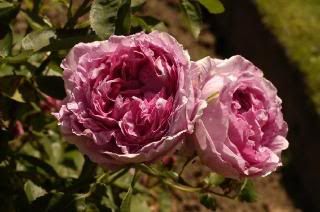 A sport of ‘Archiduchesse Elisabeth d’Autriche’ occurring in Vicks’ garden at Rochester, NY in 1897. Small compact, leafy shrub to 4 foot, producing fragrant, fully double blooms. The freely produced soft old pink flowers are flecked and striped with white or a paler pink. Inclined to “ball” and will often revert to parent. 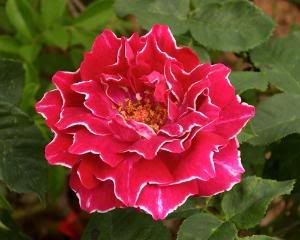 ‘Roger Lambelin’ ‘Roger Lambelin’ Another sport this time from ‘Prince Camille de Rohan’ . This one being introduced by Vve Schwartz, France in 1890.Only to be grown if you have good, rich soil, else forget it. In good conditions it will achieve 5 foot in all directions, be full of foliage and blooms. The flowers are fairly fragrant being double and a crimson purple edged with white. As they age so the crimson fades to a paler hue. Raised in 1815 and introduced in 1819 was a rose a called ‘ Rose du Roi’ her parents, allegedly, were ‘The Portland Rose x The French Rose’ although this is still the subject of some debate. She had been classed as ‘Damask’ or ‘Portland’ . Latterly, breeders have looked back at her and called her the first ‘Hybrid Perpetual’ . We therefore have a situation where all these groups arose at around the same time and to a certain extent coexisted for many a year. It would, of course, be correct of us to assume cross breeding, which brings us back to that “catch-all” ‘Hybrid China’ where all the once flowering prodigy would be held collectively (dumped). In many cases the crosses would have been between groups, including that “catch-all bucket”. A lot of the early crosses would be between ‘Hybrid Chinas’ x ‘Bourbon’ or ‘Hybrid China’ x ‘Portland’ . Because it is still fresh in your minds you will recall a Bourbon named ‘Gloire des Rosomanes’ , or was she a ‘Hybrid China’ ? I care! I mention her as she gave us the red strain of ‘Hybrid Perpetuals’ , very obviously from her oriental parent. Through her other parent she brought with her the distinctive ‘Damask’ fragrance. In time the inter breeding between ‘Hybrid Perpetuals’ and ‘Bourbons’ et al, but mainly ‘Bourbons’ would have merged all their characteristics. Thus leading to a slow down in producing ‘Bourbons’ and a leap ahead in producing ‘Hybrid Perpetuals’. Here we have three Paul’s, but only one Paul! ‘Paul Neyron’  Introduced by Levet, in France in 1869. Vigorous grower getting to 6 foot, has lots of large glossy foliage. Talking of large the flowers are also large some getting inxs of 6 inches across. They are fully double, flat and maybe quartered and carried on stiff stems. The colouration is a deep rose pink with a lilac flush and paler on reverse. May repeat and has little or no scent. 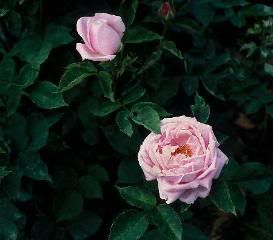 ‘Paul’s Early Blush’ ‘Paul’s Early Blush’ Introduced by G Paul, in England in 1893. A sport from ‘Heinrich Schultheis’ . A vigorous upright plant reaching 4 foot or so, it gas light green leaves and large prickles. She carries her pointed buds in clusters, on opening they produce a cupped fairly full flower, sometimes quartered of a soft pink, with a good scent, of which, some say is cinnamon. Well that’s off Mrs F‘s list then! ‘Paul Verdier’ 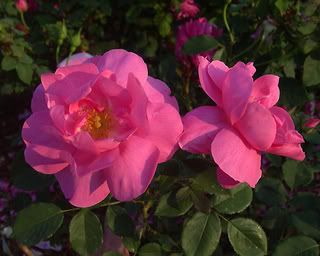 Introduced by E Verdier, in France in 1866. This Paul is a really vigorous prickly plant, with good foliage and smooth heps. The large flowers are rounded of a bright pink-crimson fading paler with age and carry a good strong scent. It was in the 1840s that they really became popular; this was mainly as the result of one man, a French breeder named Jean Laffay. Between 1837-1845 he introduced some 18 or so plants of some merit. They were all raised by taking a seedling from a ‘Hybrid China’ probably ‘Bourbon’ x ‘French Rose’ . This in turn was “selfed” and finally crossed with a ‘Bourbon’ or Portland’ to produce the final plant. Phew, just think of the elapsed time involve. If this was a planned programme or just an ad hoc series of events I am not sure. Either way, few breeding records would have been kept, as he would have had little idea of the consequences of these actions. Whereas, dear reader, you do! It turned out that the resulting plants had larger flowers; added more colours and seemed to flower for a longer time! Some flower sizes would be 6 inches or more. Later they (‘HPs’) were to make a little bit of history by being the first rose class to appear in quantity in more than one breeders catalogue. (Loosely, that is the simple bit of how we got there) Now read on. First a little touch of royalty. 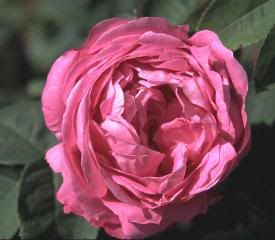 ‘La Reine’ ‘La Reine’ Introduced by Laffay in France, in circa 1840. Possibly one of the most famous and influential of the group, as she pops up all over the place in the breeding program of many other members of the group, not to mention other varieties within the group She is the head, or prototype of one of these varieties, as is ‘Paul Verdier’ , above, but I forgot to mention it there. All this will become clearer a little later on. She will grow to about 5-6 foot, bears fully double, repeat flowering flowers of a rosy pink, on near prickles stems. 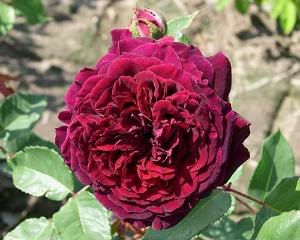 ‘Empereur du Moroc’ ‘Empereur du Moroc’ Introduced by B, Guinoiseau, in France in 1858, Seedling from ‘Géant des Batailles’ At first sight she may appear a weakling, however she is a strong growing, free flowering plant that will reach 4 foot. She would have inherited that spindly growth and colouring from a ‘China’ in her past. She has dark red double flowers, with a look of velvet and not a hint of purple. The petals are small, often quilled and sometimes quartered. Has a very strong fragrance. Her colour is probably her historic claim to fame, being the first to achieve such an intense colour. None of her peers, at the time were able to match her. Although the odd ‘Gallica’ might. 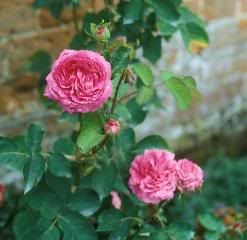 ‘Duchess de Cambaceres’ ‘Duchess de Cambaceres’ Introduced by Fontaine in France in 1854. A somewhat lax growth habit, with prickly stems and flower stalks. Her flowers are held in clusters and are full, cupped of a light crimson with darker veining and lilac edges to the petals. Quoted variously as having a sweet scent, a good scent or a good old-fashioned rose scent? She will repeat in autumn. Again, various quotes on height ranging from 5 – 8 foot. For a plant with lax growth she must take up some amount of space. The clue regarding the complexity is in the last paragraph above. Given Laffays success other breeders joined in. For whatever reason they were producing plants that were not quite what they were supposed to be. Which gives rise to the perpetual myth, (wince with sharp intake of breath) id est, not all ‘Hybrid Perpetuals’ are what it says on the label. Some will flower continuous, others in flushes and some will only repeat in autumn. All of which could have come from the same hip, how frustrating! It is more likely due to all the various parents used out of that “catch-all bucket”. As much as it hurts to say, the French recognised the problem with the name and called them ‘Hybride Remontant’ . It would not only be the flowering time recessive genes that were paired and thus reinforced, it could be any number of physical characteristics. You’re ahead of me I can tell. Here we have this class called ’ Hybrid Perpetuals’ and they are different from each other, sometimes minor difference and sometimes a major. So what do we do we invent different types within the class! Why? So florists can be sure that they are buying the type with long stalks and few prickle, and competition judges are comparing “apples with apples”, (well, they are the same family) when wandering around the display halls. How about an English commoner or two! ‘John Hopper’ 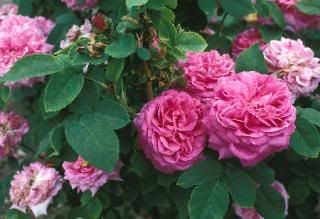 Introduced by Ward in England in 1862. A product of ‘Jules Margottin’ x ‘Mme Vidot’ Fully double flowers in the old style, rolled petals but rather loose. Bright rose blooms edged in lilac with centres of carmine. They are nearly globular, large, very fragrant and borne on a vigorous, upright, bush. Getting to maybe 5 foot. Sometimes repeats later in the year. I would call them a “cabbage” flower in the true sense of the term. 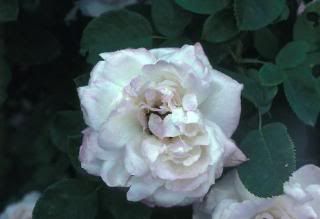 ‘Mabel Morrison’ ‘Mabel Morrison’ I always think there’s something very English about the name Mabel , wrong its bruddy French! The rose most definitely is not. It was introduced by Broughton, in England in 1878. Reportedly the sport of ‘Baroness Rothschild’ , who herself was a sport of ’Souvinir de la Reine d’Angleterre’ It is therefore not surprising that she looks less like a ‘Hybrid Perpetual’ and more like a ‘Portland’ She has fully double flowers of a light pink fading white, that will repeat in the autumn, when flowers will fade to a softer pink with pink. Small shrub getting to 3-5 foot. ‘Mrs John Laing’ 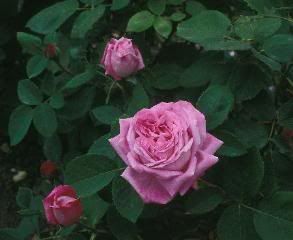 Introduced by H. Bennett, in England in 1887. No relation to the Gordon Bennett of NY Herald and Staley/Livingston fame. To whom the “Gordon Bennett” phrase is associated although the dates would be about right. OK, sorry I was off on one of my tangents again. So back to the rose, being English she is bound to shine, and she does not let us down. Since her introduction no other rose has managed to capture that “old world” uniform pink colour with its faint lilac flush. Again, being English she is tolerant of both poor soils and rain, that is to say she will not “ball” in damp conditions. In good soil she excels. Getting to 6 foot plus on strong stiff stems with an upright growth pattern. The flowers are large, double, with high outer petals and shorter inners and opens to a well filled cupped bloom. She has a good scent and the foliage is a light green, dull (matt) and smooth. The ‘Hybrid Perpetuals’ reigned supreme over all other roses in the Victorian garden, until circa 1900. In its prime there were literally 1000s in numerous catalogues, today there are only a few, less than 100. Not a bad thing really, as, most of the others were only fit for the compost heap, certainly not fit for use as “garden roses”. But then I would say that, I hear you say, as they are so close to those other “Hybrids”. These are in fact the opinions of some guys called, Dean Hole, George Paul and Rev Foster-Melliar. Oh, all right, all right the compost heap was my idea. Theirs was the not garden quality bit. Towards the last quarter of the 19th century the over use of ‘Chinas and Teas’ in particular the ‘China Roses’ weakened the strain of the new output at that time, which in turn added to its down turn in popularity and eventual demise. In 1859 a rose called ‘Victor Verdier’ arrived, her parents were ‘Hybrid Perpetual’ x ‘Tea’ as was the parents of ‘La France’ that arrived in 1867. So why is this not an ‘HT ? I know not. From these parents a group of varieties were raised that carried a strong ‘Tea’ influence. By the beginning of the 20th century the dominance of the ‘Hybrid Perpetuals’ had been broken and those other “Hybrids” had started their insidious march towards World domination. Which means, like its partner the ‘Tea’ , the ‘Hybrid Perpetual’ was killed off by its prodigy. If, and it’s a BIG IF, I ever returned to having a bed of those other “Hybrids”, there is no doubt that a ‘Hybrid Perpetual’ and ‘Tea’ [/b], despite their frailties, would have centre stage. Plus nothing past 1940/50’ish A couple of military representatives and English royals, one of which, being the only English rose named as the head of an ‘HP’ variety! What can I say? 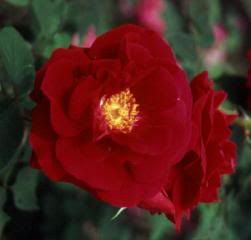 ‘General Jacqueminot’ ‘General Jacqueminot’ Introduced by Roussel in France, in 1853. Considered by many to be an important variety, of which this is the head/prototype. Alleged cross between ‘Gloire des Rosomanes’ x ‘Géant des Batailles’ . When introduced was possibly the most brilliant red. She has large, rich crimson flowers, fully double and carried on stiff stems. Very fragrant. The shrub itself is vigorous with good foliage, the main display is in the summer with a reduced repeat in the autumn. Reaches 6 foot or so on a good soil. (Not sure this picture does her justice but it’s the best I could find). Affectionately known as General Jac(k) ‘Captain Haywood’ 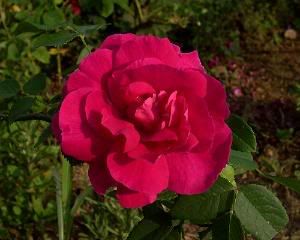 Raised by H Bennett at Shepperton and introduced in 1894. A plant of open growth attaining some 6-7 foot, and good display of large foliage. The flowers of strong crimson-scarlet, emerge from long smooth hips are loosely formed and show some stamens ‘Her Majesty’ 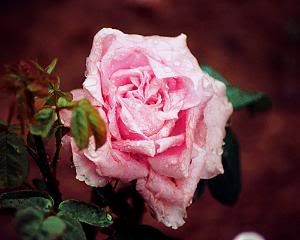 Introduced by Henry Bennett, England in 1885. A strong, short upright bust to some 3 foot. She is well covered in prickles and good foliage. Her very large blooms are full of two tone pink petals. The flowers have little scent but will repeat in autumn. 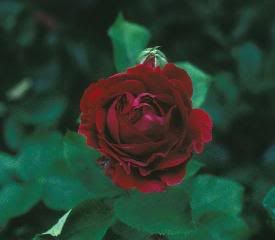 ‘Duke of Edinburgh’ ‘Duke of Edinburgh’ William Paul introduced her in 1868. So not our “Phil the Greek”, born on a kitchen table on the island of Corfu! Did you know he has a claim to the throne of England as a descendant of Victoria? Talking of whom, it was her second son Alfred, who was DoE at the time, so must assume it was he that the rose was named after. He later became Duke of Saxe-Coburg and ended his days in Germany. Interestingly our Phil’s mother was a Battenburg, which was later changed to Mountbatten. (Something to do with an argument regarding an assassination in the Balkans, a more serious consequence of which, is those acres upon acres of serried rows of white stones, that still bring a tear). Back to the rose, she is a small/medium shrub to 4 foot or so. Her flowers are a strong crimson/purple veined with red, has a good scent and smooth hips. Supposedly not an easy rose to grow in any but good soil, so an ideal candidate for a container, where you would be able to control the condition. On the downside the flowers have been known to “ball” Description It is such a varied class, to be nearly impossible to describe. Each of the 12 or so varieties would have their own descriptors albeit with only minor subtle differences, ’Hybrid Perpetuals’ will have big, cabbage like blossoms at the top of a long, often arching cane. As ‘Hybrid Perpetuals’ were developed simultaneously with the rise of rose shows and competition, the forms became increasingly refined over the years from the original muddled or quartered look (now back in fashion!) to a rather fulsome version of what we might expect in a rose of today. (Quoted from an American breeder.) As I said, difficult to capture due to size of gene pool. So they range from small shrubs up to large arching shrubs and or small climbers. Double or semi double flowers, dark wood, light wood light foliage dark foliage and so on. The Victorians used a technique that I have copied, albeit on different types of rose. That being to peg down the arching shoots, thus forcing flowers along its length. Similar to training climbers on the horizontal. They are normally hardy down to zone 5/6 say somewhere between R.gallica and ‘Tea Roses’ . They require a good soil to strut their stuff and are greedy feeders, requiring additional nourishment at least twice a year! Just to complete this description section I’ll give you a quick over view of the varieties as mentioned above. I am going to introduce 3 people here; one you may only just have heard of, Mons Gravereaux (of L’Haÿ fame) one you would know if you are a Rosarian, Rev Pemberton and a cousin from across the pond one Henry B. Ellwanger, reputedly a ‘Hybrid Perpetual’ expert from 1800s. All three produced a list of ‘HP’ varieties based on their characteristics or as the Rev put it. Extensive as this class is, the varieties appear to range themselves in distinct groups or types, differing in wood, foliage, flower, and habit. This is due to their parentage, for they have all come from a comparatively few varieties. Just for their names! 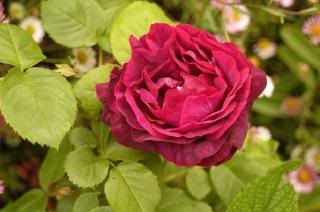 ‘Prince Camille de Rohan’ ‘Prince Camille de Rohan’ Introduced by Verdier in 1861. Cupped flowers very deep velvety crimson-maroon, strongly scented, sometimes recurrent. Vigorous upright growth, grow as a small shrub, getting to 4-5 foot. Parentage: possibly ‘Général Jacqueminot’ x ‘Géant des Batailles’ seedling . (bet you thought Rohan was a Tolkien creation or the manufacturer of my outdoor clothing. It was real and associated with the region of Brittany 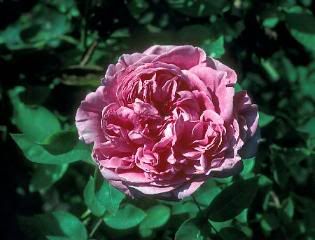 ‘Archiduchesse Elisabeth d’Autriche’ ‘Archiduchesse Elisabeth d’Autriche’ Introduced by Robert et Moreau, in France in 1881. Small, bushy shrub to 4 foot, producing fragrant, fully double blooms on short, near prickless stems. The freely produced soft lilac pink flowers are very fragrant. (Will not insult your intelligence with explanation of the name)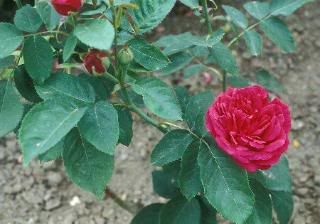 ‘Gloire d’un Enfant d’Hiram’ ‘Gloire d’un Enfant d’Hiram’ [/b] Introduced by Vilin, in France in 1899. A vigorous plant reaching 7 foot, somewhat thinly covered with leaves and has large prickles. The flowers are a intense crimson from a deep red bud, only fading slightly when fully open. (Have no idea of the significance of Children of Hiram, feel free to educate me I need it.)With the first list we have Ellwanger, I have given the descriptions on top and bottom entry just as a flavour, bear in mind each would have its own descriptor Baronne Prévost Type 1842 This type makes long, stout shoots, fortified with red thorns of unequal length, but generally short; foliage rather oval, somewhat crimpled; flowers large, or very large, of flat shape, very fill, fragrant, of some shade of rose. It is the most hardy we have. The varieties commonly grown are Boieldieu, Colonel de Rougemont, Madame Boll, and Oderic Vital. They are all free bloomers in autumn La Reine Type 1844 Géant des Batailles Type 1846 General Jacqueminot Type 1852 Victor Verdier Type 1852 Jules Margottin Type 1853 Sénateur Vaisse Type 1859 Charles Lefebvre Type 1861 Prince Camille Type1861 Alfred Colomb Type 1865 Duke of Edinburgh Type 1868 This was the only English Rose to be the head of a group. Introduced by George Paul in 1868. The habit of growth is much like that of Jacqueminot, but the foliage is generally longer and larger. The flowers are not permanent in colour, burning very quickly in the sun, and are sparsely produced in the autumn. It is a very beautiful family when grown in a moist, cool climate; but there are few of the members that will do well in hot sun. The varieties best known, mostly of recent origin, are: Brightness of Cheshunt, Dr. Hooker, Duke of Connaught, Duke of Teck, Robert Marnock, S. Reynolds Hole, Sultan of Zanzibar, The Shah. A few of those above that you have not seen already. ‘Baronne Prevost’ 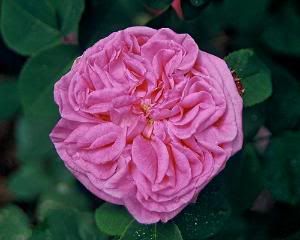 Introduced by Desprez, in France in 1842. Was described in William Pauls’ catalogue as “ Flowers clear pale rose, glossy, very large and full. Habit erect; growth, robust.” I’ll add the following from other sources. She flowers freely and being an early ‘Hybrid Perpetual’ retains the “old rose” form. Her flowers are often 4-5 inches across and of a rich pink, tinted lilac, quartered and with a button eye. Grows to 4-5 foot, will flower through summer to autumn. 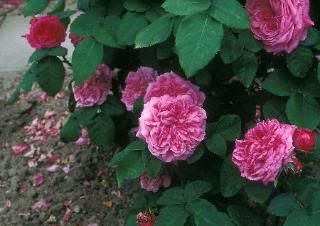 ‘Géant des Batailles’ ‘Géant des Batailles’ Introduced by Nerard in France in 1846. The flowers are double, opening crimson fading lighter with age and repeating in flushes through season. They are carried on a small shrub 3-5 foot and have a good fragrance. Recorded as a sport from ‘Gloire des Rosomanes’ ( Looks like the Baronne above but must be a difference somewhere as they are both heads of varieties) ‘Victor Verdier’  Introduced by Lacharme in 1859. Flowers are bright carmine, double, with moderate scent, will repeat in autumn. She is a small shrub 4-5 foot of bushy vigorous growth. Parentage; ‘Jules Margottin’ x ‘Safrano’ . 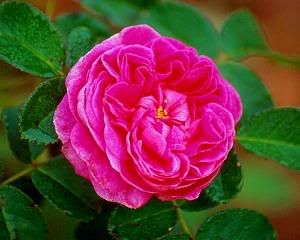 ‘Jules Margottin’ ‘Jules Margottin’ Introduced by Margottin in France in 1853. Appears to have been used as a parent more than a garden plant. Given this description you’ll see why. It is a course, prickly plant and not truly perpetual. She has large, double flowers of a carmine red that open flat and show signs of quartering, but carry little fragrance. The flowers are carried on stems armed with large prickles and will repeat. The plant will grow to 6 foot or so. Recorded as a sport of ‘La Reine’ Our friend Jules Gravereaux produced a book on the Rose cultivars at L’Haÿ. In which he gives his version of the ‘Hybrid Perpetual’ varieties, he lists 12; La Reine, Baronne Prévost, Géant des Batailles, Victor Verdier, General Jacqueminot, Jules Margottin, Madame Recamier, Triomphe de l'Exposition, Madame Victor Verdier, Charles Lefebvre, and Baronne A. de Rothschild were prototypes for the first eleven groups. The twelfth group was named Hybrides Remontantes non-classes , or those that could not be classified into one of the other eleven groups (He obviously got bored. I wonder why? I can think of a shorter name for that last variety)Ellwanger and Gravereaux agreed on seven of the prototypes for the groups: Baronne Prévost, La Reine, Géant des Batailles, General Jacqueminot, Victor Verdier, Jules Margottin and Charles Lefebvre. Ellwanger placed Senateur Vaisse at the head of a class; whereas, Gravereaux chose Madame Victor Verdier to represent the same class. Gravereaux grouped Prince Camille with the General Jacqueminot group. Gravereaux grouped Alfred Colomb and Duke of Edinburgh with the Madame Victor Verdier class. Gravereaux had three distinct groups, which Ellwanger did not have: Triomphe de l'Exposition, Baronne A. de Rothschild and Madame Récamier. Ellwanger grouped Madame Récamier with Hybrid Noisettes. Ellwanger did not specify where Baronne Rothschild and Triomphe de l'Exposition should be placed. He did say, however, that Baronne Rothschild was a very distinct and beautiful rose. (Wasn’t that nice of him?)More of the above named. 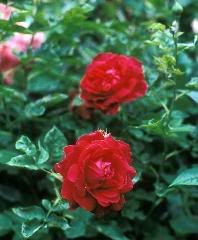 ‘Alfred Colomb’ ‘Alfred Colomb’ Introduced by Lacharme, in France, in 1865. Recorded as a sport from ‘General Jack’ . A vigorous bushy plant reaching 4-5 foot, Repeats to a lesser degree in the autumn. The flowers are cupped full and a scarlet crimson, fading to a purple with age, strong fragrance. 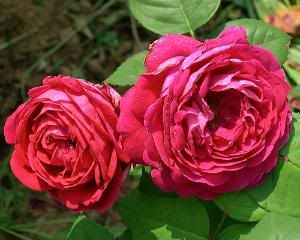 ‘Charles Lefebvre’ ‘Charles Lefebvre’ Introduced by Lacharme, in France in 1861. Parents ‘General Jack’ x ‘Victor Verdier’ . Sounds similar to Alf above Flowers are a bright red fading purple, large, cupped, full and will repeat in autumn. Carried on a medium shrub to some 5 foot or so. 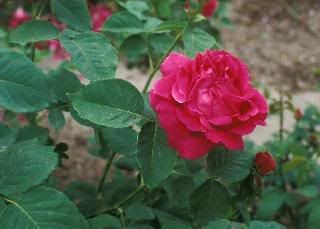 ‘Mme Victor Verdier’ ‘Mme Victor Verdier’ Introduced by E Verdier, in France, in 1863. Large, clear pink flowers, with a strong scent, double and repeating in autumn. The plants growth is vigorous reaching 5 foot. Which leaves us with the Rev. Now to be fair, to the guy, he only identifies what he calls the chief varieties, in a paper on ‘Hybrid Perpetuals’ published in 1908. Géant des Batailles Jules Margottin a prolific parent, from which have been produced such types as Annie Laxton, Marquise de Castellane, Duchesse de Vallombrosa and many others. General Jacqueminot giving us strong growing reds, as, for instance, Marie Baumann, Senateur Vaisse, Duke of Edinburgh, and most beautiful of all Horace Vernet. La Reine d'Angleterre , presenting roses of the short, sturdy, erect type, such as Baroness Rothschild, Merveille de Lyon, and Gustave Piganeau. La Reine from which came François Michelon, Anna de Diesbach , and others of which these are types. Charles Lefebvre the parent probably of such smooth-wooded varieties of dark reds as Comte Raimbaud, Victor Hugo, Duchess of Bedford , and others. Victor Verdier (Lacharme, 1859). This is the chief parent of the class. To it we are indebted for those short, stout, upright, free-flowering varieties, such as Marie Finger, Etienne Levet. Comtesse d’Oxford and Suzanne Marie Rodocanachi. According to the Rev., rabbits are fond of this class, especially the last-named variety, preferring it to any Tea or Hybrid Tea ; he concludes from this that a high degree of the Tea element is contained in the Victor Verdier variety. (I am not able to follow the logic, rabbits are “teaoholics”?)I give you all this, so you have a fuller understanding of the class. (Personally it is all beyond me I find it quite laughable and as much use as a concrete parachute) It should be remembered that the poor old ‘Hybrid Perpetuals’ were growing up at the same time as “bench” standards were being evolved, add to that the size and diversity of their gene pool, it is no wonder they were documented to the nth degree. Needless to say it has all died a death I hope! Fortunately, we mere mortals, who really do not care if the prickles are straight or hooked, call them ‘Hybrid Perpetuals’ A few memories. 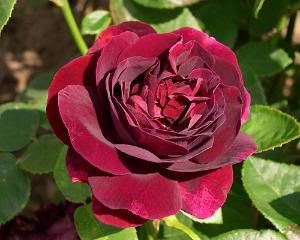 ‘Souvinir du Docteur Jamain’ ‘Souvinir du Docteur Jamain’ Introduced by Lacharme, in France, in 1865, from a ‘General Jack’ x ‘Charles Lefebvre’ cross. I must admit this is a good colour, if I had to choose one, then this or ‘La Reine’ would be it. She is not a sun worshipper and requires good soil conditions, if fact would be best out of the sun as too much damages the blooms. On good soil she will get to 10 foot, so a west facing wall would be good, don’t forget pin the forward facing shoots down to the ground to form an arch. You will then be rewarded with masses of those velvet looking wine coloured flowers along each stem, will repeat in autumn. (Every now and again a cultivar will stand out, well this is it for ‘HP’ . If you get the chance to see her in full flower you’ll understand)  ‘Souvinir de Brod’ aka ‘Erinnerung an Brod’ ‘Souvinir de Brod’ aka ‘Erinnerung an Brod’ Introduced by Geschwind, in Hungary, in 1886. Said to be the result of a R.setigera x ‘Genie de Chateaubriand’ that is doubtful as there appears to be little R.setigera and she has the look of a typical, if there is such a thing, ‘Hybrid Perpetual’ . She will grow to 8 foot with double flowers, quartered, with pleated petals and opening flat. They have good fragrance and repeat in autumn. Any shade from cerise to crimson purple can be found in individual flowers. Brod is a town in Bosnia or was it Austria-Hungary at the time? 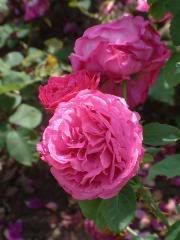 ‘Souvinir de La Princesse Amelie des Pays-Bas’ ‘Souvinir de La Princesse Amelie des Pays-Bas’ . Introduced by Liabaud, in France, in 1873. Large double mauve to carmine flowers. Double with little fragrance and repeating in autumn. She is a medium sized shrub getting to 5 foot. Pruning When we come to consider the question of pruning the ‘Hybrid Perpetual’ I am at a loss to know exactly what to say. For instance, no rule as to pruning could be laid down which would be equally applicable, let us say, to ‘Ulrich Brünner’ and ‘Victor Hugo’ , nor would the same advice suit both ‘General Jacqueminot’ and ‘Victor Verdier’ . Basically all you need to do is watch them, see how they grow and adapt the pruning rules as described in previous “chapters”. Which I am sure you know backwards by now. As this is the last entry in this Icelandic Saga I offer you a bonus item, still connected with ‘Hybrid Perpetuals’ but encroaching past 1900. Remember some 11 or 12 moons ago, doesn’t time fly, I said that the modern yellows and other vibrant colour combinations owed their existence to a certain ‘Species Rose’ well this is how; ‘Pernet Rose’ It is a cross between a ‘Hybrid Perpetual’ and R.lutea (aka R.foetida or ‘Austrian Brier’). R.lutea has brilliant yellow flowers that on occasion will “sport” to a bicolour with the petals having bright red on the upper or inner side of the petal whilst being a bright yellow on the lower or outer side. This plant was notoriously sterile, as I have said before, no such thing as a totally sterile rose, just degrees of how easy it will pollinate or germinate. Well, this French breeder caller Pernet-Ducher, he was born Joseph Pernet, his firm worked closely with that of another breeder named Claude Ducher. So close was this relationship that he married the “boss’s” daughter and named himself Joseph Pernet-Ducher. He spent 5 years proving just how difficult R.lutea was to work with. He crossed literally thousands of ‘Hybrid Perpetuals’ with pollen from R.lutea . His aim was the introduction of the bright yellow as opposed to the soft yellow from ‘Tea Roses’ . He started this task in 1883 but it was not till 1888 that he managed to get any seedling. These two seedlings came from a cross using ‘Antoine Ducher’ raised by his father in law. The important unnamed seedling first flowered in 1893, as often in hybridising the seedling, it did not show its true potential until its second season. In general this seedling had the overall shape and growth pattern, flower size and fragrance of its maternal donor but showed a strong resemblance to its paternal donor in wood, prickles and those bicolour flowers. . This seedling was kept as a breeding plant. Pernet-Ducher then crossed it with ’HTs’ to produce the first ‘Pernet Rose’ ‘Soleil d’Or’ and many more. With them came the possibility of true yellows, oranges and gold. There is always a cost and in this case it was “Black Spot”, which is a consequence of using R.lutea They were bred as a separate class till they were swallowed up by you know what in circa 1940. Which again begs the question? What is a ‘Hybrid Tea’ ? OK here are the parents and a couple of examples 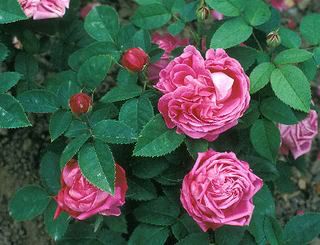 ‘Antoine Ducher’ R.lutea ‘Antoine Ducher’ R.lutea  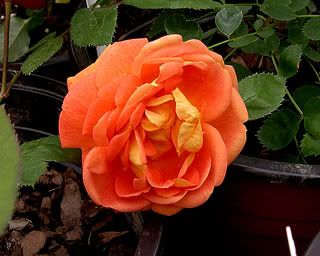 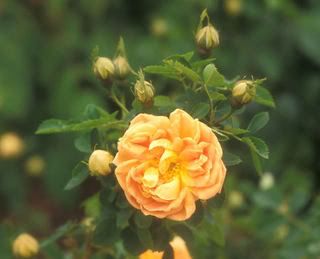 Both are quoted as being ‘Soleil d’Or’ and they are! Just shows you the influence of R.lutea the first of this class introduced in 1900 by Pernet-Ducher, it was a big breakthrough in colour in its day as it brought the yellow-orange colours of the Rosa foetida group into the modern roses. Flowers are double, orange-yellow to ruddy gold, shaded nasturtium red and will repeat; scent moderate; foliage rich green, growth vigorous. Height to 4 foot 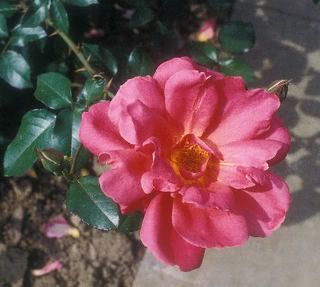 ‘Gwyneth Jones’ ‘Gwyneth Jones’ introduced by McGredy in 1925, in NI. Pointed buds, flowers brilliant carmine-orange, semi-double; growth vigorous, bushy. Semi double flowers that will repeat
|
|
|
|
Post by fozzie on Mar 1, 2008 16:06:30 GMT
The Epilogue.
Well here we are, the last post, so to speak and I am sure you’ll pardon that pun.
For those still with me, I know there are a few, are you still here BB? I salute your tenacity, stamina and steadfastness in the face of some pretty turgid stuff at times. I trust like me you have enjoyed the journey and even learnt a little on the way. I hope my meanderings, off topic, have not been too irritating, it’s just me. Well one thing leads to another and off I go. I do like to pass on what is seemingly useless information, and you never know. One day the conversation will drop in the snug and there’s your chance! You’re in. Recessive genes. Kitchen tables in Corfu, Yellow colour in modern Roses. Mr Champneys from Charlestown. Mendelian theories versus Darwinian theories.
If I have managed to make only one of you think differently about the rose, I am content. If I have been party to you obtaining a rose, I am happy. If I have been party to you obtaining an ‘Old Rose’, preferably pre-China or better still a ‘Species Rose’ then I am ecstatic. Showing my true colours there I’m afraid, but you all knew that. My heart is with the Species and the pre China Roses. Completing these last few sections by meandering through the Post Chinas has just reinforced that view. To me the rose is a perennial shrub just like any other; it grows new shoots in the spring, flowers in the summer, goes to seed in the autumn and sleeps in the winter. Pruning would be as and when you think necessary, giving some thought to flowering habit and size, as you would for Ribes or Forsythia.
It has always been a source of amusement, not to mention amazement, that a plant such as the HT has managed to survive. It has been and I guess still is the most popular of garden plants. But no other perennial has so many down sides; it needs a lot of watering, if we ever get another warm summer, has more diseases than any other perennial, not fully winter hardy, despite assurances. It requires a high degree of maintenance (feeding, spraying, pruning) and attracts a large amount of pests. Add to that, a relatively short life span and no fragrance! (In most of them) and it makes you wonder.
Yet, every year, new cultivars gets “pushed” via advertising, but very few of these will last more than 5 years in the garden centre. I am convinced that their continued popularity is a credit to the advertising industry. First by installing it as the stereotypical “rose” and then by the continuation of the myth. You still find garden centres that will only have HTs in their rose section - I have been asked to leave one or two!! (Grumpy Old Man syndrome)
Whilst researching a number of the latter “chapters” particularly those covering the 19th century roses, it occurred to me that the term Hybrid Tea and the alleged date of the first are somewhat fluid, to say the least. Here comes more heresy, La France (1867), the first HT? It took the NRS in London till 1893, to allow the terminology to be used. (I have omitted the R, not sure when it got the charter). Parentage of La France was never really documented, always assumed to be a HP x Tea, which is logical both repeat/continuous flowers. Why this particular hybrid. Why this particular set of parents. Why not Noisette x Tea or Bourbon x Tea. You could be even more radical and argue that a Tea x Tea could be a HT. This leads us back to the Chinas, which as you now know are garden hybrids so are they the HTs? I suppose a line had to be drawn somewhere and we are left with a jumble of meaningless class names and a peg in the ground somewhere around 1868-1893!
Now turning that around and to show that I am not all bad. The HT is only the messenger, the fruit of the hybridisers, who, themselves, were trying to earn a crust by meeting popular demands for garden plants. Not unlike the hybridisers of previous centuries, although theirs was more “pot luck” rather than “engineering”. Perhaps then, HTs are an important step along the way. If only it was a short step. Bless them, they have been hybridised to hell and back. So much so that they have lost all resemblance to the earlier examples. Why do I want a blue one? Why do I want one with no prickles? The latter I can achieve, or get very close, naturally, in those I like? It seems to me that we are fighting shy of naming another class solely on a commercial basis. Thank goodness for the likes of Lambert, Poulsen, Kordes and Austin. Given a choice I would choose those that have stood the test of time, I define that as pre 1940, give or take a few, but would stay away from the garish and try to stick to solid colours
National Trust (the exception to my date rule), Mme. Caroline Testout, White Wings, Mrs Oakley Fisher and Soleil d'Or so I can look at the reason black spot is bred into modern roses, Grace Darling, Jean Sisley, Crimson Glory, Angele Pernet and Diamod Jubilee, to name a few. You see I am familiar with some of them, well they have been around since 1800’ish.
If you would care look up those last two and then explain to a simple boy like me how they are in the same class I’ll be eternally grateful. That was rhetorical, or you can do it for interest sake, because realistically it does not matter as long as you like what you see
Just been reading the early parts again. Funny how they felt stiff and clumsy compared to the latter entries. Its like I have relaxed in your company and we are just sitting around an open fire on a winters evening chatting.
[Exit stage left with large Bushmills in left hand and Modern Roses in right hand, looking for comfortable wing back armchair]
[Curtains]
|
|































































 ( In full glory!)
( In full glory!)

























 R.chinensis. Minima (aka Angel Rose, Rosa indica pumila, R. laurentiae, R.lawranceana, R. semperflorens minim.) A small China shrub rose introduced around 1815, semi-double flowers, continuous flowering, little scent. Important rose in the beginnings of miniature roses. Recognised as a variety of R. chinensis it has a dwarf spreading habit.
R.chinensis. Minima (aka Angel Rose, Rosa indica pumila, R. laurentiae, R.lawranceana, R. semperflorens minim.) A small China shrub rose introduced around 1815, semi-double flowers, continuous flowering, little scent. Important rose in the beginnings of miniature roses. Recognised as a variety of R. chinensis it has a dwarf spreading habit.























 Hermosa -Introduced in 1837 by Marcheseau - small shrub (under 3'), fragrant, repeat flowering good for a pot
Hermosa -Introduced in 1837 by Marcheseau - small shrub (under 3'), fragrant, repeat flowering good for a pot Setina -Introduced in 1879 by Henderson - slight fragrance, repeat flowering climbing sport of Hermosa
Setina -Introduced in 1879 by Henderson - slight fragrance, repeat flowering climbing sport of Hermosa


























 R.gallica var officinalis
R.gallica var officinalis  R.x francofurtana also known as the Frankfort Rose and
R.x francofurtana also known as the Frankfort Rose and  R.gallica var Pumila also known as the Dwarf Red Rose
R.gallica var Pumila also known as the Dwarf Red Rose
 R.gallica “Tuscany” (aka The Old Velvet Rose)
R.gallica “Tuscany” (aka The Old Velvet Rose) R.gallica “Conditorum”
R.gallica “Conditorum” 
 R.gallica ‘Belle deCrecy’ Introduced by Hardy 1829, allegedly raised by Roeser at Mme Pompadours’ chateau at Crecy (?) date unknown
R.gallica ‘Belle deCrecy’ Introduced by Hardy 1829, allegedly raised by Roeser at Mme Pompadours’ chateau at Crecy (?) date unknown R.gallica ‘Gloire de France’ Introduced Vibert 1819
R.gallica ‘Gloire de France’ Introduced Vibert 1819 R.gallica ‘du Maitre d’Ecole’ Introduced Coquereau 1831
R.gallica ‘du Maitre d’Ecole’ Introduced Coquereau 1831
 R.gallica ‘Agathe Incarnata’ Vibert 1815 has Damask influence.
R.gallica ‘Agathe Incarnata’ Vibert 1815 has Damask influence. R.gallica ‘Cardinal de Richelieu’ Introduced by Laffay 1840, some say bred by Van Sian in Holland others say Parmentier in Belgium
R.gallica ‘Cardinal de Richelieu’ Introduced by Laffay 1840, some say bred by Van Sian in Holland others say Parmentier in Belgium  R.gallica ‘Hippolyte’ No information
R.gallica ‘Hippolyte’ No information

 R.gallica ‘agatha’ Details unknown but circa 1750s aka ‘Pope Pius IX’ or even ‘The Frankfort Rose’
R.gallica ‘agatha’ Details unknown but circa 1750s aka ‘Pope Pius IX’ or even ‘The Frankfort Rose’ R.gallica ‘Empress Josephine’ Again no reliable information but is also sometimes called ‘The Frankfort Rose’. Both Josephine and Agatha will reach up to 6 foot while the hybrid type will only get to 3-4 feet.
R.gallica ‘Empress Josephine’ Again no reliable information but is also sometimes called ‘The Frankfort Rose’. Both Josephine and Agatha will reach up to 6 foot while the hybrid type will only get to 3-4 feet.





























 R.phoenicia
R.phoenicia  R.gallica
R.gallica 




 R.brunonii
R.brunonii  R.moschata The summer flowering one, as growing in Plockets’ garden.
R.moschata The summer flowering one, as growing in Plockets’ garden. This is, allegedly, the one found in Myddleton House, but its difficult to unravel. Even this one is thought not to be pure and must therefore be a hybrid. Not surprising, can you tell difference from the one pictured above it? (Unless you have a serious sleep problem, my advice is, do not go there!)
This is, allegedly, the one found in Myddleton House, but its difficult to unravel. Even this one is thought not to be pure and must therefore be a hybrid. Not surprising, can you tell difference from the one pictured above it? (Unless you have a serious sleep problem, my advice is, do not go there!) ‘Botzaris’ Introduced 1856 Robert. Medium sized shrub up to 5 foot by 3 foot wide. The flowers are double opening flat, creamy white, quartered with ‘button eye’ (where there are so many petals that the Stigma and Stamen get distorted to form a tight centre. I’ll show you a better example in Mme Hardy ). The white is possibly from R.alba
‘Botzaris’ Introduced 1856 Robert. Medium sized shrub up to 5 foot by 3 foot wide. The flowers are double opening flat, creamy white, quartered with ‘button eye’ (where there are so many petals that the Stigma and Stamen get distorted to form a tight centre. I’ll show you a better example in Mme Hardy ). The white is possibly from R.alba  ’Mme Hardy’ The keen eyed amongst you will recognise the fence-yes its mine! Introduced by Hardy, in 1832. Allegedly part R.centifolia , not sure to what extent. She produces a sturdy bush up to 5-6 foot, on good soil. The broad mid-green leaves and variety of prickles are not typical Damask . The clusters of flowers, however, are very typical of the group. The white flowers open cupped but very quickly becoming flat, the outer petals reflexing to leave the centre almost concave with a green eye. In the words of Dean Hole she was a perfect white and well formed rose, but alas green eyed, jealous maybe of Mme Zoutman , who had no such eye.
’Mme Hardy’ The keen eyed amongst you will recognise the fence-yes its mine! Introduced by Hardy, in 1832. Allegedly part R.centifolia , not sure to what extent. She produces a sturdy bush up to 5-6 foot, on good soil. The broad mid-green leaves and variety of prickles are not typical Damask . The clusters of flowers, however, are very typical of the group. The white flowers open cupped but very quickly becoming flat, the outer petals reflexing to leave the centre almost concave with a green eye. In the words of Dean Hole she was a perfect white and well formed rose, but alas green eyed, jealous maybe of Mme Zoutman , who had no such eye. ’Duchess of Portland’ Circa 1780.
’Duchess of Portland’ Circa 1780. ’York and Lancaster’ aka ‘Versicolor’ Introduction date unknown so best to say prior 1600. A typical tall growing Damask , mixed prickle size and shape, green wood with grey/green leaves. She has clusters of long stem flowers spraying outward, in blush and light pink. They are loosely double, may be wholly the paler or the stronger colour, or flaked with one or the other. They are never striped as in ‘Rosa Mundi’. A medium sized shrub up to 5 foot on good soil and like me, prefers partial shade.
’York and Lancaster’ aka ‘Versicolor’ Introduction date unknown so best to say prior 1600. A typical tall growing Damask , mixed prickle size and shape, green wood with grey/green leaves. She has clusters of long stem flowers spraying outward, in blush and light pink. They are loosely double, may be wholly the paler or the stronger colour, or flaked with one or the other. They are never striped as in ‘Rosa Mundi’. A medium sized shrub up to 5 foot on good soil and like me, prefers partial shade. ’Catherine Ghislaine’ (Here’s that name again BB, not forgotten you) aka ‘Rose du Roi a Fleures Blanches' Introduced 1849 by Dubos Sometimes classed as a Portland She is a small/medium sized bushy shrub up to 4-5 foot, with small prickles and bristles. Light green leaves with a typical thin Damask hep. The flowers open blush pink then fading to a creamy white when fully open, with a muddled middle!( Know the feeling)
’Catherine Ghislaine’ (Here’s that name again BB, not forgotten you) aka ‘Rose du Roi a Fleures Blanches' Introduced 1849 by Dubos Sometimes classed as a Portland She is a small/medium sized bushy shrub up to 4-5 foot, with small prickles and bristles. Light green leaves with a typical thin Damask hep. The flowers open blush pink then fading to a creamy white when fully open, with a muddled middle!( Know the feeling) ‘Gloire de Guilan’ Introduced by Hilling 1949 A sprawling shrub up to 4 foot, small curved prickles. It has cupped blooms that open flat, the blooms are quartered and some petals remain folded. The colour is a very clear pink. The rose was collected and named by Miss Nancy Lindsay during the period between the WWs. It was growing in Iran where it is used to produce attar of Roses.
‘Gloire de Guilan’ Introduced by Hilling 1949 A sprawling shrub up to 4 foot, small curved prickles. It has cupped blooms that open flat, the blooms are quartered and some petals remain folded. The colour is a very clear pink. The rose was collected and named by Miss Nancy Lindsay during the period between the WWs. It was growing in Iran where it is used to produce attar of Roses. ‘Leda’ aka ‘Painted Damask’ Introduced circa 1820 unknown breeder believed to be English. She has dark green rounded foliage and dark red brown buds. The flowers open to bright milk white just tinged with blush pink. The external red tones develop to crimson and remain on the extremities of the outer petals. Thereby giving rise to the popular name
‘Leda’ aka ‘Painted Damask’ Introduced circa 1820 unknown breeder believed to be English. She has dark green rounded foliage and dark red brown buds. The flowers open to bright milk white just tinged with blush pink. The external red tones develop to crimson and remain on the extremities of the outer petals. Thereby giving rise to the popular name
 ’Ispahan’ (rose d’Isfahan) aka ’Pompon des Princes’ Introduced circa 1830 unknown breeder. She produces a bushy upright shrub up to 5-6 foot, very free-flowering in clusters, as per type for the class, but the small shiny leaves are definitely not as type and would suggest not pure Damask parentage. The neat buds, the half open blooms that reflex later when fully open, are at all times a clear vibrant pink. This is one of the first ‘Old Roses’ to open and one of the last to finish, with a brilliant display for the whole period.
’Ispahan’ (rose d’Isfahan) aka ’Pompon des Princes’ Introduced circa 1830 unknown breeder. She produces a bushy upright shrub up to 5-6 foot, very free-flowering in clusters, as per type for the class, but the small shiny leaves are definitely not as type and would suggest not pure Damask parentage. The neat buds, the half open blooms that reflex later when fully open, are at all times a clear vibrant pink. This is one of the first ‘Old Roses’ to open and one of the last to finish, with a brilliant display for the whole period.
 ‘La Ville de Bruxelles’ Introduced 1849 by Vibert Medium shrub up to 5 foot , has long large light green leaves. The flowers are possibly the largest of all Old Roses and when fully open will reflex at the edges of the bloom to form a large convex centre. The clear, clean rich pink is constant from bud to petal drop. The individual sprays are a picture, the only “down” side is that the weight of the blooms will send the blooms hiding amongst the leaves.
‘La Ville de Bruxelles’ Introduced 1849 by Vibert Medium shrub up to 5 foot , has long large light green leaves. The flowers are possibly the largest of all Old Roses and when fully open will reflex at the edges of the bloom to form a large convex centre. The clear, clean rich pink is constant from bud to petal drop. The individual sprays are a picture, the only “down” side is that the weight of the blooms will send the blooms hiding amongst the leaves. ‘Autumn Damask’ (Rosa damascena semperflorens)(R.gallica x R.moschata) An untidy shrub reaching some 5 foot. She has an abundance of pale grey-green, with a hint of yellow, leaves. She will flower from June till October. They open from shapely buds, and are of a clear pink, deepening in intensity towards the centre with a few crumpled petals, sometimes quartered. They have a rich fragrance.
‘Autumn Damask’ (Rosa damascena semperflorens)(R.gallica x R.moschata) An untidy shrub reaching some 5 foot. She has an abundance of pale grey-green, with a hint of yellow, leaves. She will flower from June till October. They open from shapely buds, and are of a clear pink, deepening in intensity towards the centre with a few crumpled petals, sometimes quartered. They have a rich fragrance.

 Growing in Bulgaria
Growing in Bulgaria Variety known as ‘Kazanlik’ named after the region in Bulgaria, where 10s if not 100s of thousands are grown.
Variety known as ‘Kazanlik’ named after the region in Bulgaria, where 10s if not 100s of thousands are grown. ‘Mme Zoetmans’ Introduced 1836 by Moreau, The flowers show it’s Gallica parentage. They open a pale blush and quickly fade to almost pure white with a faint blush centre and are fully double. They arrive early in the summer in a single flush. The leaves are a light green and carried on a small graceful bush up to 4 foot. David Austin has a specimen at his Albrighton nursery, but I have not discovered how it was or is used by DA
‘Mme Zoetmans’ Introduced 1836 by Moreau, The flowers show it’s Gallica parentage. They open a pale blush and quickly fade to almost pure white with a faint blush centre and are fully double. They arrive early in the summer in a single flush. The leaves are a light green and carried on a small graceful bush up to 4 foot. David Austin has a specimen at his Albrighton nursery, but I have not discovered how it was or is used by DA ‘Petite Lisette’ Introduced 1817 by Vibert This is a “miniature” 3-4 foot. Has a few small prickles and green wood; the leaves are greyish, small and coarsely toothed. They are a good foil for the flat, circular, pure pink flowers, which are filled with petals that radiate from their button eye. It is often classified as a Centifolia. , (I do not know how), It is closely related both ‘Omar Khayyam and R.gallica ‘Agathe Incarnata’ and maybe an original type of Damask
‘Petite Lisette’ Introduced 1817 by Vibert This is a “miniature” 3-4 foot. Has a few small prickles and green wood; the leaves are greyish, small and coarsely toothed. They are a good foil for the flat, circular, pure pink flowers, which are filled with petals that radiate from their button eye. It is often classified as a Centifolia. , (I do not know how), It is closely related both ‘Omar Khayyam and R.gallica ‘Agathe Incarnata’ and maybe an original type of Damask  ‘Omar Khayyam’ Introduced circa 1894, not known by whom. A true Damask propagated from a plant growing at the grave of Edward Fitzgerald, he of “The Rubaiyat of Omar Khayyam” fame, in Suffolk. Where it was originally planted in 1893 as a seed from the Damask growing at Omar Khyyams tomb at Nashipur, Iran. ( Not just roses but little bits of history, literature, geography and general knowledge that you can store away for later use.) Small shrub growing to some 3 foot, light green wood with dark prickles. The leaves are small, downy and a pale green. The small flowers are double, produced in spring. They show a distictive form, having a pronounced button eye with folded and quartered petals in a soft pink
‘Omar Khayyam’ Introduced circa 1894, not known by whom. A true Damask propagated from a plant growing at the grave of Edward Fitzgerald, he of “The Rubaiyat of Omar Khayyam” fame, in Suffolk. Where it was originally planted in 1893 as a seed from the Damask growing at Omar Khyyams tomb at Nashipur, Iran. ( Not just roses but little bits of history, literature, geography and general knowledge that you can store away for later use.) Small shrub growing to some 3 foot, light green wood with dark prickles. The leaves are small, downy and a pale green. The small flowers are double, produced in spring. They show a distictive form, having a pronounced button eye with folded and quartered petals in a soft pink ‘Arthur de Sansal’ Introduced 1855 by Cochet A small erect shrub of up to 3 foot producing large heads of small flowers in late summer but will flower more or less continuously from mid summer. The leaves are a dark green, the dark purple buds open flat to a double, short petalled, quartered, deep purple-crimson flower.
‘Arthur de Sansal’ Introduced 1855 by Cochet A small erect shrub of up to 3 foot producing large heads of small flowers in late summer but will flower more or less continuously from mid summer. The leaves are a dark green, the dark purple buds open flat to a double, short petalled, quartered, deep purple-crimson flower. ‘Blanc de Vibert’ Introduced 1847 by Vibert It has that often described as yellowish-green leaves of a Damask I prefer pale green. It is a short, best described as loosely upright shrub. The flowers are cupped very double and almost pure white when half open showing a hint of lemon at the centre, becoming pure white when fully open.
‘Blanc de Vibert’ Introduced 1847 by Vibert It has that often described as yellowish-green leaves of a Damask I prefer pale green. It is a short, best described as loosely upright shrub. The flowers are cupped very double and almost pure white when half open showing a hint of lemon at the centre, becoming pure white when fully open.
 ‘Comte de Chambord’ Introduced 1860 by Robert et Moreau. (I have this shrub, one of the pictures is my rose). If you look closely at the picture there are buds and the flower in three stages. It’s a first class plant, always in flower throughout the summer. Sturdy erect growth up to 4 foot, has pointed light green leaves. The classic rose buds open with rolled petals to a tightly filled flat flower, sometimes quartered but always with reflexed and rolled petals around the edges. The colour is a rich pink with lilac tones. Very fragrant.
‘Comte de Chambord’ Introduced 1860 by Robert et Moreau. (I have this shrub, one of the pictures is my rose). If you look closely at the picture there are buds and the flower in three stages. It’s a first class plant, always in flower throughout the summer. Sturdy erect growth up to 4 foot, has pointed light green leaves. The classic rose buds open with rolled petals to a tightly filled flat flower, sometimes quartered but always with reflexed and rolled petals around the edges. The colour is a rich pink with lilac tones. Very fragrant. ‘Indigo’ Introduced c.1830 by Laffay. Upright bushes up to 4 foot, with smooth long leaves of a medium green. The flowers are a very rich dark purple, with expanded shape, flushed with dark crimson. It shows a few stamens and occasionally a white streak. They are carried at midsummer and again later in the year. Said by many to be the most effective of dark purple roses.
‘Indigo’ Introduced c.1830 by Laffay. Upright bushes up to 4 foot, with smooth long leaves of a medium green. The flowers are a very rich dark purple, with expanded shape, flushed with dark crimson. It shows a few stamens and occasionally a white streak. They are carried at midsummer and again later in the year. Said by many to be the most effective of dark purple roses. ‘Jacques Cartier’ Introduced 1863 by Moreau-Robert. Sometimes confused with another rose called ‘ Marquise Bocella’. They look like two different plants to me. This is ‘Jacques Cartier’ . Has a compact yet erect growing habit up to 5 foot with plenty of light green leaves. The soft pink flowers are fully double often quartered and with a button eye. Very fragrant. Will flower early summer and a second flush later in season.
‘Jacques Cartier’ Introduced 1863 by Moreau-Robert. Sometimes confused with another rose called ‘ Marquise Bocella’. They look like two different plants to me. This is ‘Jacques Cartier’ . Has a compact yet erect growing habit up to 5 foot with plenty of light green leaves. The soft pink flowers are fully double often quartered and with a button eye. Very fragrant. Will flower early summer and a second flush later in season. ‘Rembrandt’ Introduced Moreau-Roberts 1883. A somewhat thin but erect shrub up to 4/5 feet, rounded mid green leaves, has small fully double flowers of light crimson, veined and blotched, good scent and will repeat in the autumn.
‘Rembrandt’ Introduced Moreau-Roberts 1883. A somewhat thin but erect shrub up to 4/5 feet, rounded mid green leaves, has small fully double flowers of light crimson, veined and blotched, good scent and will repeat in the autumn. ‘Rose du Roi’ Introduced 1819 by Lelieur. Small/medium erect shrub 4/5 foot, with mid green foliage. The semi double flowers are a deep cherry red and will repeat later in season, highly fragrant.
‘Rose du Roi’ Introduced 1819 by Lelieur. Small/medium erect shrub 4/5 foot, with mid green foliage. The semi double flowers are a deep cherry red and will repeat later in season, highly fragrant. ‘Rose de Rescht’ Introduced pre 1900 unknown breeder. Compact, dense, and upright shrub up to 4 foot. Has deep crimson double flowers, some say continuous. Others indicate spring/summer flowering with repeat in autumn.
‘Rose de Rescht’ Introduced pre 1900 unknown breeder. Compact, dense, and upright shrub up to 4 foot. Has deep crimson double flowers, some say continuous. Others indicate spring/summer flowering with repeat in autumn.

 R.alba 'A Feuilles de Chanvre’ introduced in the 1700s in France, sometimes known as Rosa cannabina, the Hemp-leaved Rose it is a very old form, having near prickle less stems and long thin grey green leaves, as that of its namesake, semi double white flowers. Sometimes classed as a Centifolia.
R.alba 'A Feuilles de Chanvre’ introduced in the 1700s in France, sometimes known as Rosa cannabina, the Hemp-leaved Rose it is a very old form, having near prickle less stems and long thin grey green leaves, as that of its namesake, semi double white flowers. Sometimes classed as a Centifolia. R.alba ‘Belle Amour’ of unknown origin was found in a convent at Elboeuf in 1940, allegedly the only rose in the Old groups with such a salmon colouring. It is aid to have the scent of myrrh. (I have no idea what myrrh smells like). Those two traits colour and scent lead some to believe it has R.arvensis in its parentage.
R.alba ‘Belle Amour’ of unknown origin was found in a convent at Elboeuf in 1940, allegedly the only rose in the Old groups with such a salmon colouring. It is aid to have the scent of myrrh. (I have no idea what myrrh smells like). Those two traits colour and scent lead some to believe it has R.arvensis in its parentage. R.alba ’Blanche de Belgique’ Introduced 1817 by Vibert. A medium-sized, bushy shrub up to 5 foot. Flowers held in clusters are white, fully double with a characteristic tight centre of small petals. Scent very good, likened by some to hyacinths.
R.alba ’Blanche de Belgique’ Introduced 1817 by Vibert. A medium-sized, bushy shrub up to 5 foot. Flowers held in clusters are white, fully double with a characteristic tight centre of small petals. Scent very good, likened by some to hyacinths. R.alba ‘Princesse Lamballe’ Introduced pre 1840 possible by Miellez. Medium bush up to 5 foot, fully double white flower. She was a loyal friend of Marie-Antoinette and ended up the same way in 1792.
R.alba ‘Princesse Lamballe’ Introduced pre 1840 possible by Miellez. Medium bush up to 5 foot, fully double white flower. She was a loyal friend of Marie-Antoinette and ended up the same way in 1792. R.alba ‘Josephine de Beauharnais’ Introduced by Vibert before 1848. Remember the name it will appear again in a different class later
R.alba ‘Josephine de Beauharnais’ Introduced by Vibert before 1848. Remember the name it will appear again in a different class later



 R.alba ‘Maxima’ (aka Jacobite Rose Great Double White and Cheshire Rose) Said to be a sport of ‘Semi-Plena. A large shrub to 7-8 foot, with arching branches. Leaves greyish-green, with usually 7 broad leaflets. Flowers well-scented, open blush then turn creamy white. The centre of the flower has small, irregular petals and some stamens showing when fully open. It is similar in leaf and habit to ‘Alba Semi-plena’, and has been known to revert to it. Best for back of border, or small climber.
R.alba ‘Maxima’ (aka Jacobite Rose Great Double White and Cheshire Rose) Said to be a sport of ‘Semi-Plena. A large shrub to 7-8 foot, with arching branches. Leaves greyish-green, with usually 7 broad leaflets. Flowers well-scented, open blush then turn creamy white. The centre of the flower has small, irregular petals and some stamens showing when fully open. It is similar in leaf and habit to ‘Alba Semi-plena’, and has been known to revert to it. Best for back of border, or small climber.

 R.alba’Maidens Blush Great’ It has a plethora of aliases (La Royale, La Virginale Incarnata, Cuisse de Nymphe, Nymphs Thigh to name but a few) Bred at Kew 1797, one of the oldest favourites and frequently found in cottage gardens where its good growing habits and reliability have ensured its safe keeping. I believe it to be one of the best large shrub roses; it has beautiful blush pink turning to creamy white flowers and an equally unforgettable pure scent. The overall shape is informal like R.a maxima
R.alba’Maidens Blush Great’ It has a plethora of aliases (La Royale, La Virginale Incarnata, Cuisse de Nymphe, Nymphs Thigh to name but a few) Bred at Kew 1797, one of the oldest favourites and frequently found in cottage gardens where its good growing habits and reliability have ensured its safe keeping. I believe it to be one of the best large shrub roses; it has beautiful blush pink turning to creamy white flowers and an equally unforgettable pure scent. The overall shape is informal like R.a maxima R.alba ‘Jeanne d’Arc’. Introduced 1818 by Vibert. This is a dwarf version of ‘Maxima’, it forms a dense shrub of some 4foot. The flowers are well filled and of soft pink fading to ivory white.
R.alba ‘Jeanne d’Arc’. Introduced 1818 by Vibert. This is a dwarf version of ‘Maxima’, it forms a dense shrub of some 4foot. The flowers are well filled and of soft pink fading to ivory white. R.alba ‘Mme Plantier’ Hybrid Alba introduced by Plantier in 1835. The flowers are creamy white changing to pure white with a green button eye, very double; scent moderate; the foliage is rather small with normally seven leaflets. It can be grown as a lax shrub to about 5 feet or a climber up to about 12 feet. The Parents is thought to be R.alba x R.moschata
R.alba ‘Mme Plantier’ Hybrid Alba introduced by Plantier in 1835. The flowers are creamy white changing to pure white with a green button eye, very double; scent moderate; the foliage is rather small with normally seven leaflets. It can be grown as a lax shrub to about 5 feet or a climber up to about 12 feet. The Parents is thought to be R.alba x R.moschata 

 R.alba ‘Blush Hip’ Unknown hybridiser introduced circa 1840, very strong pink, medium sized shrub up to 5 foot.
R.alba ‘Blush Hip’ Unknown hybridiser introduced circa 1840, very strong pink, medium sized shrub up to 5 foot. R.alba ‘Mme Legras de St Germain’ Unknown hybridiser introduced circa 1848, vigorous shoots up to 7 foot, almost prickle less, with pale green leave. The flowers as you can see are just perfection, they open from a small bud to a slightly cupped bloom, then flat when fully open. The ivory white flower has a pale yellow middle.
R.alba ‘Mme Legras de St Germain’ Unknown hybridiser introduced circa 1848, vigorous shoots up to 7 foot, almost prickle less, with pale green leave. The flowers as you can see are just perfection, they open from a small bud to a slightly cupped bloom, then flat when fully open. The ivory white flower has a pale yellow middle.

 R.alba ‘Chloris’ (aka Dew of the Morning) Introduced in 1820 by Descement. A good healthy bush, prickles are few, a soft pink flower that shows a button middle when the petals reflex.
R.alba ‘Chloris’ (aka Dew of the Morning) Introduced in 1820 by Descement. A good healthy bush, prickles are few, a soft pink flower that shows a button middle when the petals reflex. R.alba “Amelia” raised by Vibert in 1823. Low-growing for an alba, with stems to 4 foot. Flowers semi-double, of quite a rich pink, opening flat with a mixture of small petals and stamens in the centre. Leaves bluish-green, with very broad leaflets. Numerous small, red prickles
R.alba “Amelia” raised by Vibert in 1823. Low-growing for an alba, with stems to 4 foot. Flowers semi-double, of quite a rich pink, opening flat with a mixture of small petals and stamens in the centre. Leaves bluish-green, with very broad leaflets. Numerous small, red prickles R.alba ‘Pompom Blanc Parfait’ Introduced before 1876, probably by Verdier. The flowers are pale blush to white, double; virtually without prickles. Possibly an Alba crossed with a Rosa multiflora. Reaches up to 5 foot
R.alba ‘Pompom Blanc Parfait’ Introduced before 1876, probably by Verdier. The flowers are pale blush to white, double; virtually without prickles. Possibly an Alba crossed with a Rosa multiflora. Reaches up to 5 foot

 R.alba ‘Konigin von Danemark’ Introduced 1826 by Booth. The flowers are double with a strong fragrance, in a quartered, rosette form. Opening carmine and fading to a pale pink when fully open. Once flowering, in late spring or early summer and attains a height of up to 6' with a spread of 4' to 5'.
R.alba ‘Konigin von Danemark’ Introduced 1826 by Booth. The flowers are double with a strong fragrance, in a quartered, rosette form. Opening carmine and fading to a pale pink when fully open. Once flowering, in late spring or early summer and attains a height of up to 6' with a spread of 4' to 5'.  R.centifolia [/b]
R.centifolia [/b] R.centifolia ‘Bullata’ A distinctive form introduced circa 1800 and apart from its leaves is a typical Provence Rose . The leaves are remarkable; they take the shape of a lettuce, in their puckered, bullate and enlarged segments, tinted brown (mahogany) when young. Grows to 5 foot, the plant not the leaves!
R.centifolia ‘Bullata’ A distinctive form introduced circa 1800 and apart from its leaves is a typical Provence Rose . The leaves are remarkable; they take the shape of a lettuce, in their puckered, bullate and enlarged segments, tinted brown (mahogany) when young. Grows to 5 foot, the plant not the leaves!






 R.centifolia ‘ Petite de Hollande’ Unknown origin or date. It is a well-formed and proportioned miniature of the class, but perhaps a little more bushy. All parts are just reduced in size while the flowers appear to be held more erect/stiff. If you want a Centifolia and have a small size garden then this is the one for you!
R.centifolia ‘ Petite de Hollande’ Unknown origin or date. It is a well-formed and proportioned miniature of the class, but perhaps a little more bushy. All parts are just reduced in size while the flowers appear to be held more erect/stiff. If you want a Centifolia and have a small size garden then this is the one for you! R.centifolia ‘Tour de Malakoff’ . Introduced in France by Soupert et Notting circa 1856. Opposite to the last one. This is a very large plant of lax habit. It has small leaves for its size; it can reach 7 foot or so! And should be supported to show the flowers at their best. The reverse of the petals are a light lilac, the half open bloom again is cupped and somewhat informal and is a vivid magenta, when the flowers get in full sun some petals will reflex and turn violet with many intermediate shades. Just before falling a grey-lilac hue is predominant. A bunch of blooms in various stages of growth can make an interesting show in a varse, vause or vase (Sorry could not resist. My pronunciation is the former)
R.centifolia ‘Tour de Malakoff’ . Introduced in France by Soupert et Notting circa 1856. Opposite to the last one. This is a very large plant of lax habit. It has small leaves for its size; it can reach 7 foot or so! And should be supported to show the flowers at their best. The reverse of the petals are a light lilac, the half open bloom again is cupped and somewhat informal and is a vivid magenta, when the flowers get in full sun some petals will reflex and turn violet with many intermediate shades. Just before falling a grey-lilac hue is predominant. A bunch of blooms in various stages of growth can make an interesting show in a varse, vause or vase (Sorry could not resist. My pronunciation is the former)

 R. centifolia ‘Juno’ Laffay, France, 1847. An arching shrub with shoots reaching 4 foot. She partially fits the description of Hybrid Perpetual but is definitely not one. The flowers are ‘Provence Rose’ . The globular blooms of delicate pink open to a flat flower, showing a large button eye. Being of lax growth, would suit a position where she could tumble over a low wall or mound.
R. centifolia ‘Juno’ Laffay, France, 1847. An arching shrub with shoots reaching 4 foot. She partially fits the description of Hybrid Perpetual but is definitely not one. The flowers are ‘Provence Rose’ . The globular blooms of delicate pink open to a flat flower, showing a large button eye. Being of lax growth, would suit a position where she could tumble over a low wall or mound.
 R.centifolia ‘ Justine Ramet’ Vibert, France, 1845. A large lax shrub. Very prickly with good shaped leaves. The flowers are a rich magenta-purple, quartered and fragrant. The hep is almost non-existent below the flower.
R.centifolia ‘ Justine Ramet’ Vibert, France, 1845. A large lax shrub. Very prickly with good shaped leaves. The flowers are a rich magenta-purple, quartered and fragrant. The hep is almost non-existent below the flower. R.centifolia ’Variegata’ Introduced by Vibert from Angers in 1845. This is a Centifolia . The flowers borne singly or in clusters are globular and filled with thin petals, which do not like wet weather. The silky white blooms are streaked with pale pink. Very free flowering. The bush is vigorous, reaching 5 feet, and produces strong prickly shoots with dark green, toothed leaves.
R.centifolia ’Variegata’ Introduced by Vibert from Angers in 1845. This is a Centifolia . The flowers borne singly or in clusters are globular and filled with thin petals, which do not like wet weather. The silky white blooms are streaked with pale pink. Very free flowering. The bush is vigorous, reaching 5 feet, and produces strong prickly shoots with dark green, toothed leaves.











 R.centifolia de Meaux aka ‘Pomponia’ A miniature up to 3 foot or so. It has Centifolia leaves but the flowers are not. They are those of a pompon, opening flat with a typical pink hue. She will flower much earlier than the larger Provence Rose
R.centifolia de Meaux aka ‘Pomponia’ A miniature up to 3 foot or so. It has Centifolia leaves but the flowers are not. They are those of a pompon, opening flat with a typical pink hue. She will flower much earlier than the larger Provence Rose 







 R.centifolia ‘Crested Moss’ aka ‘Cristata’ Vibert, France, 1826. The wings on the calyx are crested and enlarged so much that the buds are almost enveloped. This gives a unique charm to the plant. It is sometimes fancifully referred to as ‘Chapeau de Napoleon’ as it resembles a cockade. It was first found in the crevice of an old wall in Fribourg, Switzerland in 1820. Thought to be a chance seedling. All other aspects are as R x centifolia It is not a true moss but thought to be a parallel sport.
R.centifolia ‘Crested Moss’ aka ‘Cristata’ Vibert, France, 1826. The wings on the calyx are crested and enlarged so much that the buds are almost enveloped. This gives a unique charm to the plant. It is sometimes fancifully referred to as ‘Chapeau de Napoleon’ as it resembles a cockade. It was first found in the crevice of an old wall in Fribourg, Switzerland in 1820. Thought to be a chance seedling. All other aspects are as R x centifolia It is not a true moss but thought to be a parallel sport.
































 As in my garden
As in my garden


 ‘Triomphe de la Guillotiere ‘ Guillot, France 1863. Pollen parent unknown! The dainty leaves are divided into leaflets, indicate R.roxburghii as the seed parent. The flowers are borne singly or in clusters, are a light rose pink, fragrant about 3 inches across, tightly filled with petals and with a button eye
‘Triomphe de la Guillotiere ‘ Guillot, France 1863. Pollen parent unknown! The dainty leaves are divided into leaflets, indicate R.roxburghii as the seed parent. The flowers are borne singly or in clusters, are a light rose pink, fragrant about 3 inches across, tightly filled with petals and with a button eye



















































 ‘Mlle de Sombreuil Clg’ Introduced Roberts, France 1850. There is some debate whether the picture is the young lady in question or another hybrid not even closely related to ‘Noisette’ . This debate has been going on for some time in particular by our cousins. She looks to have a bit of ‘Tea’ [/b] so that will do for me. If you wish I’ll go into detail! On second thoughts you are unlikely to be exhibiting in America, so it has no consequence. It’s only a name and the genealogy around these classes is confused to say the least. Just to give you a taste the real young lady is sometimes either a ‘Tea’ or a ‘Noisette’ . Her mother, with the same name minus the “climbing” tag, is most classed as a ‘Tea’ with a ‘Hybrid Perpetual’ father. I now know why I prefer the good clean living ‘Species Roses’ Anyway the young lady will grow to 12 foot on a warm wall and produce continuous flowers of creamy white with a flesh flush centre. They are similar to ’ Souv de la Malmaison’ being flat and quartered.
‘Mlle de Sombreuil Clg’ Introduced Roberts, France 1850. There is some debate whether the picture is the young lady in question or another hybrid not even closely related to ‘Noisette’ . This debate has been going on for some time in particular by our cousins. She looks to have a bit of ‘Tea’ [/b] so that will do for me. If you wish I’ll go into detail! On second thoughts you are unlikely to be exhibiting in America, so it has no consequence. It’s only a name and the genealogy around these classes is confused to say the least. Just to give you a taste the real young lady is sometimes either a ‘Tea’ or a ‘Noisette’ . Her mother, with the same name minus the “climbing” tag, is most classed as a ‘Tea’ with a ‘Hybrid Perpetual’ father. I now know why I prefer the good clean living ‘Species Roses’ Anyway the young lady will grow to 12 foot on a warm wall and produce continuous flowers of creamy white with a flesh flush centre. They are similar to ’ Souv de la Malmaison’ being flat and quartered.











 ‘Souvinir d’un Ami Introduced by Belot-Defougere, France 1846. The flowers are made up of incurved petals of a light coppery pink. They form large cupped semi double blooms with a strong fragrance, and are normally held as single flowers. Although her parents are not recorded you can see she is close to Hume’s She will get to about 5 foot but is of a delicate nature needing lots of protection and care. And you know my feelings about that!
‘Souvinir d’un Ami Introduced by Belot-Defougere, France 1846. The flowers are made up of incurved petals of a light coppery pink. They form large cupped semi double blooms with a strong fragrance, and are normally held as single flowers. Although her parents are not recorded you can see she is close to Hume’s She will get to about 5 foot but is of a delicate nature needing lots of protection and care. And you know my feelings about that! Mme Falcot Introduced Guillot (fils), France, 1858. A bush getting to about 5 foot, with glossy leaves. The flowers are normally singular; double with a muddled centre, the colouring is yellow getting darker towards the centre and fading with age ( know the problem ). She will repeat in flushes through season. Said to be a “sport” of Safrano
Mme Falcot Introduced Guillot (fils), France, 1858. A bush getting to about 5 foot, with glossy leaves. The flowers are normally singular; double with a muddled centre, the colouring is yellow getting darker towards the centre and fading with age ( know the problem ). She will repeat in flushes through season. Said to be a “sport” of Safrano  Duchesse de Brabant Introduced by Bernede, France 1857. She has light pink, cupped double flowers with a strong fragrance, which she freely produces. Her parents are unknown. Allegedly hardy to –25C but is prone to mildew. But she did have a famous ally; “Teddy” (Theodore Jnr) wore her buds as his buttonhole flower. Will reach 5-7 foot.
Duchesse de Brabant Introduced by Bernede, France 1857. She has light pink, cupped double flowers with a strong fragrance, which she freely produces. Her parents are unknown. Allegedly hardy to –25C but is prone to mildew. But she did have a famous ally; “Teddy” (Theodore Jnr) wore her buds as his buttonhole flower. Will reach 5-7 foot.




 Mme de Tartas Mme de Tartas Introduced by Bernede, France 1859. She has large, double, flesh flushed pink flowers that are cupped in shape. The colour may be variable with climate conditions. Flowers through out season and grows to 6 foot ‘ish
Mme de Tartas Mme de Tartas Introduced by Bernede, France 1859. She has large, double, flesh flushed pink flowers that are cupped in shape. The colour may be variable with climate conditions. Flowers through out season and grows to 6 foot ‘ish ‘Papa Grontier’ Introduced by Nabonnand, France, in 1883. She is a “sport” of another Tea called ‘Duchess of Edinburgh’ also by same breeder. Our subject is a small shrub 3-5 foot. Has semi double bright pink flowers with darker tones on reverse of petals. More cupped than flat flowers that will repeat in flushes.There is a clg “sport” but that did not arrived till 1904.
‘Papa Grontier’ Introduced by Nabonnand, France, in 1883. She is a “sport” of another Tea called ‘Duchess of Edinburgh’ also by same breeder. Our subject is a small shrub 3-5 foot. Has semi double bright pink flowers with darker tones on reverse of petals. More cupped than flat flowers that will repeat in flushes.There is a clg “sport” but that did not arrived till 1904.





 ‘Mme Jules Gravereaux’ . Introduced circa 1901 in France by Soupert. She is the offspring from a ‘Reve d’Or’ (Noisette) x ‘Vicountess Folkestone’ (HT) cross. She is a good, “later” example of the class, given that you know who was involved. Mainly pink with a tint of apricot flower colouring, but will have lighter and darker shading. She is a strong growing plant up to 12 foot so can be either a small climber or medium/large shrub. Quoted as hardy down to -15C.
‘Mme Jules Gravereaux’ . Introduced circa 1901 in France by Soupert. She is the offspring from a ‘Reve d’Or’ (Noisette) x ‘Vicountess Folkestone’ (HT) cross. She is a good, “later” example of the class, given that you know who was involved. Mainly pink with a tint of apricot flower colouring, but will have lighter and darker shading. She is a strong growing plant up to 12 foot so can be either a small climber or medium/large shrub. Quoted as hardy down to -15C. ‘Rhodologue Jules Gravereaux’
‘Rhodologue Jules Gravereaux’ 










 ‘Souvinir de Jeanne Balendreau’ Introduced in France by R.Vilin in 1899.Vigerous, and almost prickles, grows to 5-6 foot. Has large flowers of a deep crimson fading to madder, long lasting and fragrant.
‘Souvinir de Jeanne Balendreau’ Introduced in France by R.Vilin in 1899.Vigerous, and almost prickles, grows to 5-6 foot. Has large flowers of a deep crimson fading to madder, long lasting and fragrant. A sport of ‘Archiduchesse Elisabeth d’Autriche’ occurring in Vicks’ garden at Rochester, NY in 1897. Small compact, leafy shrub to 4 foot, producing fragrant, fully double blooms. The freely produced soft old pink flowers are flecked and striped with white or a paler pink. Inclined to “ball” and will often revert to parent.
A sport of ‘Archiduchesse Elisabeth d’Autriche’ occurring in Vicks’ garden at Rochester, NY in 1897. Small compact, leafy shrub to 4 foot, producing fragrant, fully double blooms. The freely produced soft old pink flowers are flecked and striped with white or a paler pink. Inclined to “ball” and will often revert to parent. ‘Roger Lambelin’ Another sport this time from ‘Prince Camille de Rohan’ . This one being introduced by Vve Schwartz, France in 1890.Only to be grown if you have good, rich soil, else forget it. In good conditions it will achieve 5 foot in all directions, be full of foliage and blooms. The flowers are fairly fragrant being double and a crimson purple edged with white. As they age so the crimson fades to a paler hue.
‘Roger Lambelin’ Another sport this time from ‘Prince Camille de Rohan’ . This one being introduced by Vve Schwartz, France in 1890.Only to be grown if you have good, rich soil, else forget it. In good conditions it will achieve 5 foot in all directions, be full of foliage and blooms. The flowers are fairly fragrant being double and a crimson purple edged with white. As they age so the crimson fades to a paler hue.  Introduced by Levet, in France in 1869. Vigorous grower getting to 6 foot, has lots of large glossy foliage. Talking of large the flowers are also large some getting inxs of 6 inches across. They are fully double, flat and maybe quartered and carried on stiff stems. The colouration is a deep rose pink with a lilac flush and paler on reverse. May repeat and has little or no scent.
Introduced by Levet, in France in 1869. Vigorous grower getting to 6 foot, has lots of large glossy foliage. Talking of large the flowers are also large some getting inxs of 6 inches across. They are fully double, flat and maybe quartered and carried on stiff stems. The colouration is a deep rose pink with a lilac flush and paler on reverse. May repeat and has little or no scent. ‘Paul’s Early Blush’
‘Paul’s Early Blush’  Introduced by E Verdier, in France in 1866. This Paul is a really vigorous prickly plant, with good foliage and smooth heps. The large flowers are rounded of a bright pink-crimson fading paler with age and carry a good strong scent.
Introduced by E Verdier, in France in 1866. This Paul is a really vigorous prickly plant, with good foliage and smooth heps. The large flowers are rounded of a bright pink-crimson fading paler with age and carry a good strong scent. ‘La Reine’ Introduced by Laffay in France, in circa 1840. Possibly one of the most famous and influential of the group, as she pops up all over the place in the breeding program of many other members of the group, not to mention other varieties within the group She is the head, or prototype of one of these varieties, as is ‘Paul Verdier’ , above, but I forgot to mention it there. All this will become clearer a little later on. She will grow to about 5-6 foot, bears fully double, repeat flowering flowers of a rosy pink, on near prickles stems.
‘La Reine’ Introduced by Laffay in France, in circa 1840. Possibly one of the most famous and influential of the group, as she pops up all over the place in the breeding program of many other members of the group, not to mention other varieties within the group She is the head, or prototype of one of these varieties, as is ‘Paul Verdier’ , above, but I forgot to mention it there. All this will become clearer a little later on. She will grow to about 5-6 foot, bears fully double, repeat flowering flowers of a rosy pink, on near prickles stems.


 ‘Mabel Morrison’ I always think there’s something very English about the name Mabel , wrong its bruddy French! The rose most definitely is not. It was introduced by Broughton, in England in 1878. Reportedly the sport of ‘Baroness Rothschild’ , who herself was a sport of ’Souvinir de la Reine d’Angleterre’ It is therefore not surprising that she looks less like a ‘Hybrid Perpetual’ and more like a ‘Portland’ She has fully double flowers of a light pink fading white, that will repeat in the autumn, when flowers will fade to a softer pink with pink. Small shrub getting to 3-5 foot.
‘Mabel Morrison’ I always think there’s something very English about the name Mabel , wrong its bruddy French! The rose most definitely is not. It was introduced by Broughton, in England in 1878. Reportedly the sport of ‘Baroness Rothschild’ , who herself was a sport of ’Souvinir de la Reine d’Angleterre’ It is therefore not surprising that she looks less like a ‘Hybrid Perpetual’ and more like a ‘Portland’ She has fully double flowers of a light pink fading white, that will repeat in the autumn, when flowers will fade to a softer pink with pink. Small shrub getting to 3-5 foot. Introduced by H. Bennett, in England in 1887. No relation to the Gordon Bennett of NY Herald and Staley/Livingston fame. To whom the “Gordon Bennett” phrase is associated although the dates would be about right. OK, sorry I was off on one of my tangents again. So back to the rose, being English she is bound to shine, and she does not let us down. Since her introduction no other rose has managed to capture that “old world” uniform pink colour with its faint lilac flush. Again, being English she is tolerant of both poor soils and rain, that is to say she will not “ball” in damp conditions. In good soil she excels. Getting to 6 foot plus on strong stiff stems with an upright growth pattern. The flowers are large, double, with high outer petals and shorter inners and opens to a well filled cupped bloom. She has a good scent and the foliage is a light green, dull (matt) and smooth.
Introduced by H. Bennett, in England in 1887. No relation to the Gordon Bennett of NY Herald and Staley/Livingston fame. To whom the “Gordon Bennett” phrase is associated although the dates would be about right. OK, sorry I was off on one of my tangents again. So back to the rose, being English she is bound to shine, and she does not let us down. Since her introduction no other rose has managed to capture that “old world” uniform pink colour with its faint lilac flush. Again, being English she is tolerant of both poor soils and rain, that is to say she will not “ball” in damp conditions. In good soil she excels. Getting to 6 foot plus on strong stiff stems with an upright growth pattern. The flowers are large, double, with high outer petals and shorter inners and opens to a well filled cupped bloom. She has a good scent and the foliage is a light green, dull (matt) and smooth.

 Introduced by Henry Bennett, England in 1885. A strong, short upright bust to some 3 foot. She is well covered in prickles and good foliage. Her very large blooms are full of two tone pink petals. The flowers have little scent but will repeat in autumn.
Introduced by Henry Bennett, England in 1885. A strong, short upright bust to some 3 foot. She is well covered in prickles and good foliage. Her very large blooms are full of two tone pink petals. The flowers have little scent but will repeat in autumn. ‘Duke of Edinburgh’ William Paul introduced her in 1868. So not our “Phil the Greek”, born on a kitchen table on the island of Corfu! Did you know he has a claim to the throne of England as a descendant of Victoria? Talking of whom, it was her second son Alfred, who was DoE at the time, so must assume it was he that the rose was named after. He later became Duke of Saxe-Coburg and ended his days in Germany. Interestingly our Phil’s mother was a Battenburg, which was later changed to Mountbatten. (Something to do with an argument regarding an assassination in the Balkans, a more serious consequence of which, is those acres upon acres of serried rows of white stones, that still bring a tear). Back to the rose, she is a small/medium shrub to 4 foot or so. Her flowers are a strong crimson/purple veined with red, has a good scent and smooth hips. Supposedly not an easy rose to grow in any but good soil, so an ideal candidate for a container, where you would be able to control the condition. On the downside the flowers have been known to “ball”
‘Duke of Edinburgh’ William Paul introduced her in 1868. So not our “Phil the Greek”, born on a kitchen table on the island of Corfu! Did you know he has a claim to the throne of England as a descendant of Victoria? Talking of whom, it was her second son Alfred, who was DoE at the time, so must assume it was he that the rose was named after. He later became Duke of Saxe-Coburg and ended his days in Germany. Interestingly our Phil’s mother was a Battenburg, which was later changed to Mountbatten. (Something to do with an argument regarding an assassination in the Balkans, a more serious consequence of which, is those acres upon acres of serried rows of white stones, that still bring a tear). Back to the rose, she is a small/medium shrub to 4 foot or so. Her flowers are a strong crimson/purple veined with red, has a good scent and smooth hips. Supposedly not an easy rose to grow in any but good soil, so an ideal candidate for a container, where you would be able to control the condition. On the downside the flowers have been known to “ball”


 Introduced by Desprez, in France in 1842. Was described in William Pauls’ catalogue as “ Flowers clear pale rose, glossy, very large and full. Habit erect; growth, robust.” I’ll add the following from other sources. She flowers freely and being an early ‘Hybrid Perpetual’ retains the “old rose” form. Her flowers are often 4-5 inches across and of a rich pink, tinted lilac, quartered and with a button eye. Grows to 4-5 foot, will flower through summer to autumn.
Introduced by Desprez, in France in 1842. Was described in William Pauls’ catalogue as “ Flowers clear pale rose, glossy, very large and full. Habit erect; growth, robust.” I’ll add the following from other sources. She flowers freely and being an early ‘Hybrid Perpetual’ retains the “old rose” form. Her flowers are often 4-5 inches across and of a rich pink, tinted lilac, quartered and with a button eye. Grows to 4-5 foot, will flower through summer to autumn.
 Introduced by Lacharme in 1859. Flowers are bright carmine, double, with moderate scent, will repeat in autumn. She is a small shrub 4-5 foot of bushy vigorous growth. Parentage; ‘Jules Margottin’ x ‘Safrano’
Introduced by Lacharme in 1859. Flowers are bright carmine, double, with moderate scent, will repeat in autumn. She is a small shrub 4-5 foot of bushy vigorous growth. Parentage; ‘Jules Margottin’ x ‘Safrano’  ‘Jules Margottin’ Introduced by Margottin in France in 1853. Appears to have been used as a parent more than a garden plant. Given this description you’ll see why. It is a course, prickly plant and not truly perpetual. She has large, double flowers of a carmine red that open flat and show signs of quartering, but carry little fragrance. The flowers are carried on stems armed with large prickles and will repeat. The plant will grow to 6 foot or so. Recorded as a sport of ‘La Reine’
‘Jules Margottin’ Introduced by Margottin in France in 1853. Appears to have been used as a parent more than a garden plant. Given this description you’ll see why. It is a course, prickly plant and not truly perpetual. She has large, double flowers of a carmine red that open flat and show signs of quartering, but carry little fragrance. The flowers are carried on stems armed with large prickles and will repeat. The plant will grow to 6 foot or so. Recorded as a sport of ‘La Reine’ 
 ‘Charles Lefebvre’ Introduced by Lacharme, in France in 1861. Parents ‘General Jack’ x ‘Victor Verdier’ . Sounds similar to Alf above Flowers are a bright red fading purple, large, cupped, full and will repeat in autumn. Carried on a medium shrub to some 5 foot or so.
‘Charles Lefebvre’ Introduced by Lacharme, in France in 1861. Parents ‘General Jack’ x ‘Victor Verdier’ . Sounds similar to Alf above Flowers are a bright red fading purple, large, cupped, full and will repeat in autumn. Carried on a medium shrub to some 5 foot or so. ‘Mme Victor Verdier’ Introduced by E Verdier, in France, in 1863. Large, clear pink flowers, with a strong scent, double and repeating in autumn. The plants growth is vigorous reaching 5 foot.
‘Mme Victor Verdier’ Introduced by E Verdier, in France, in 1863. Large, clear pink flowers, with a strong scent, double and repeating in autumn. The plants growth is vigorous reaching 5 foot. ‘Souvinir du Docteur Jamain’ Introduced by Lacharme, in France, in 1865, from a ‘General Jack’ x ‘Charles Lefebvre’ cross. I must admit this is a good colour, if I had to choose one, then this or ‘La Reine’ would be it. She is not a sun worshipper and requires good soil conditions, if fact would be best out of the sun as too much damages the blooms. On good soil she will get to 10 foot, so a west facing wall would be good, don’t forget pin the forward facing shoots down to the ground to form an arch. You will then be rewarded with masses of those velvet looking wine coloured flowers along each stem, will repeat in autumn.
‘Souvinir du Docteur Jamain’ Introduced by Lacharme, in France, in 1865, from a ‘General Jack’ x ‘Charles Lefebvre’ cross. I must admit this is a good colour, if I had to choose one, then this or ‘La Reine’ would be it. She is not a sun worshipper and requires good soil conditions, if fact would be best out of the sun as too much damages the blooms. On good soil she will get to 10 foot, so a west facing wall would be good, don’t forget pin the forward facing shoots down to the ground to form an arch. You will then be rewarded with masses of those velvet looking wine coloured flowers along each stem, will repeat in autumn. ‘Souvinir de Brod’ aka ‘Erinnerung an Brod’ Introduced by Geschwind, in Hungary, in 1886. Said to be the result of a R.setigera x ‘Genie de Chateaubriand’ that is doubtful as there appears to be little R.setigera and she has the look of a typical, if there is such a thing, ‘Hybrid Perpetual’ . She will grow to 8 foot with double flowers, quartered, with pleated petals and opening flat. They have good fragrance and repeat in autumn. Any shade from cerise to crimson purple can be found in individual flowers. Brod is a town in Bosnia or was it Austria-Hungary at the time?
‘Souvinir de Brod’ aka ‘Erinnerung an Brod’ Introduced by Geschwind, in Hungary, in 1886. Said to be the result of a R.setigera x ‘Genie de Chateaubriand’ that is doubtful as there appears to be little R.setigera and she has the look of a typical, if there is such a thing, ‘Hybrid Perpetual’ . She will grow to 8 foot with double flowers, quartered, with pleated petals and opening flat. They have good fragrance and repeat in autumn. Any shade from cerise to crimson purple can be found in individual flowers. Brod is a town in Bosnia or was it Austria-Hungary at the time?  ‘Souvinir de La Princesse Amelie des Pays-Bas’ . Introduced by Liabaud, in France, in 1873. Large double mauve to carmine flowers. Double with little fragrance and repeating in autumn. She is a medium sized shrub getting to 5 foot.
‘Souvinir de La Princesse Amelie des Pays-Bas’ . Introduced by Liabaud, in France, in 1873. Large double mauve to carmine flowers. Double with little fragrance and repeating in autumn. She is a medium sized shrub getting to 5 foot.



